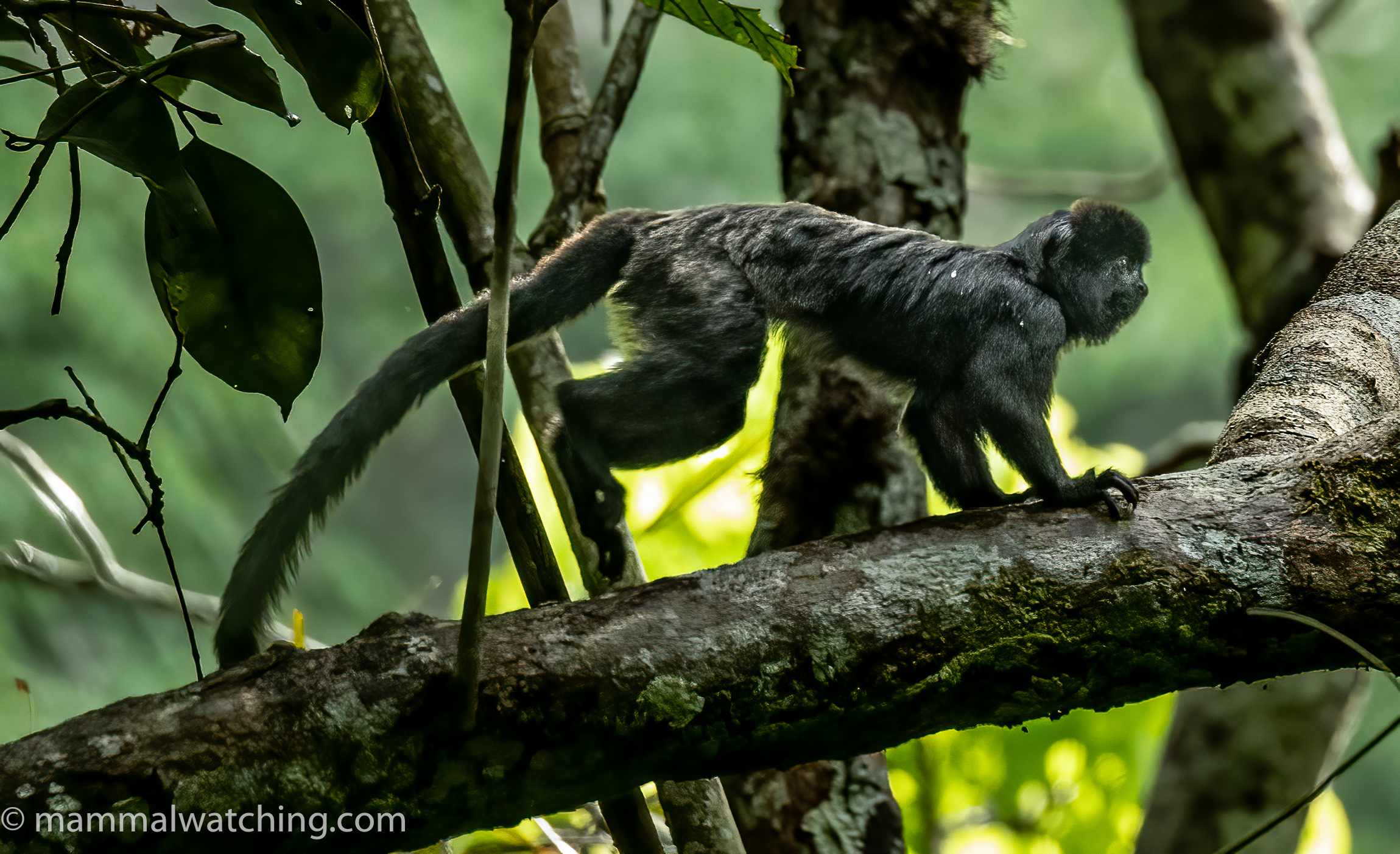
Bolivia – mainly monkeys, October 2024
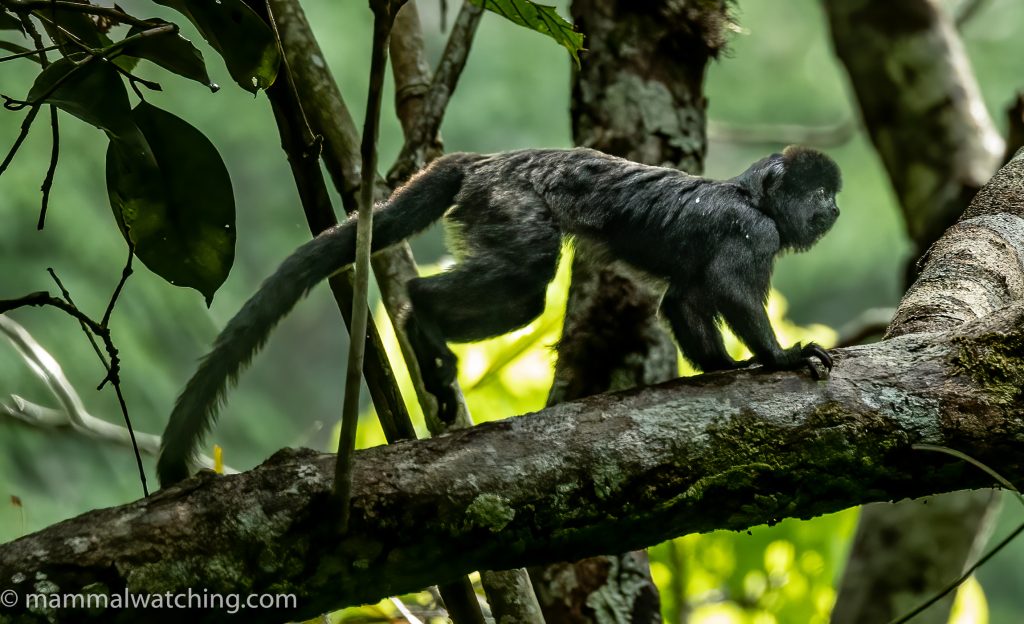
Goeldi’s Monkey (Callimico goeldii), Pando Department
Bolivia is a South American rising star. It offers world-class Jaguar viewing at a fraction of the cost of the Brazilian Pantanal, along with a range of other flagship Latin species. I can’t think of anywhere else where you can almost guarantee Jaguar, Puma, Jaguarundi and Ocelot in a couple of days. It also has a large slab of the Gran Chaco, Amazon rainforest and much more.
I had been contemplating a visit for a decade after I started chatting with Australian Nick McPhee who runs Nick’s Adventures Bolivia. But I had been to the Pantanal and Paraguay, and, good as Bolivia looked, I needed a few more potential lifers to get the country to the top of my wish list.
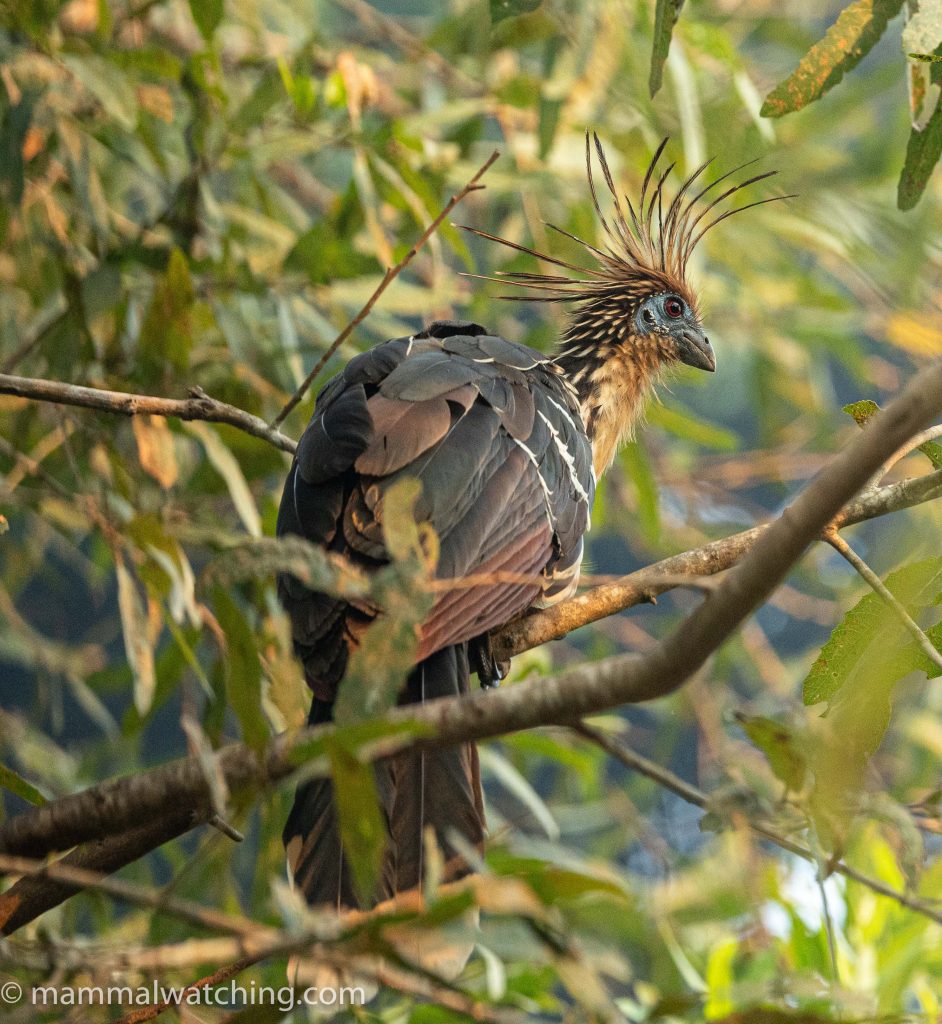
Hoatzin
If the big cats weren’t enough to tempt me,I knew Bolivia has some nice primates. Back in 2015 I had mentioned to Nick that if he could find a site for Goeldi’s Monkey we would be in business. And in 2021 Ian Thompson reported that a university research station – Estacion Biologica Tahuamanu – in Bolivia’s Pando Department, wedged between Peru and Brazil, might be a good site for the monkeys. Cheryl Antonucci and Justin Brown took a primate-centric trip in 2022 following in Ian’s footsteps in 2022. They saw a bunch of mammals including four near endemic titis plus, in Pando, Goeldi’s Monkey and Red-bellied Tamarins.
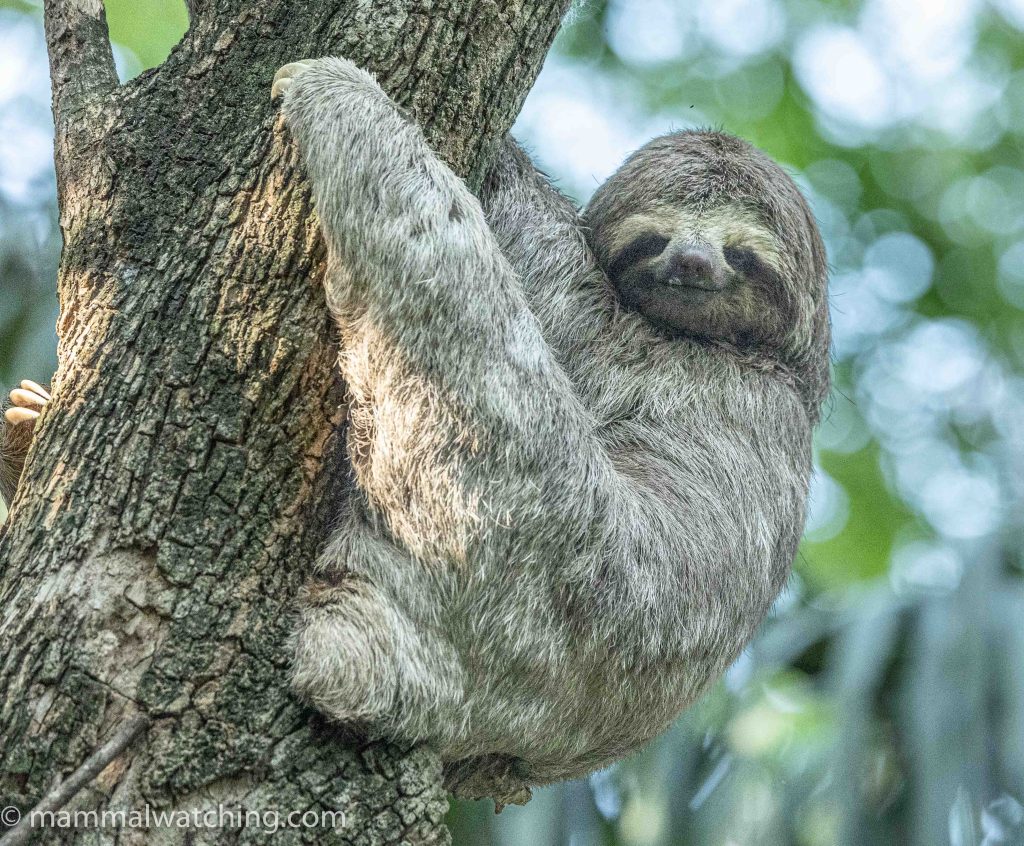
Brown-throated Three-toed Sloth (Bradypus variegatus), Santa Cruz
This was a tempting trip. But not quite as tempting as it would have been pre-COVID, because I had now realised that I’d already seen Goeldi’s Monkey.
During a patch of lockdown boredom I trawled through some mammal sighting loose ends and remembered a small black tamarin I had seen in Palmari Lodge in the western Amazon in 2006. I didn’t know what species it was but in 2020 I stumbled on a survey had recorded Goeldi’s very close to Palmari. Mystery solved. Nevertheless I still wanted a proper look at this wonderful money and with chances to look for several other new primates, Bolivian River Dolphins and more, plus getting to meet Nick, who was now a bit of legend, it was too good a trip to miss.
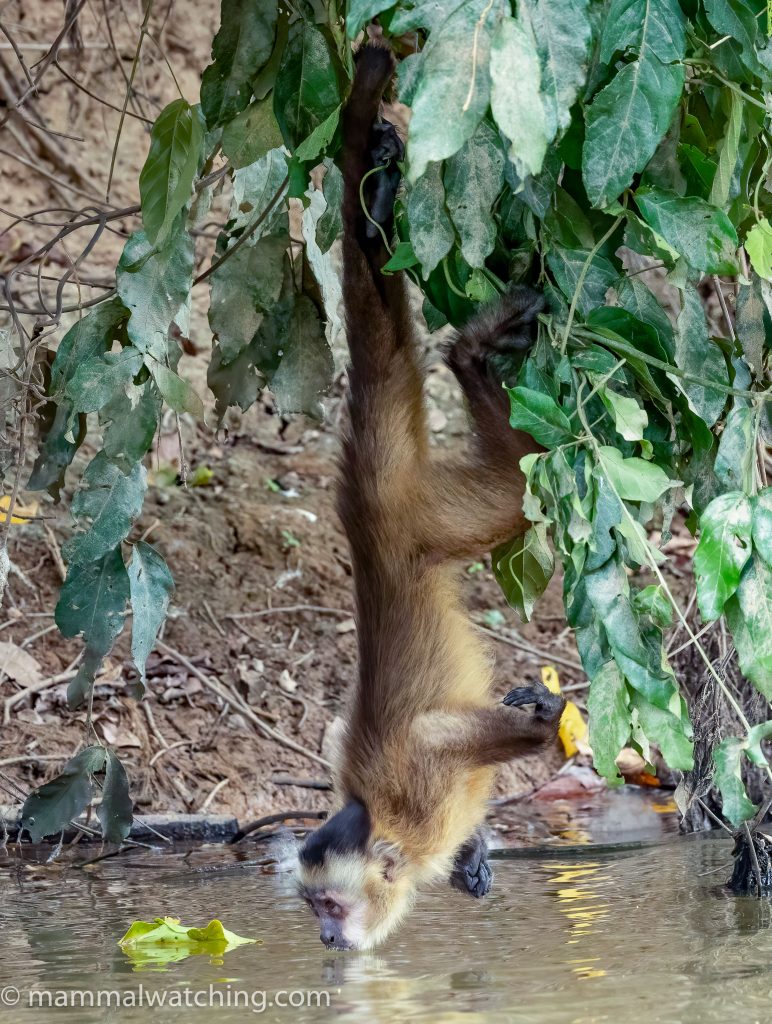
Brown Capuchin (Sapajus apella), Monte Carlo
So in October 2024 I arrived into Santa Cruz and met up with Kevin Bryan, Phil Davison, Alex Meyer and John Rogers for two weeks organised by Nick.
Itinerary
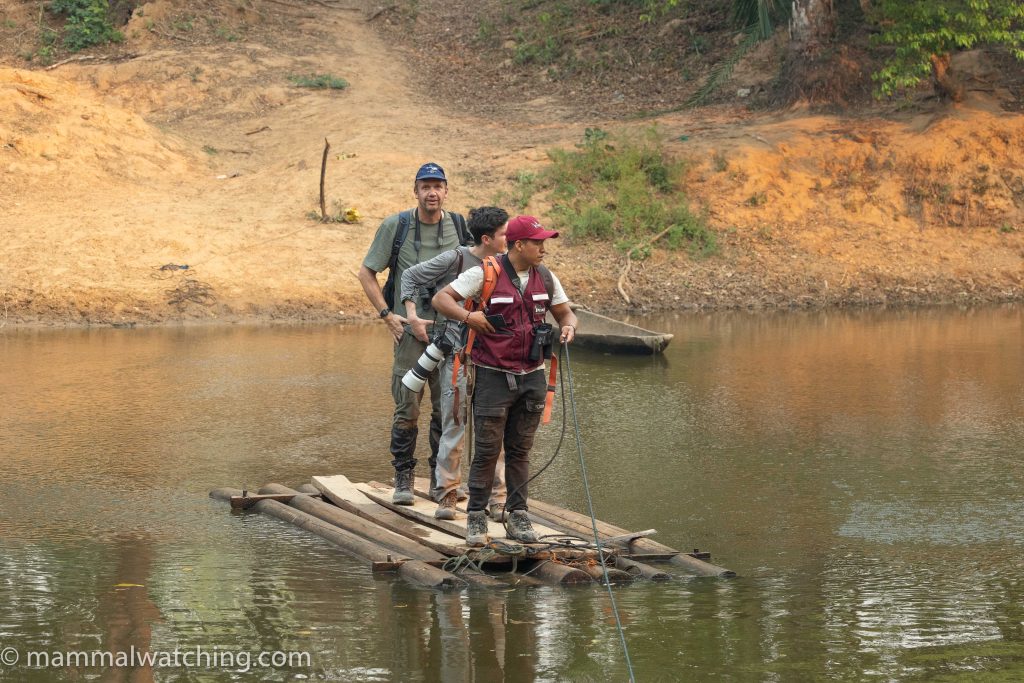
Nick and I designed the trip as an abbreviated version of Cheryl and Justin’s 2022 visit. I wanted to look for Goeldi’s Monkey and Red-bellied Tamarins in the Pando Region; White-eared Titis around Santa Cruz, and three other titi monkeys – Rio Beni, Madidi and Olalla’s – in the Beni Department. Nick recommended we drop the Madidi Titi from the menu as it would several days to the trip. More on this later.
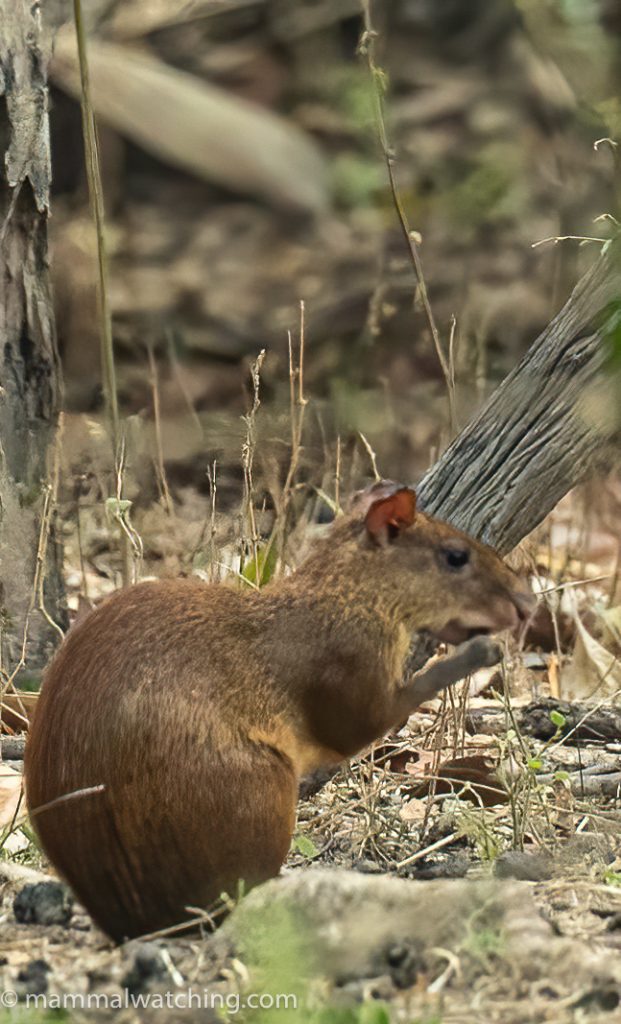
Brown Agouti (Dasyprocta variegata)
We would meet in Santa Cruz where would should easily find White-eared TIti.
From there we would fly to Trinidad and drive to the tiny settlement of Monte Carlo to look for Olallas’ Titi, and continue towards Rurrenabaque stopping for a night on the way to look for Rio BeniTiti.
From Rurrenabaque we would fly to Cobija on the border with Brazil and search for Goeldi’s Monkey and Red-bellied Tamarin at a university research station.
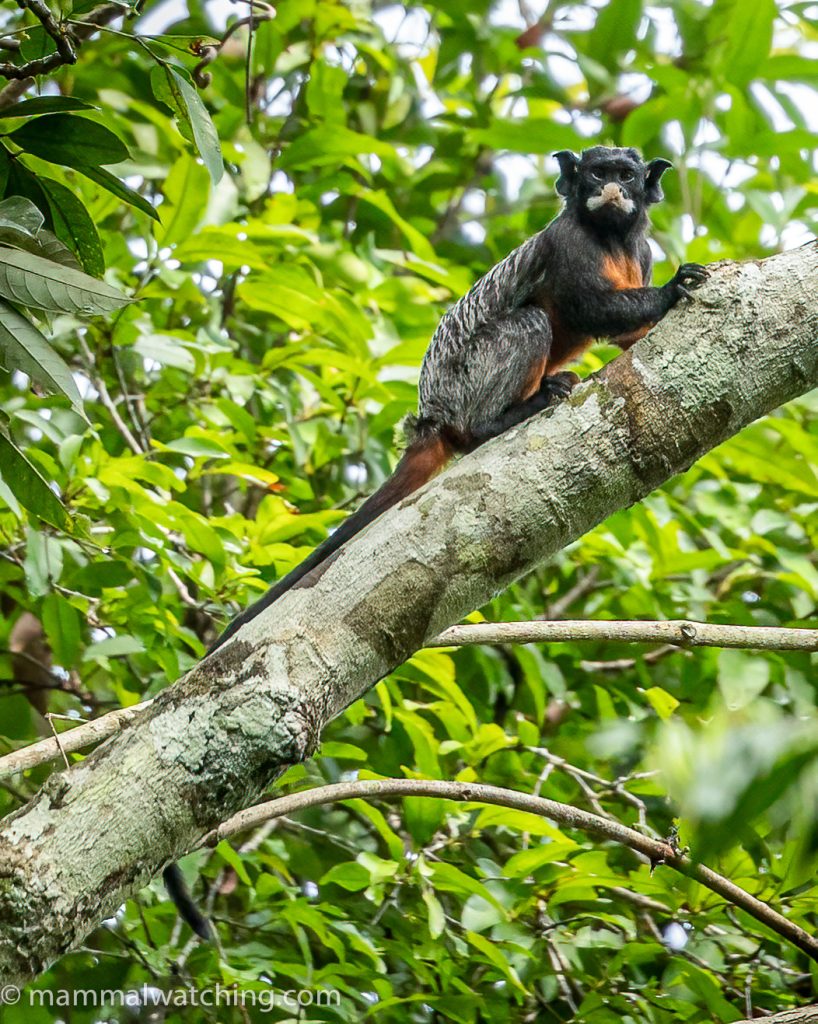
Red-bellied Tamarin (Saguinus labiatus)
Things did not go to plan.
Bolivia’s domestic airlines are not reliable, especially when a lot of the country is on fire, and the second leg of our first flight was cancelled. Instead of connecting to Trinidad we got stuck for a night in the city of Cochabmba. It wasn’t clear we could get to Trinidad the next day either: the airline blamed forest fires for the delays but a mob of angry passengers at the airport thought otherwise. I’ve no idea. So instead we flew to Rurrenabaque the next day and did the Beni part of the trip in reverse.
By comparison the Pando bit of the trip was plain sailing.
The Primates
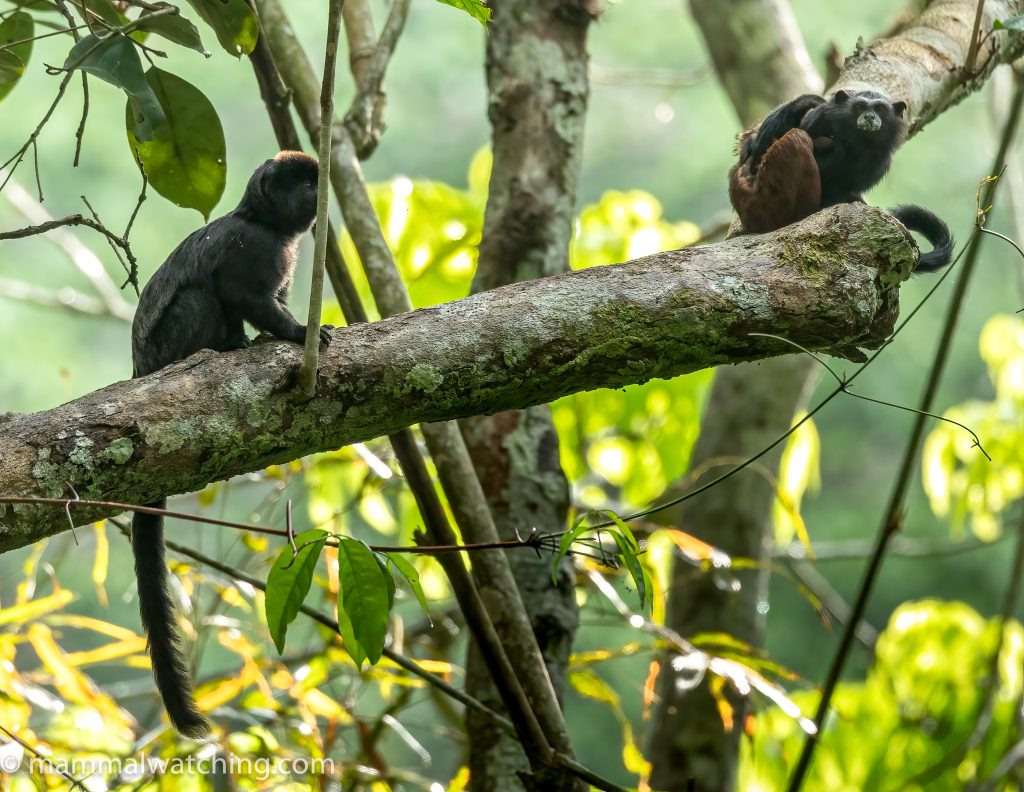
Goeldi’s Monkey (Callimico goeldii) (left) & Weddell’s Saddle-back Tamarin (Saguinus weddelli) (right)
This trip was designed around finding six primates in particular.
Four titi monkeys, two of which – Rio Beni and Olallas’ Tit Monkey – are endemic to Bolivia, and two of which – White-eared and Madidi Titi – are near endemics. The White-eared Titi also gets into western Brazil, while the Madidi Titi may get into southern Peru. Among these four primates the White-eared Titi is ‘easy’ to see near Santa Cruz. The other three species occur in the Beni Department. Rio Beni Titi is the easiest to find it seems. The other two can be tricky.
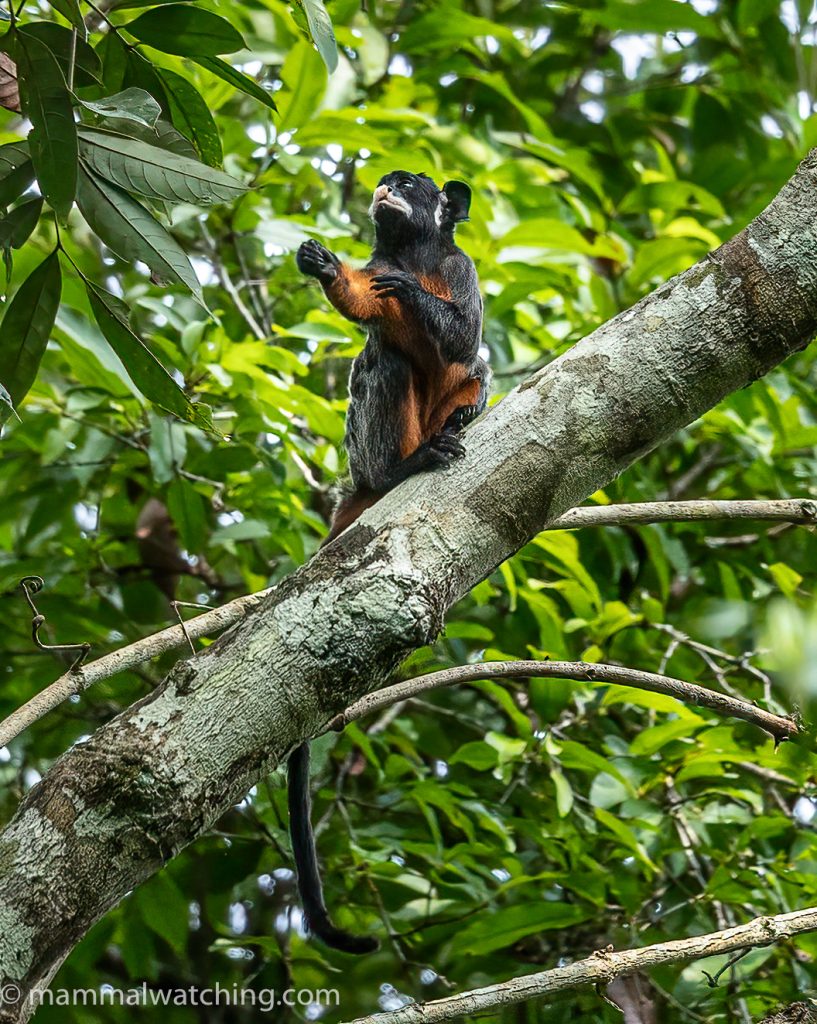
Red-bellied Tamarin (Saguinus labiatus)
The two other target primate were in the Pando Department. Red-bellied White-lipped Tamarins which occur along a belt of the Brazilian and Bolivian Amazon. And Goeldi’s Monkey, which although they live in Bolivia, Brazil, Peru and Colombia, are notoriously difficult to track down. They are patchily distributed and naturally rare, perhaps because they have quite specific habitat requirements. They are also very cool looking: someone described them as ‘mini gorillas’. Although I had had a brief look at one in Colombia I was wanted to have a chance to enjoy this species up close and personal.
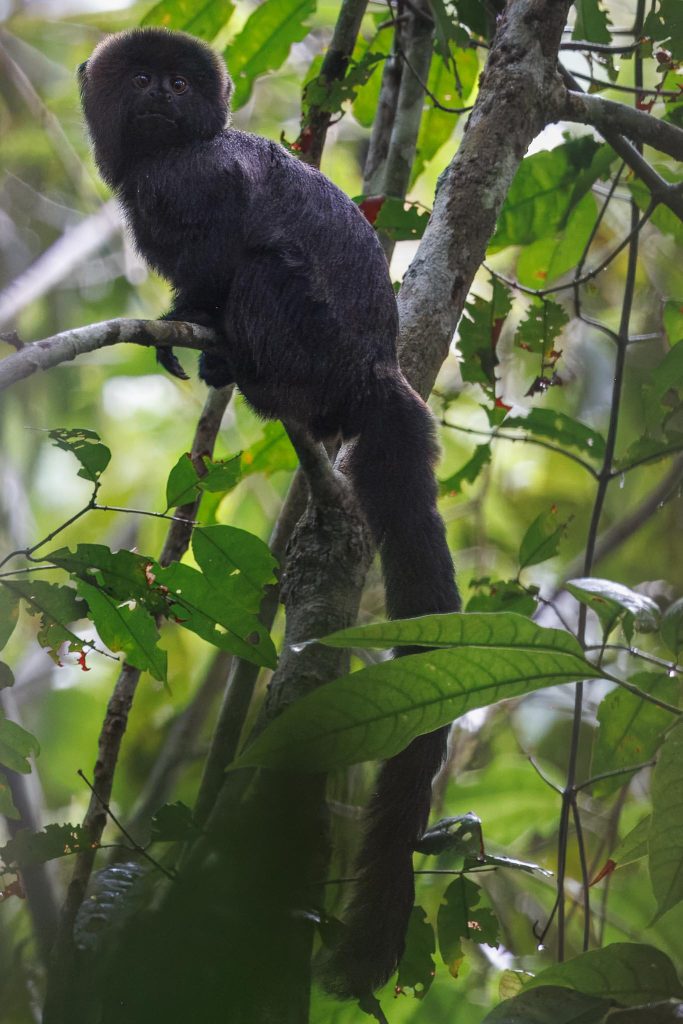
Goeldi’s Monkey (Callimico goeldii), John Rogers
Bolivia & Nick McPhee
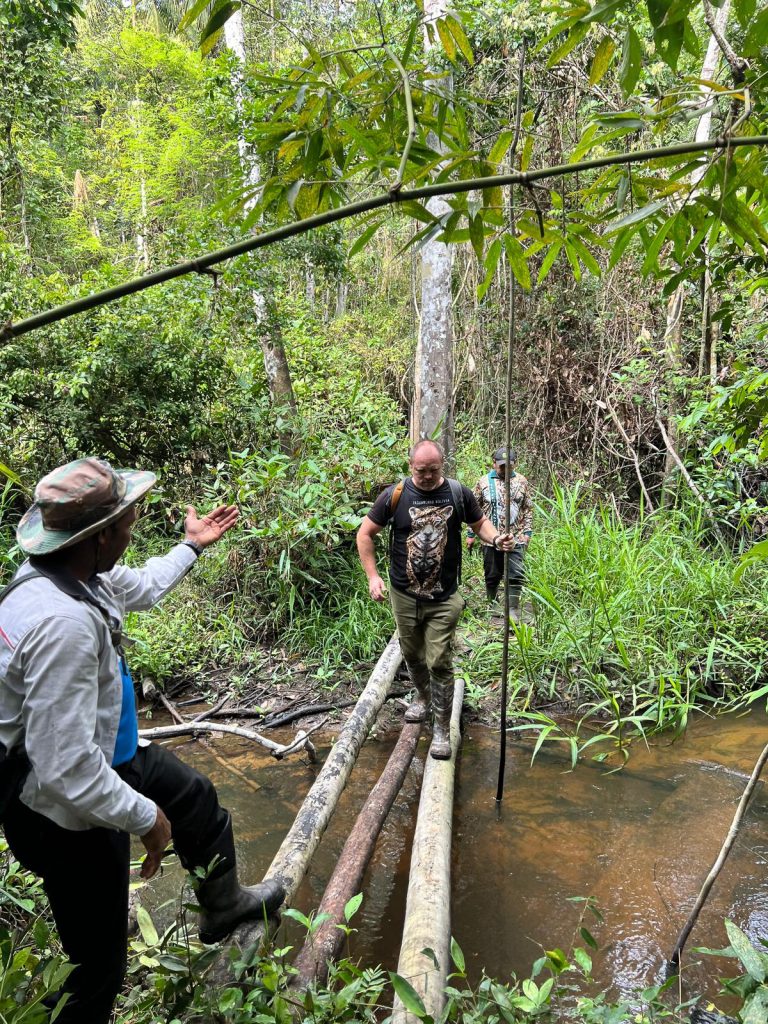
Nick McPhee
The fifth largest country in Latin America, Bolivia covers more than a million square kilometers. It has enormous ecological diversity, with Amazon, Pantanal, Chaco and Andean biomes. To my mind it deserves far more attention from mammalwatchers.
That said, I think it is fair to say the country is also in a bit of an environmental mess at the moment. In 2024 Bolivia lost 14 million hectares to fire, the worst year in its history. Climate change played a part but popular opninion has it that much of this was intentional and linked to the Bolivian government turning a blind eye to – or even encouraging – farmers to burn land to make way for agriculture.
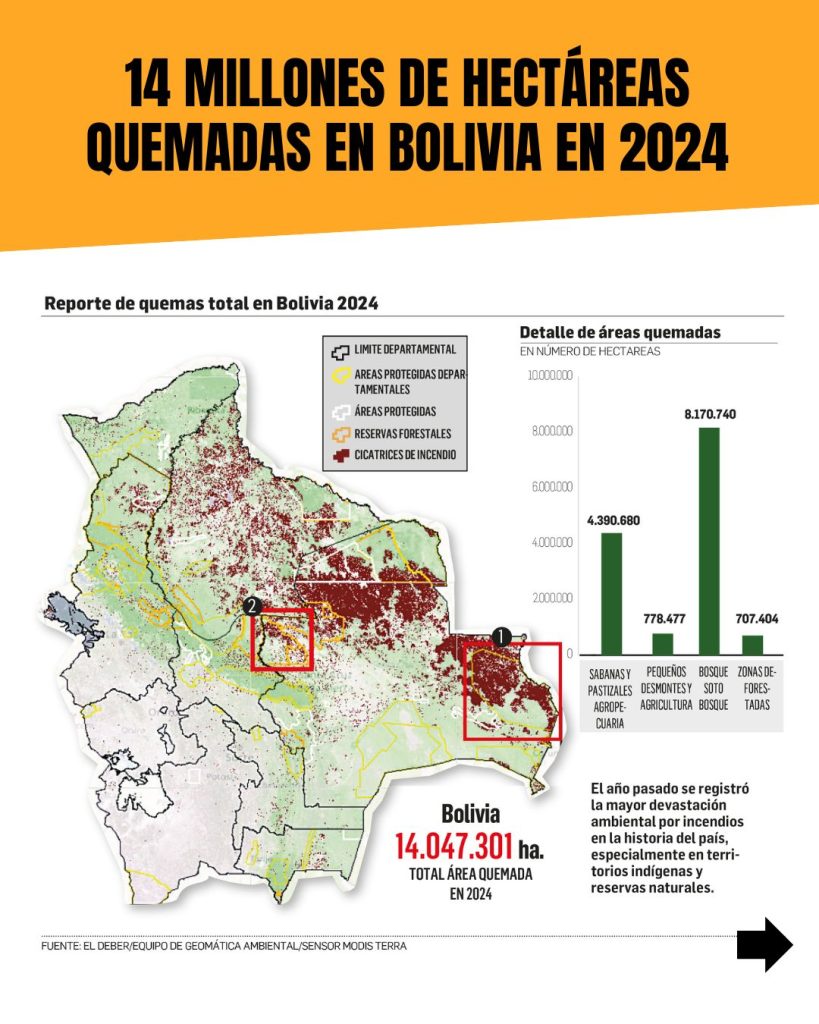
The smoke was thick in the air when we arrived in Santa Cruz. Nick showed us the photo below taken that week in ‘Jaguar Land’, a working farm where he runs some of his best cat tours. As you can see – if you look carefully – the smoke was so heavy that you could barely make out animals 30 meters away. An ecological disaster that seems to have had very little coverage in the western media.
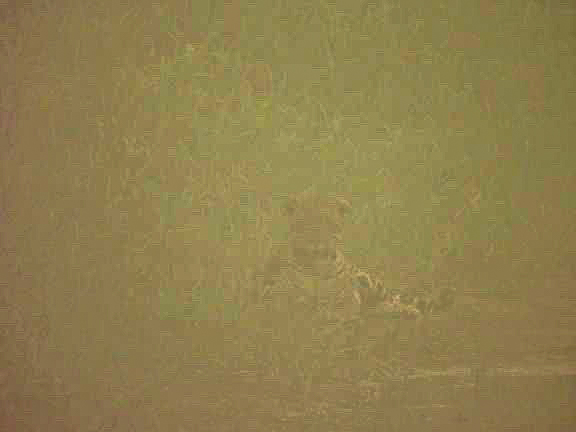
Jaguar through the smoke
Nick’s lived in Bolivia since 2012. He is has opened it up to mammalwatching and is outspokenly passionate about conservation. People who had travelled with Nick had described him to me as a ‘character’ that I would ‘definitely like’. Dead right! Nick is the closest thing to Steve Irwin (the Crocodile Hunter) since … well … since Steve Irwin. And I noticed the similarity well before I saw him charge after an anaconda.
Nick did a fantastic job with our trip, handling the logistics perfectly, even when we had to re-route the bits of our trip at the very last minute after our flights were cancelled. He joined us for the Pando leg of the tour and was great company. He was concerned we might miss our targets and equally concerned the supply of cold beer we run out. These are the correct priorities.
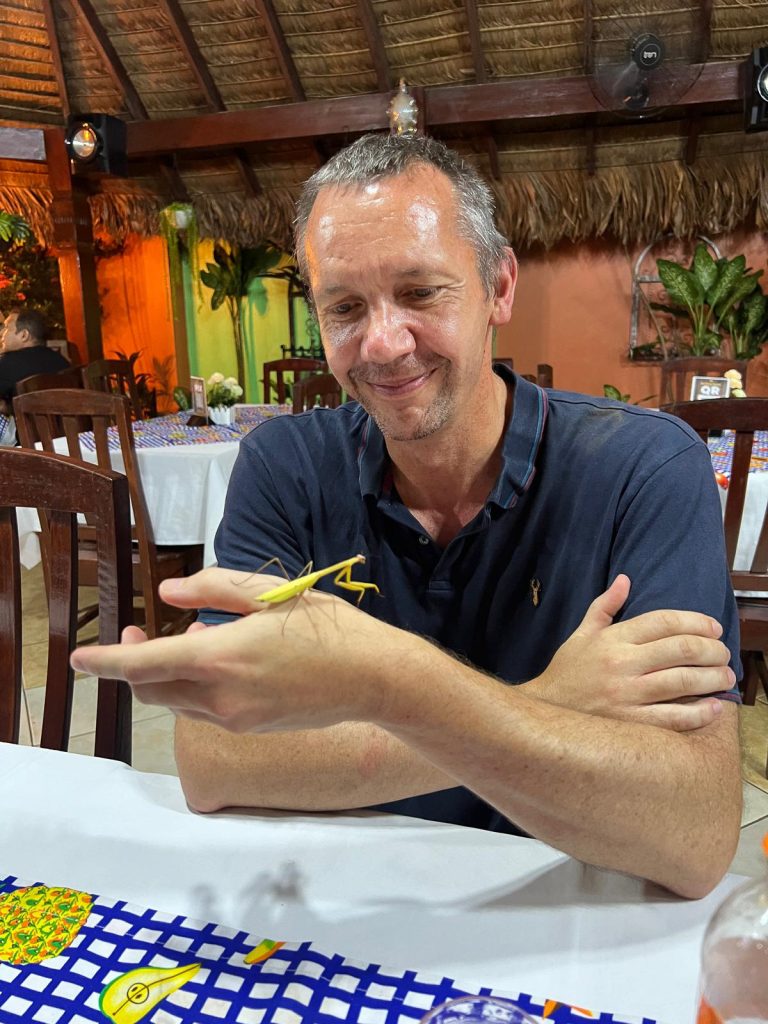
Phil contemplates an hors d’ouevre. Photo Alex Meyer
I cover the main areas below. But it is worth noting that we also spent half a day in La Paz plus an unplanned half day in Cochabamba. We looked for mammals in both places. We didn’t see any.
In Cochabamba we took a taxi up into the Andes an hour or so out of town. It was cold and wet. There were a few birds but not a sniff of a rodent. In La Paz Nick found – at very short notice – a biology student from the university who took us on a half day tour of the city, visiting places where he thought we might see a vizcacha or a cavy. It became clear that he had not looked for these species in a while – or perhaps ever – and most of the sites he took us too had been built on. La Paz is growing fast.
Santa Cruz de la Sierra
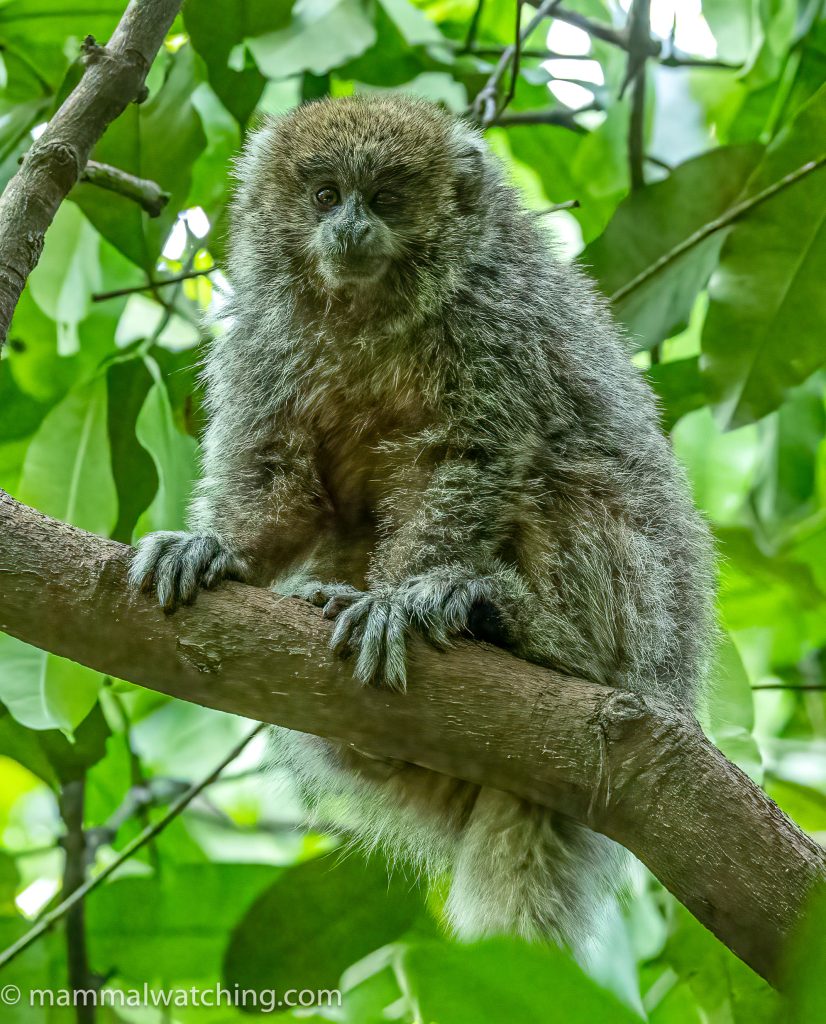
White-eared Titi (Plecturocebus donacophilus)
Until I went to book flights I thought Santa Cruz was a town in California. Turns out it is also Bolivia’s biggest city.
We spent a night here at the beginning and end of the tour. There may be some good restaurants but the real reason to visit is to see the endemic White-eared Titis, which are quite common close to the city. We visited Parque Ecológico Yvaga Guazú, a sort of small zoo attached to a private reserve an hour or so from our hotel. Wild titis live in the forest there and would be “very easy” to see. This is my least favorite piece of mammalwatching advice: it is often the kiss of death to anything being ‘easy’.
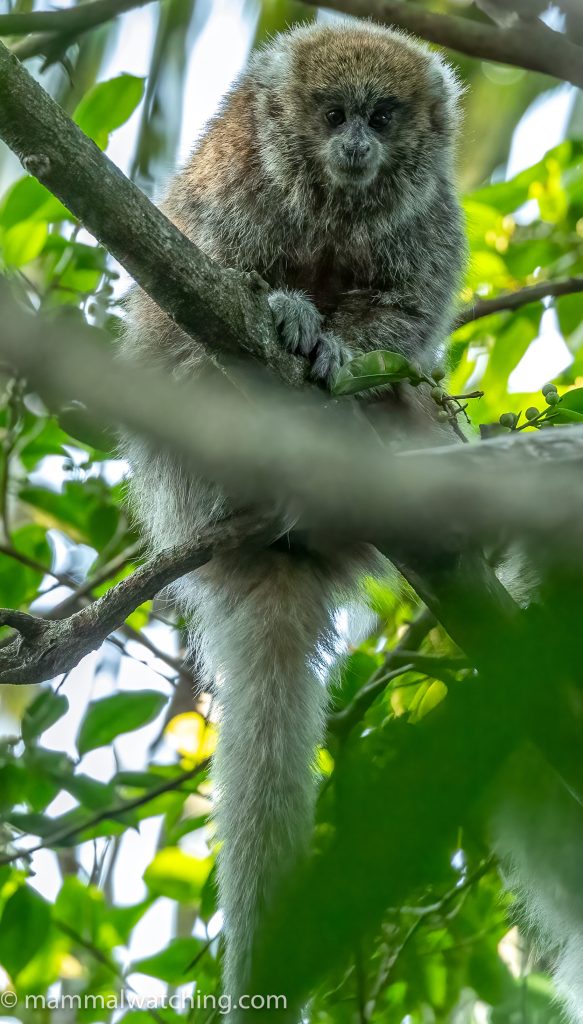
White-eared Titi (Plecturocebus donacophilus)
Sure enough it took us three hours of criss-crossing the small reserve to finally find the monkeys. By this time it was late afternoon and, yes, I was getting worried.
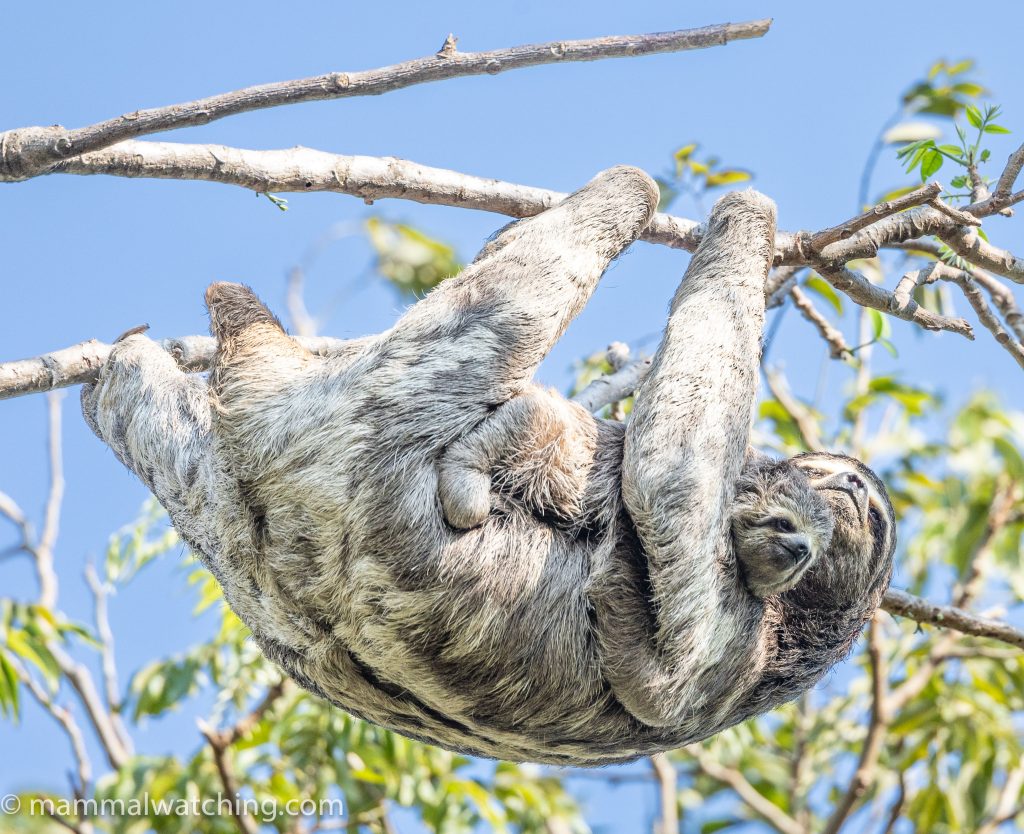
Brown-throated Three-toed Sloth (Bradypus variegatus) and baby
Three-toed Sloths were common.
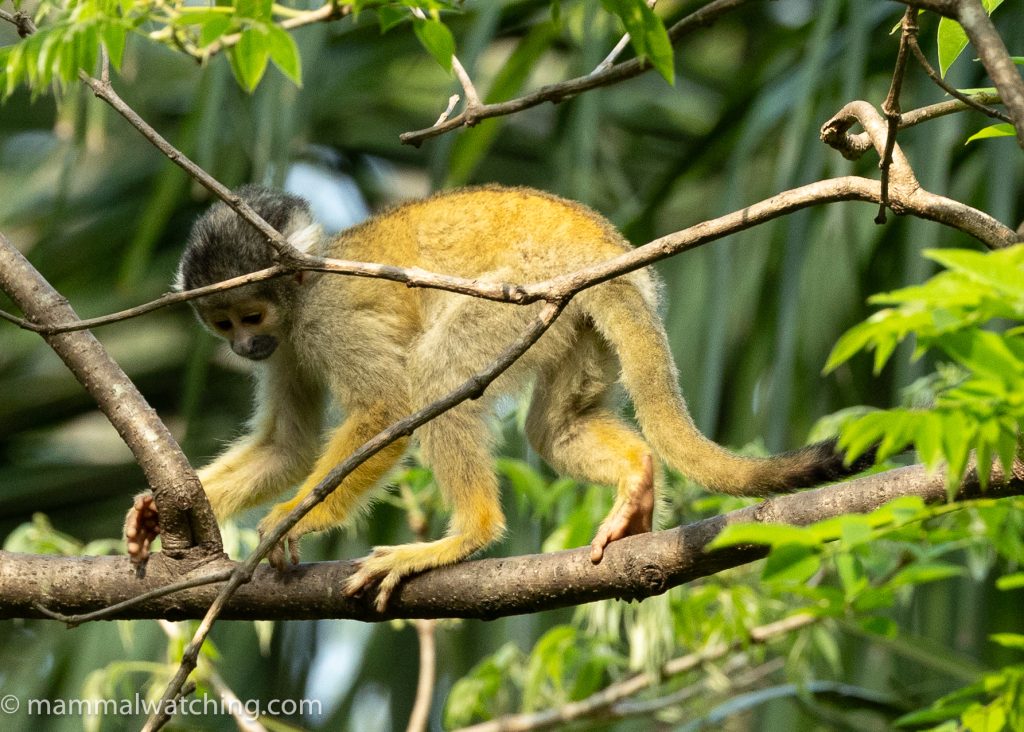
Black-capped Squirrel Monkey (Saimiri boliviensis)
As were Black-capped Squirrel Monkeys.
We also got our first – and only glimpse – of a Bolivian Squirrel here. Had I know we would not see more I would have tried a bit harder to get a better view an animal here, which was a lifer for us all.
Beni Department
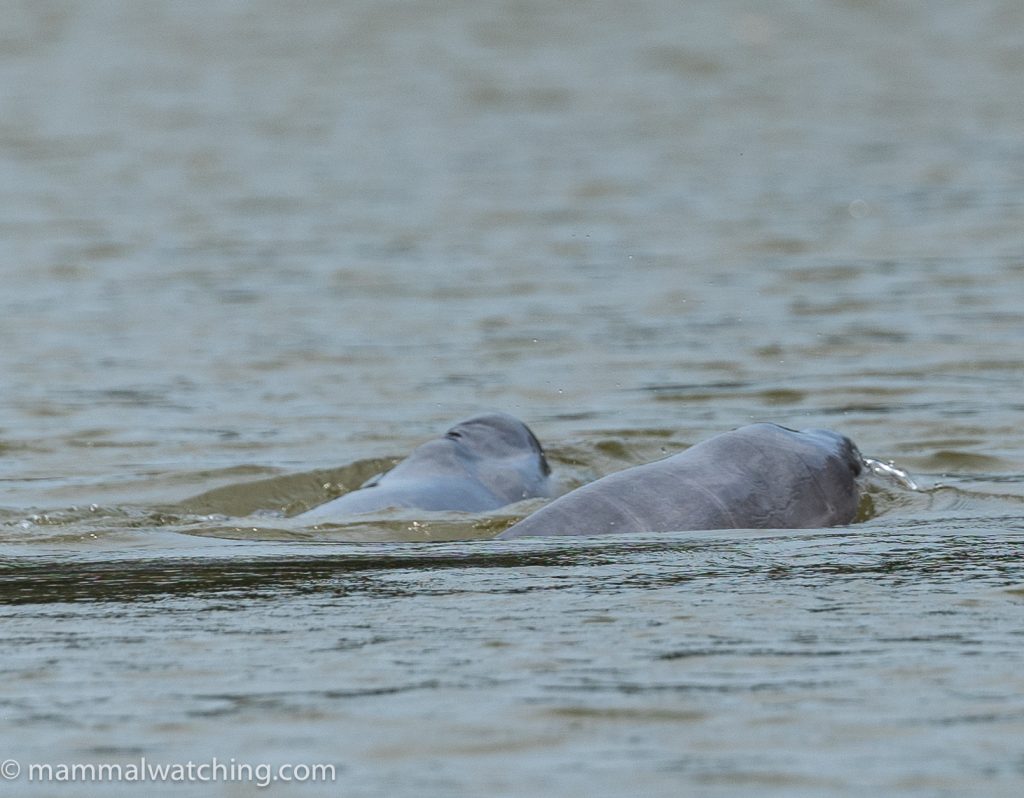
Bolivian River Dolphin (Inia boliviensis)
Santa Rosa
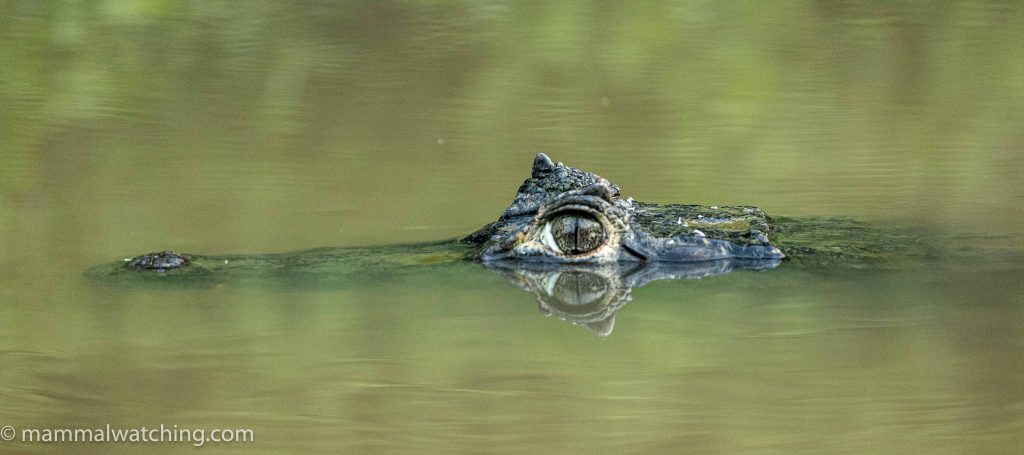
Caiman
After a cancelled flight – which almost provoked a riot in Cochabamba Airport – we flew to Rurrenabaque the next afternoon. Our guide – Julio – met us and two hours later we reached Laguna Bravo, a shallow lake which is often a good spot to see Bolivian River Dolphin, a recent split from the Boto. We were told dolphins usually swim around the jetty but we didn’t see any. Nor did we find them when we took a short boat trip out into the lake. The captain decided they must have moved to the far side of the laguna.
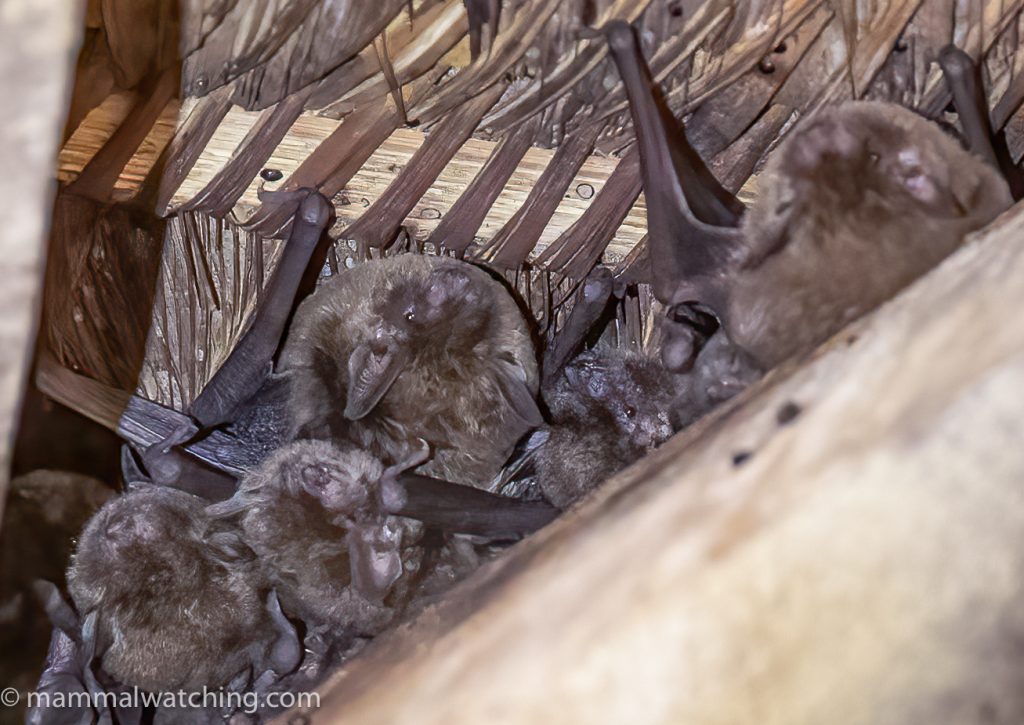
Myotis colony. Possibly Black Myotis (Myotis nigricans)
Alex spotted a colony of bats roosting high in the roof of the shelter at the jetty. They were too high to get decent photos but, though they looked quite big to me, look like a myotis species, quite possibly Common Black Myotis (thanks Fiona Reid and Jose Gabriel Martinez for the inputs!). There are few other options in range here that match these animals. But if you can think of one please let me know.
We gave up on the dolphins and drove to a small ecolodge that seemed abandoned and apparently was never opened. We arrived close to sunset to look for our target, the endemic Rio Beni Titi.
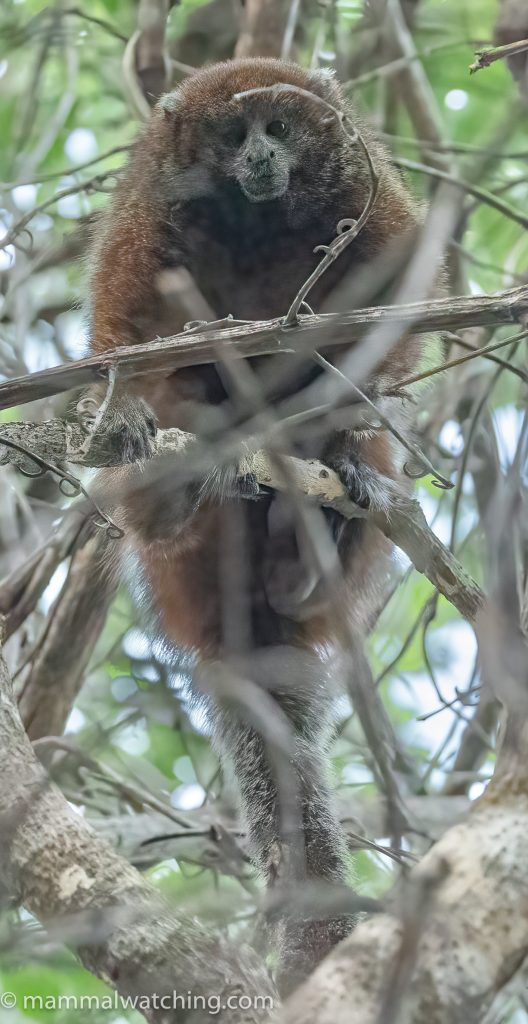
Rio Beni Titi (Plecturocebus modestus)
We were led though the grounds of the lodge and John spotted a family almost immediately at the start of the trail leading into the forest. I was walking ahead, and when he called for us to come back I may have said something a little too loudly along the lines of ‘this better hadn’t been a f*cking bird’.
I should not have doubted him. We had good views for 20 minutes despite the fading light.
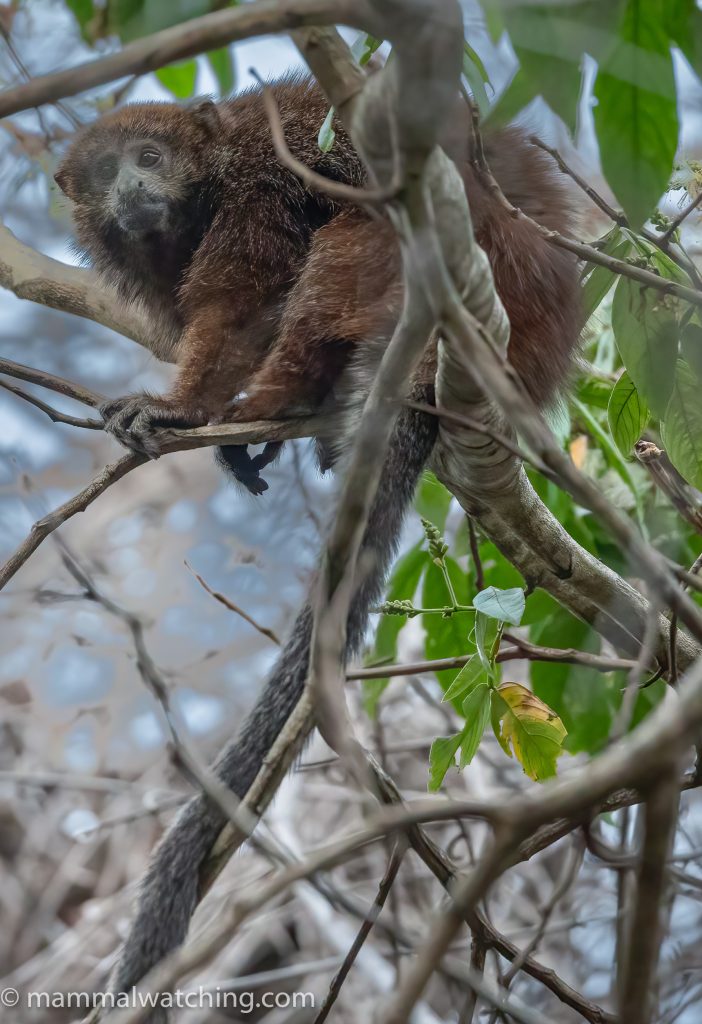
Rio Beni Titi (Plecturocebus modestus)
As an act of penance I made an effort that night to be interested in a pair of roosting potoos. I even took photographs! They were perfectly posed. We also saw some unidentifiable myotis bats peeping through the cracks of a roof.
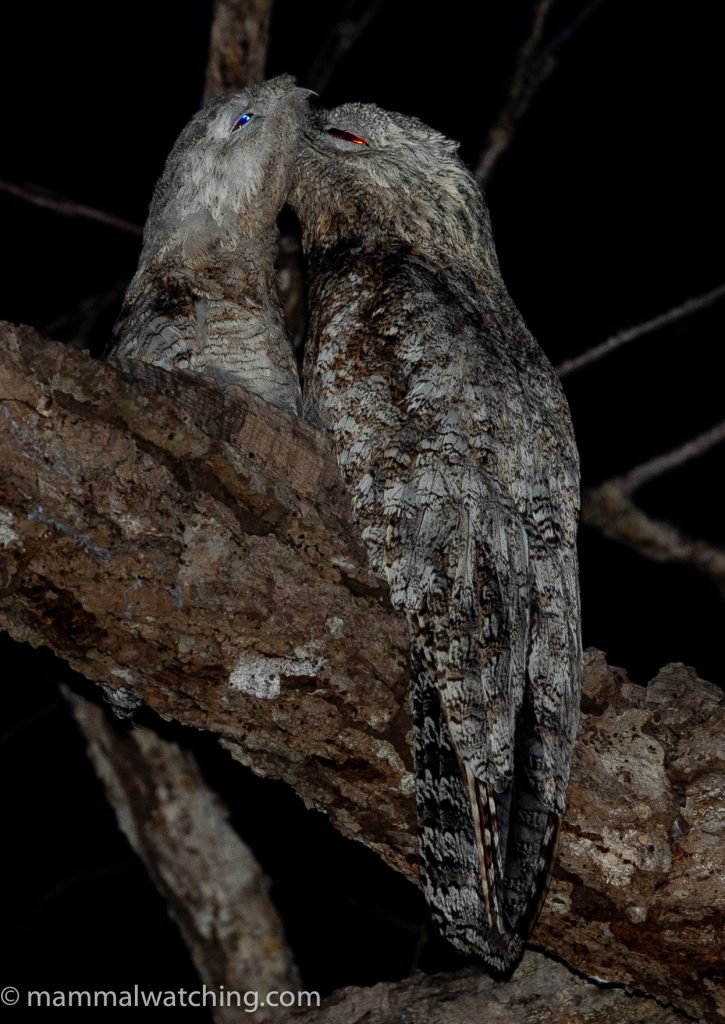
Long-tailed Potoos
We spent the night at a simple and comfortable ecolodge nearby: Las Tortugas.
A night walk after dinner produced two Northern Black-eared Opossums and a South American Coati.
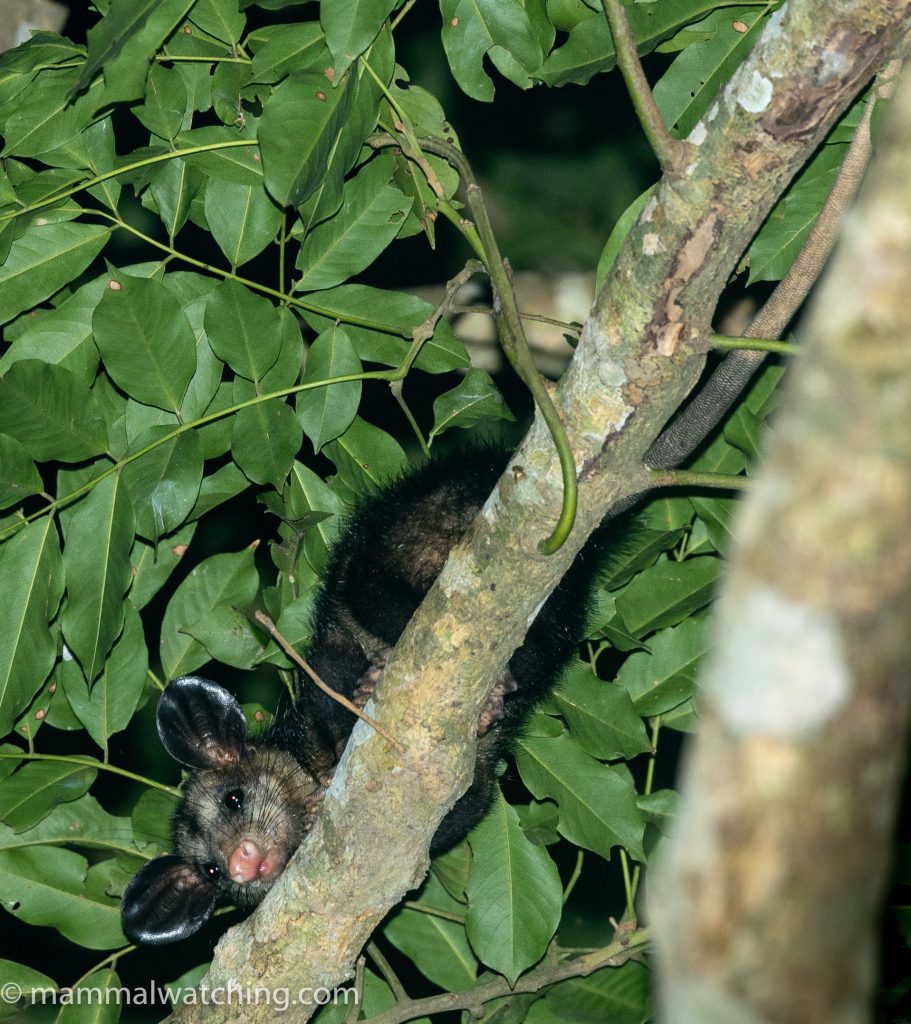
Northern Black-eared Opossum (Didelphis marsupialis)
Along with this Long-tailed Porcupine.
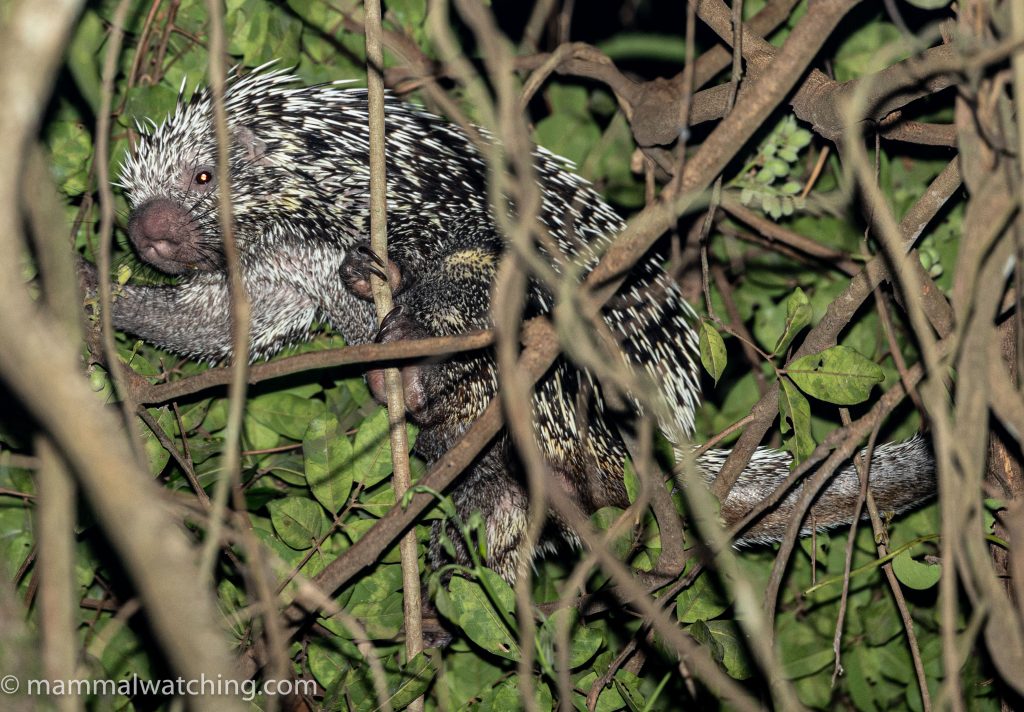
Amazonian Long-tailed Porcupine (Coendou longicaudatus)
At dawn we hopped into a canoe trip to explore the river behind the lodge. October is the very height of the dry season and the water was so low tthat a river dolphin was – we were told – trapped in a short stretch of river. It should be easy to see.
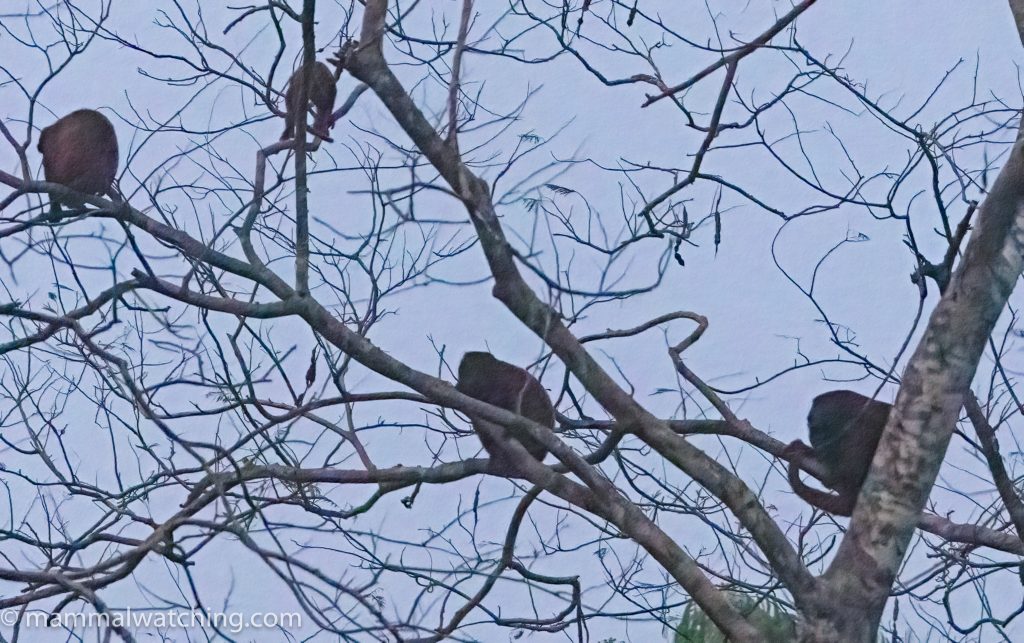
Bolivian Red Howler (Alouatta sara)
A group of Bolivian Red Howlers were roosting next to the lodge at dawn..
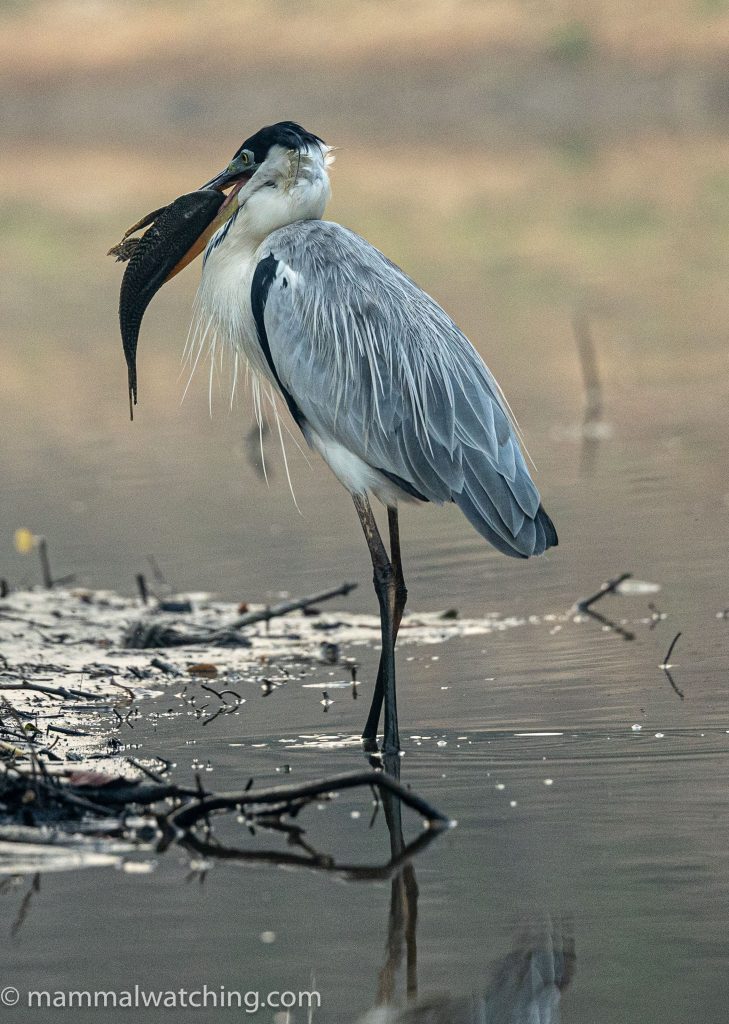
Cocoi Heron
The river was spectacular: packed full with an extraordinary density of wildlife, mainly caiman, birds and capybara.
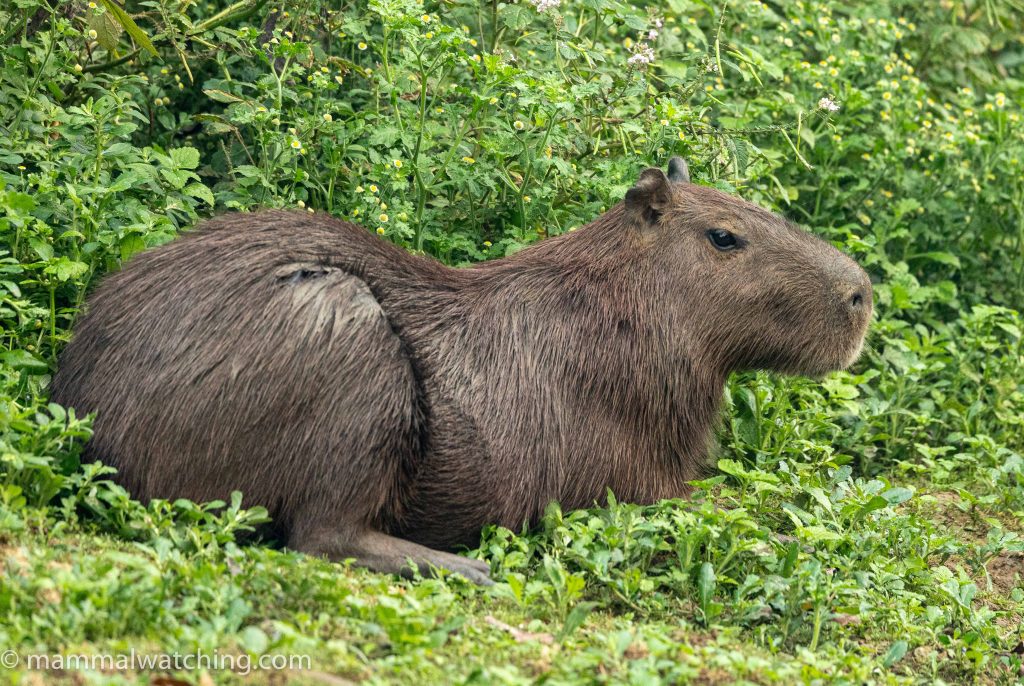
Greater Capybara (Hydrochoerus hydrochaeris)
And one caiman eating a bird.
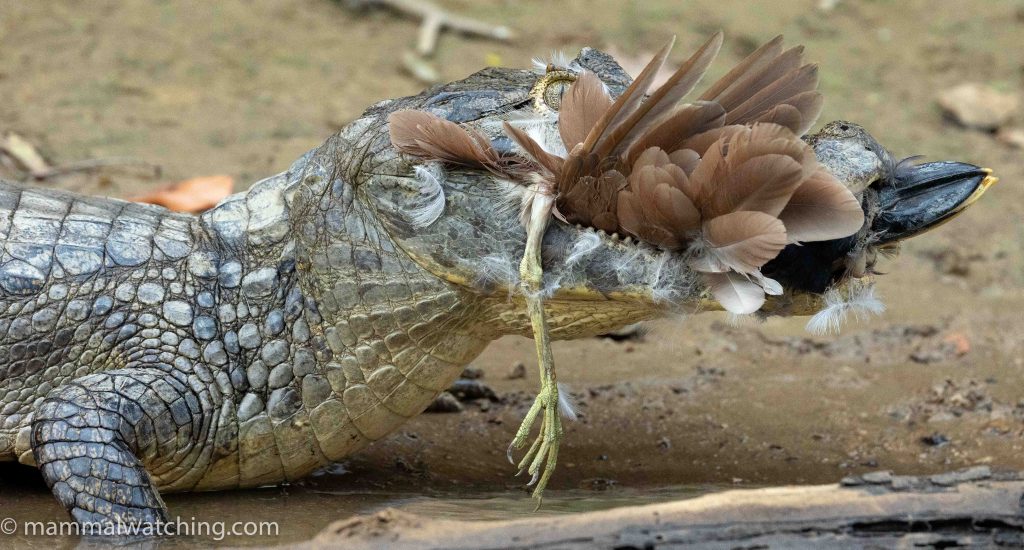
Boat-billed Heron sandwich
Alex saw a Brown Agouti briefly, and then we found the dolphin. It seemed to be avoiding the canoe so photography was a challenge but we saw it surface several times.
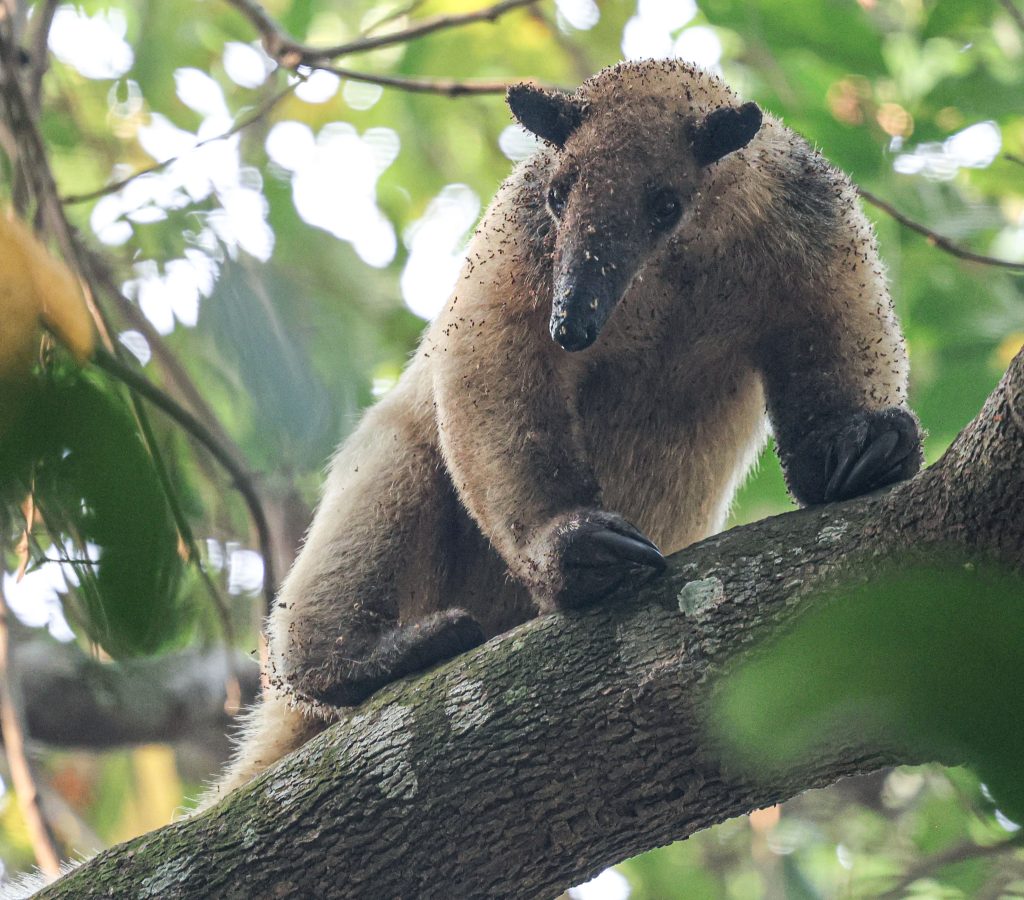
Southern Tamandua (Tamandua tetradactyla). Photo Alex Meyer
As we were arriving back at the lodge at 8am Kevin spotted a Southern Tamandua raiding an ant nest across the river which was fun to watch.
Monte Carlo
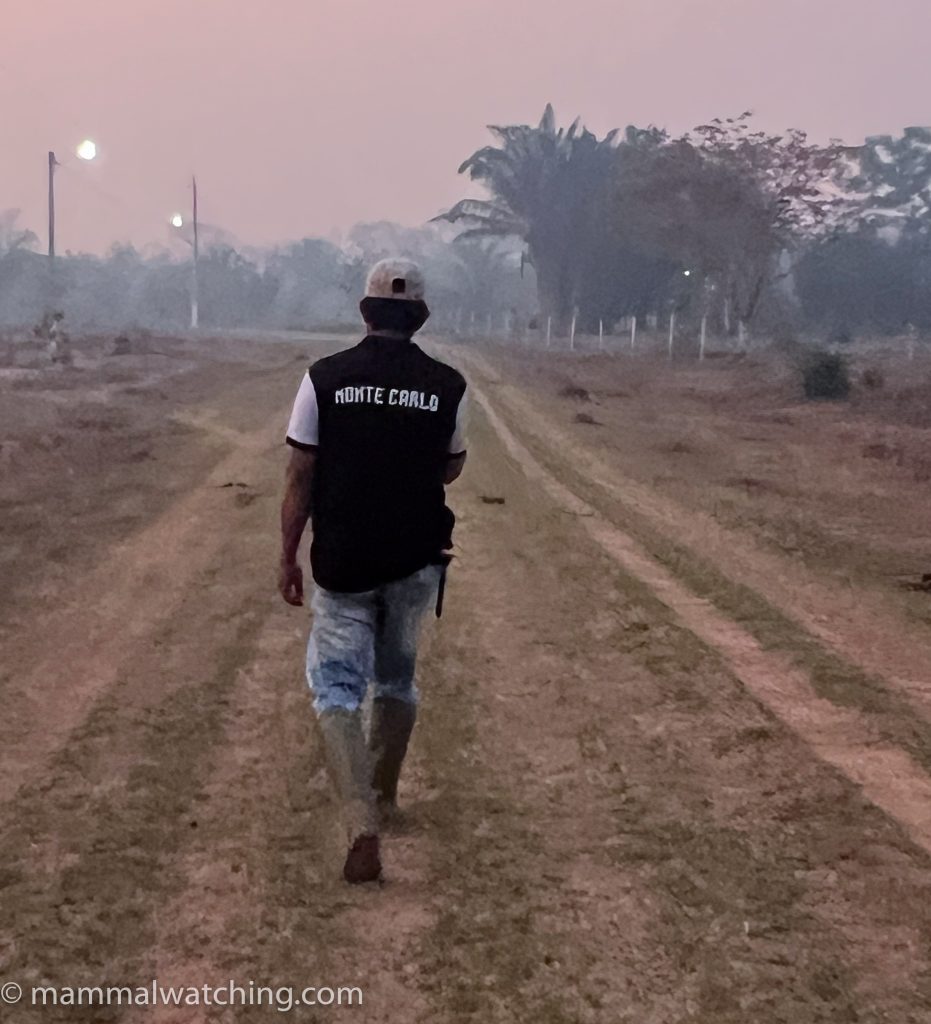
With the monkeys and dolphin under our belts we were back on schedule and had two days to look for the more difficult Olallas’ Titi, or – as I believe they ought soon to be called – the ‘Oh La La’ Titi. This is a hard monkey to find and the best area Nick knows is around the tiny community of Monte Carlo.
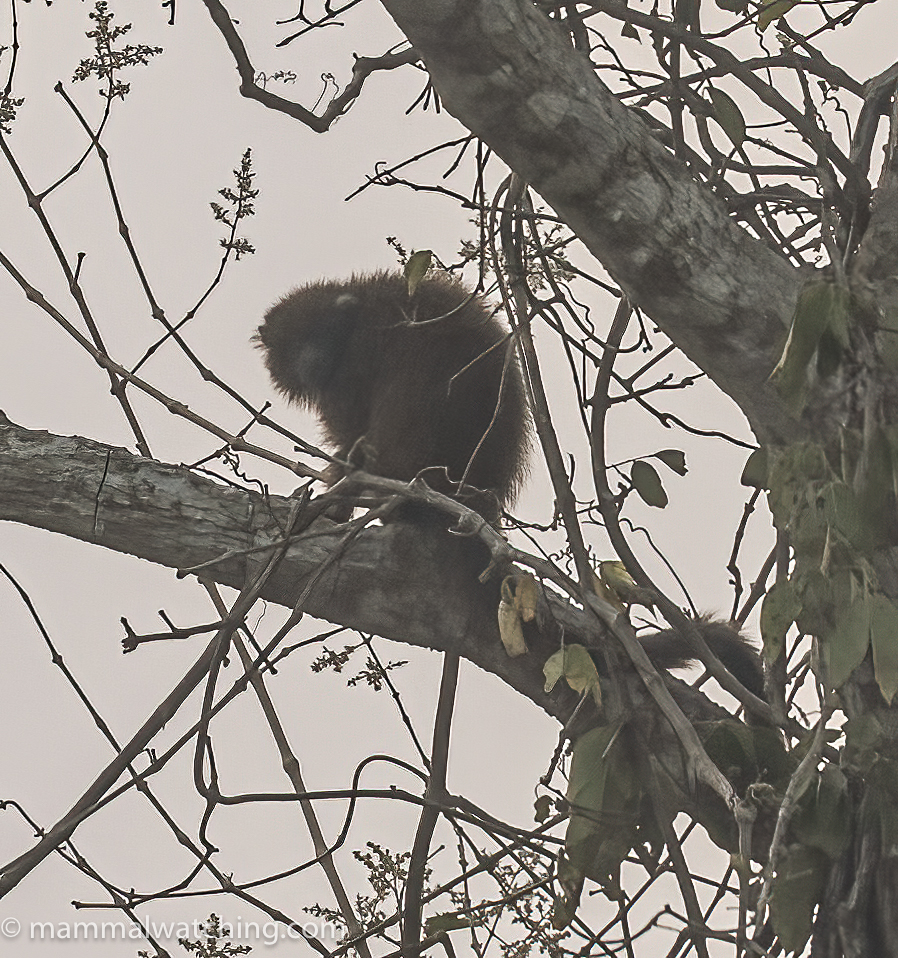
Olallas’ Titi (Plecturocebus olallae)
This is a remote area and opinions varied considerably on how long the drive would take. It ended up taking about 6 hours, considerably quicker than expected. We drove on dirt roads through interesting country, most of which was private ranch land. There was plenty of wildlife. Nick has seen some nice animals along these roads. We saw plenty of birds and some capybara, but nothing too exciting.
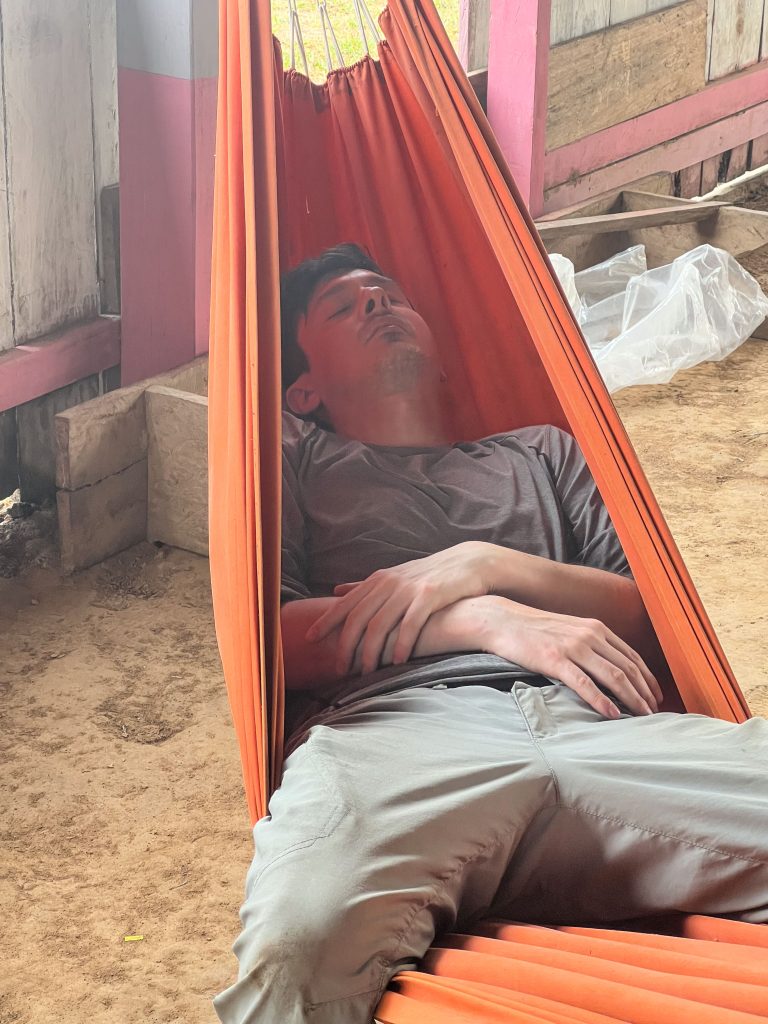
Alex deep in thought
We spent two nights in Monte Carlo, camping under a large open sided communal shelter.
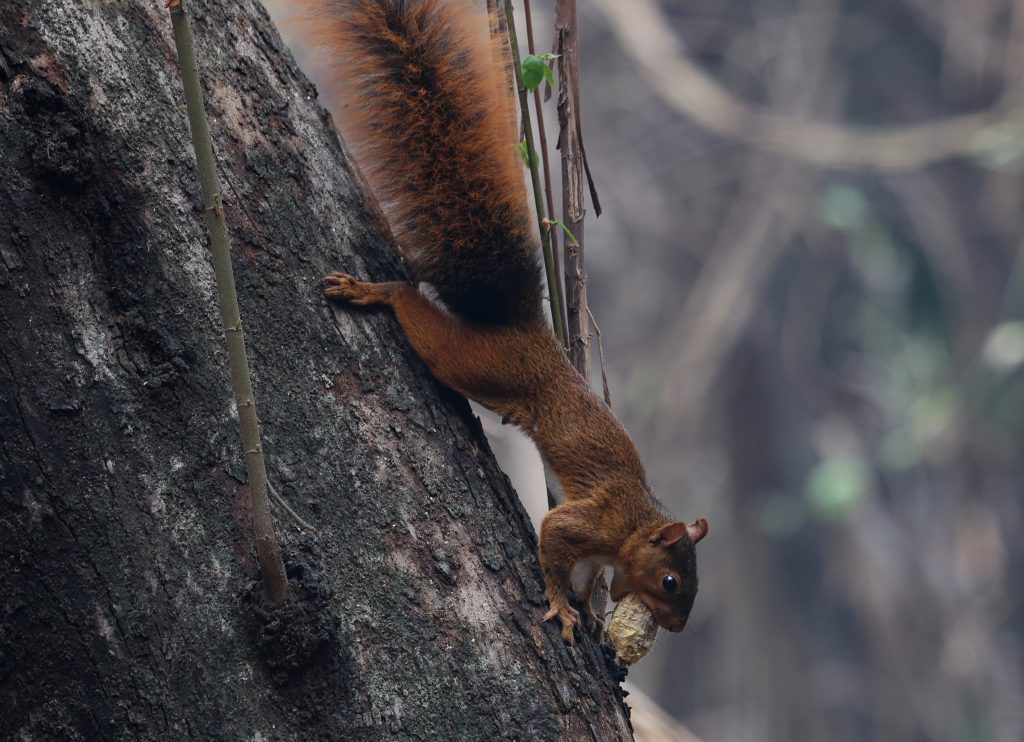
Southern Amazon Red Squirrel (Sciurus spadiceus). Photo Alex Meyer
We had excellent local guides, who got into looking for bats and rats as well as the monkeys and other mammals. Although we lost our second afternoon and evening to heavy rain, we went out before dawn the next day to make up for it. We spent most of our time walking through forest patches around the village and took two leaky canoes out for a few hours to look for river dolphins.
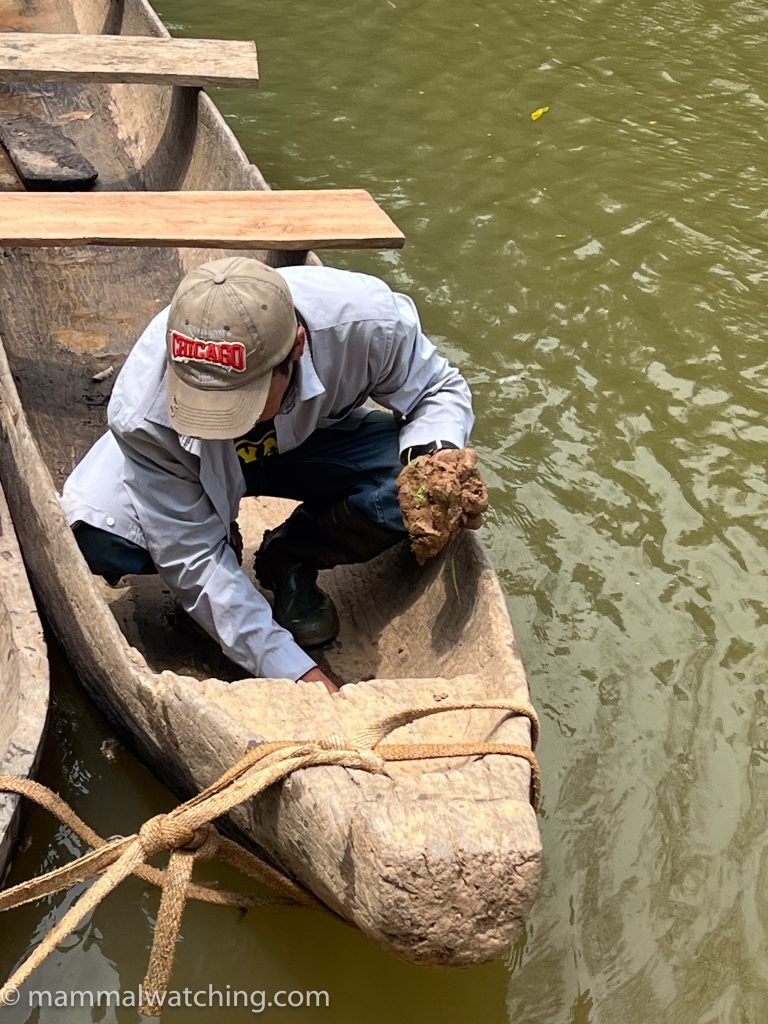
Canoe repairs
We saw the following mammals.
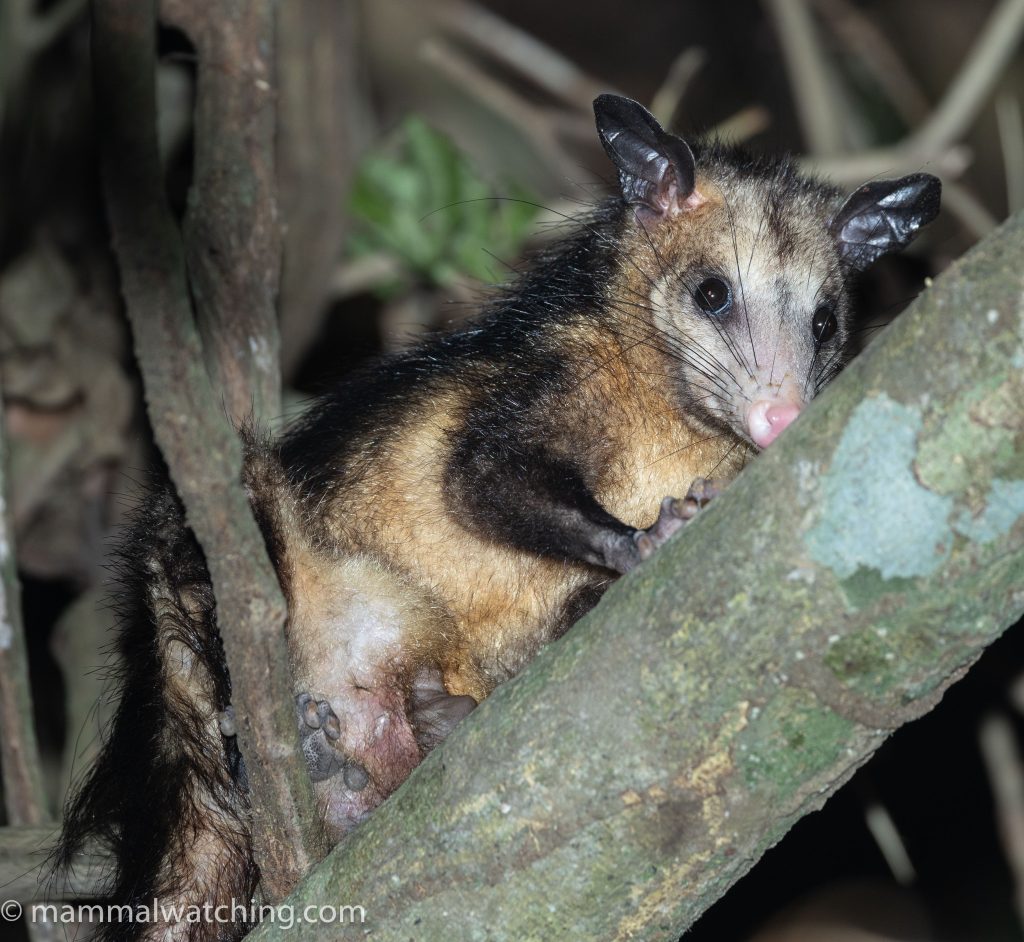
Northern Black-eared Opossum (Didelphis marsupialis)
Northern Black-eared Opossum (Didelphis marsupialis): one at night in the forest.
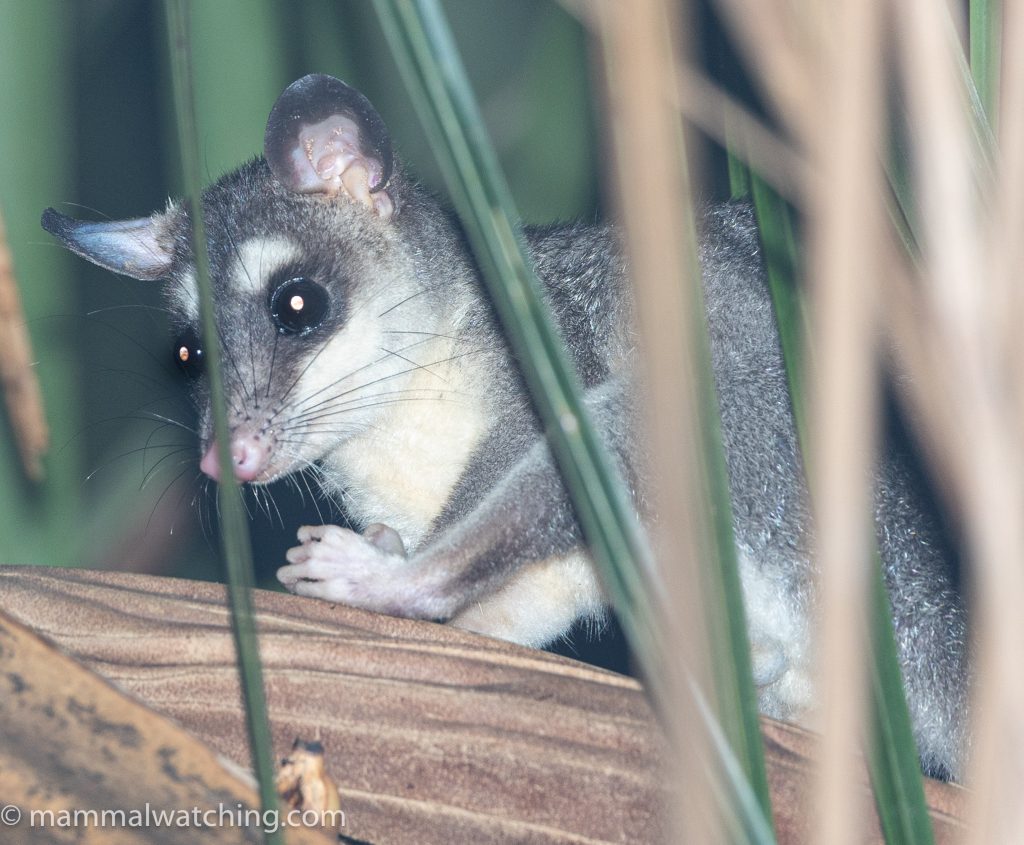
Common Four-eyed Opossum (Philander canus)
Common Four-eyed Opossum (Philander canus): one pre-dawn in the forest. I got quite excited at the possibility this was an Olrog’s Grey Four-eyed Opossum, which was known from this area based on a few specimens. But with some more research I see that that opossum has been discontinued and lumped back in with Philander canus.
Azara’s Night Monkey (Aotus azarae): one at night.in the forest.
Bolivian Red Howler (Alouatta sara): several troops in the forest
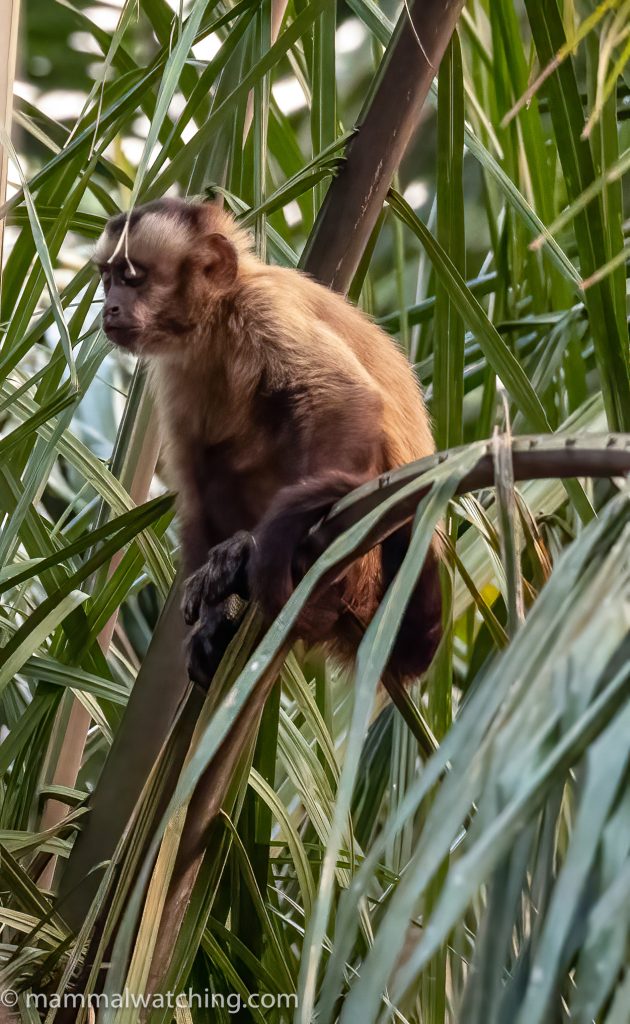
Brown Capuchin (Sapajus apella)
Brown Capuchin (Sapajus apella): common in the forest and along the river.
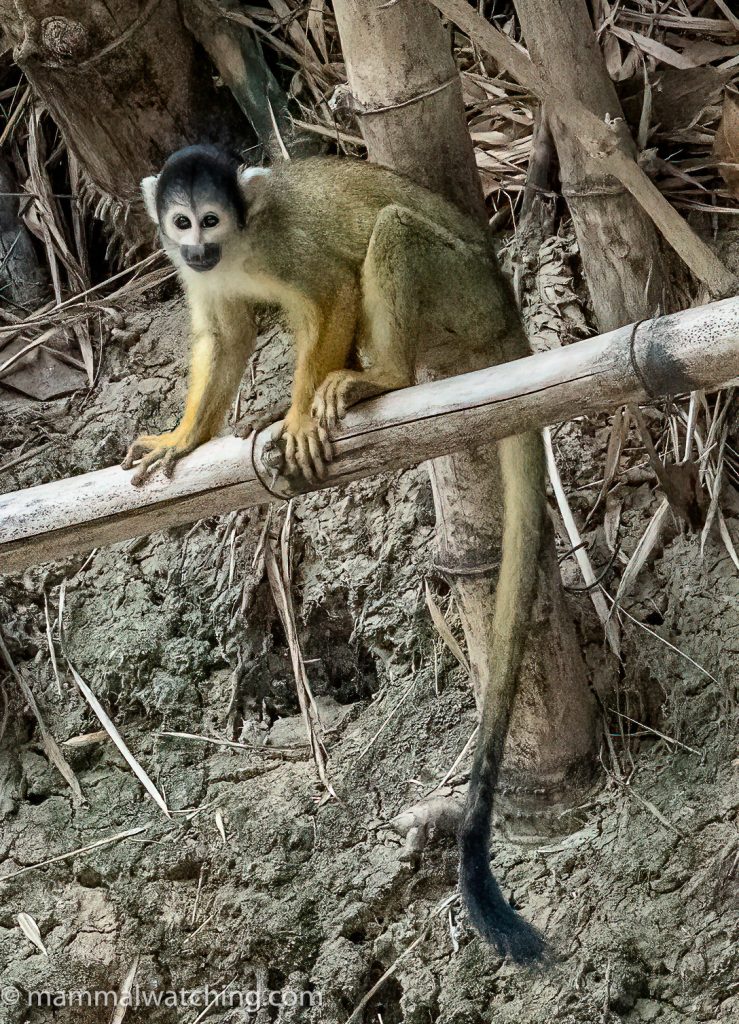
Black-capped Squirrel Monkey (Saimiri boliviensis)
Black-capped Squirrel Monkey (Saimiri boliviensis): common along the river and in the forest.
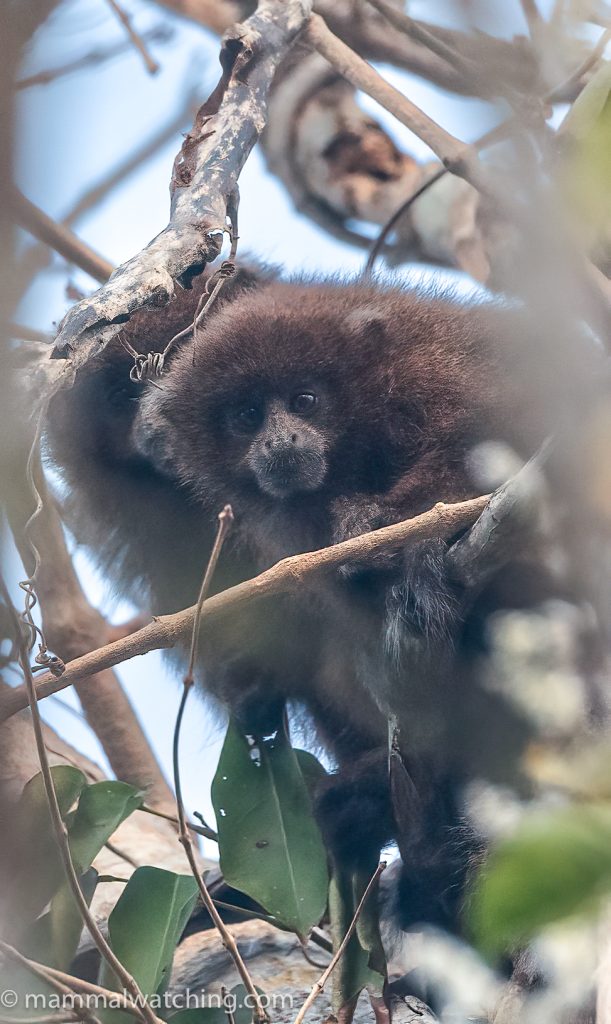
Olallas’ Titi (Plecturocebus olallae)
Olallas’ Titi (Plecturocebus olallae): we saw a family – probably the same family – early on both mornings. I think we were lucky to find them so easily as others have missed them here. They did not vocalize much and were shy.
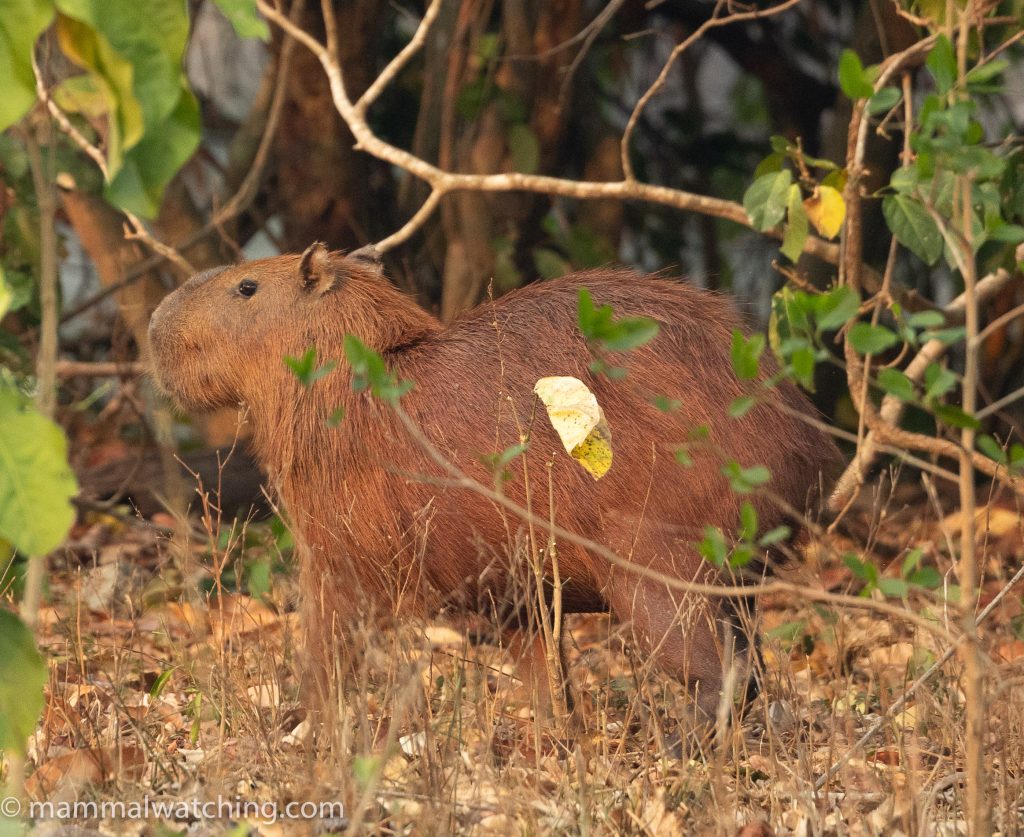
Greater Capybara (Hydrochoerus hydrochaeris)
Greater Capybara (Hydrochoerus hydrochaeris): one or two on the edge of the village.
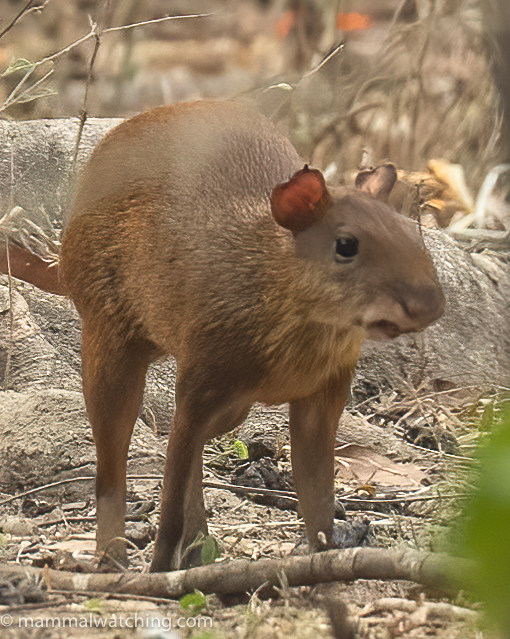
Brown Agouti (Dasyprocta variegata)
Brown Agouti (Dasyprocta variegata): a couple in farmland around the village edge.
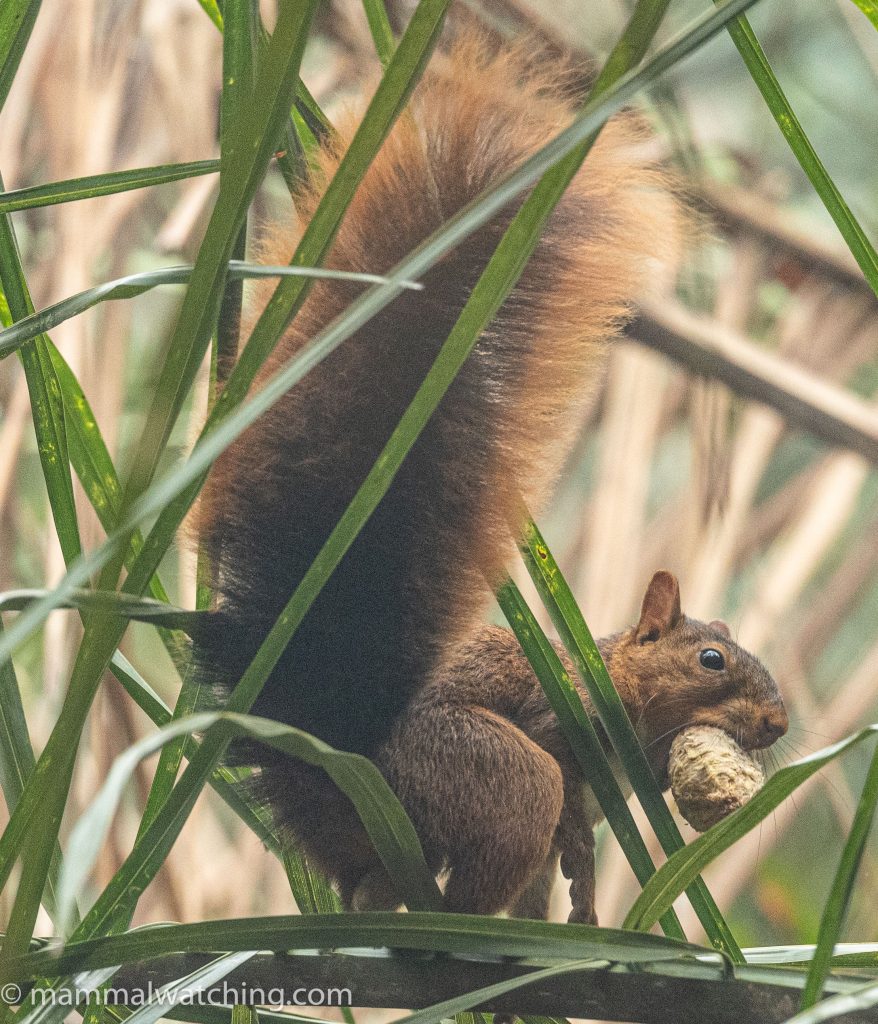
Southern Amazon Red Squirrel (Sciurus spadiceus)
Southern Amazon Red Squirrel (Sciurus spadiceus): several in the forest at dawn.
Amazonian Long-tailed Porcupine (Coendou longicaudatus): one pre-dawn in the forest.
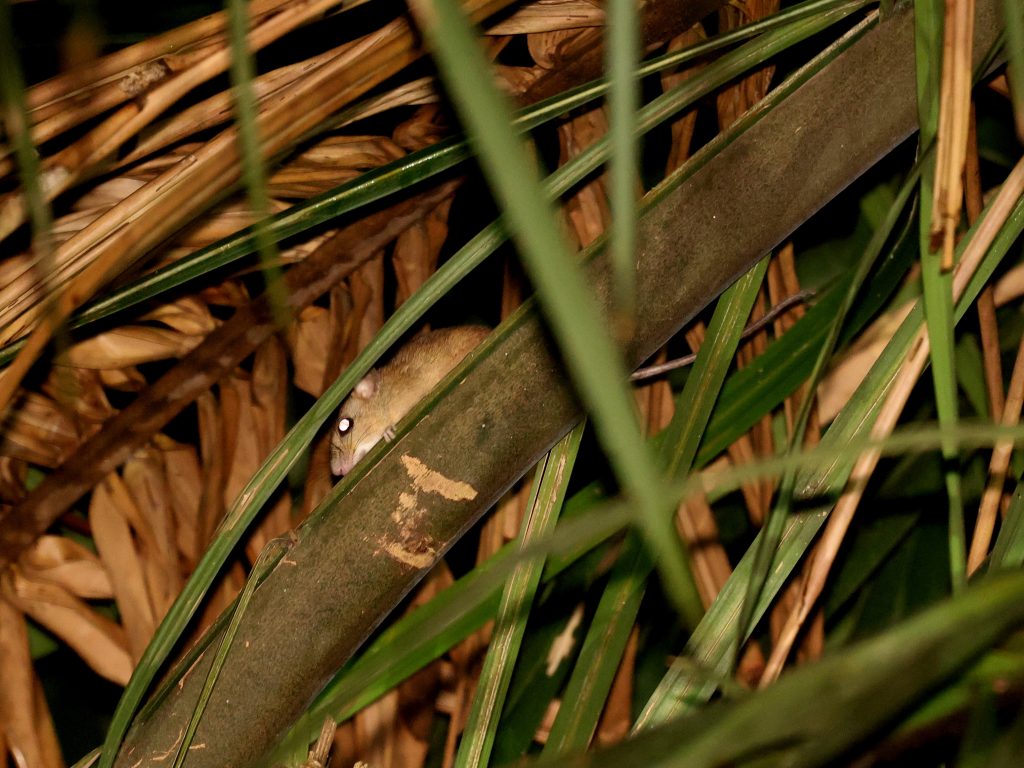
White-bellied Arboreal Rice Rat (Oecomys bicolor). Photo Alex Meyer.
White-bellied Arboreal Rice Rat (Oecomys bicolor): an oecomys – very likely this species – pre-dawn near the village.
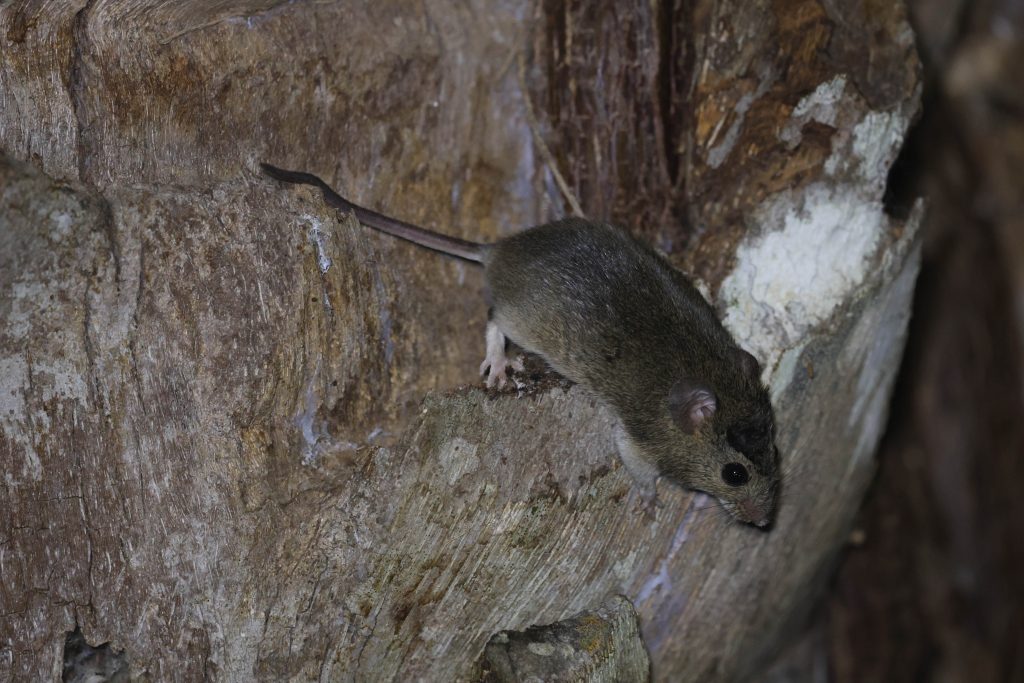
Drylands Vesper Mouse (Calomys musculinus), Photo Alex Meyer
Drylands Vesper Mouse (Calomys musculinus): our guides found a small mouse at night during heavy rain. With a head-body of 70mm, a tail of 68mm and distinctively white hind feet it looks like a very good match for Drylands Vesper Mouse.
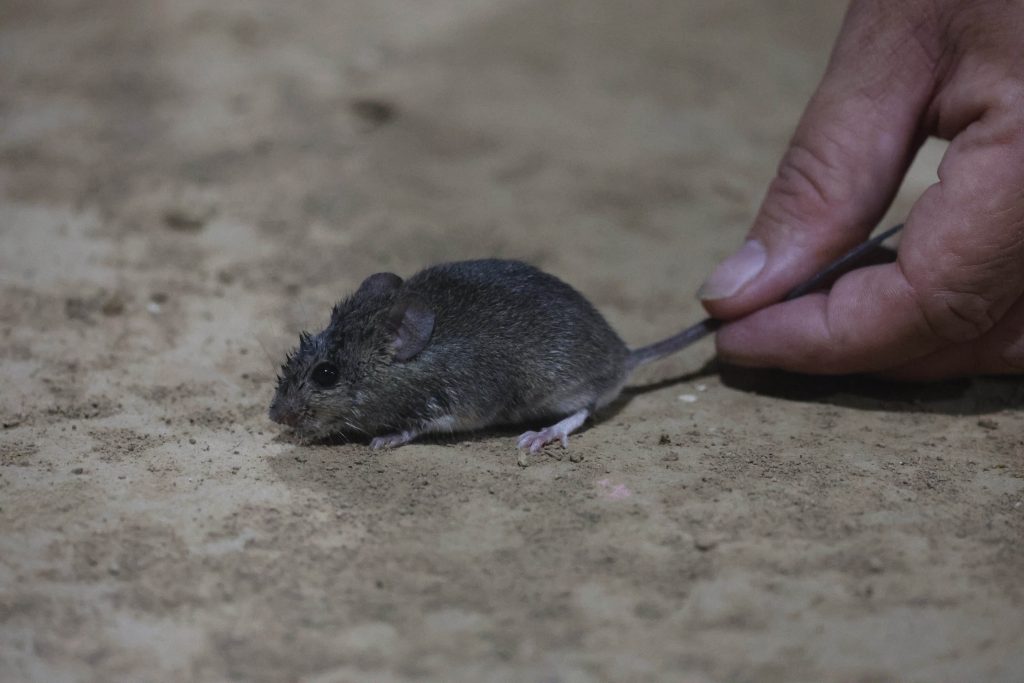
Drylands Vesper Mouse (Calomys musculinus), Photo Alex Meyer
But as always I would love to hear from anyone who thinks differently.
Short-tailed Spiny Rat (Proechimys brevicauda): Alex saw a rat at night he thinks was this species.
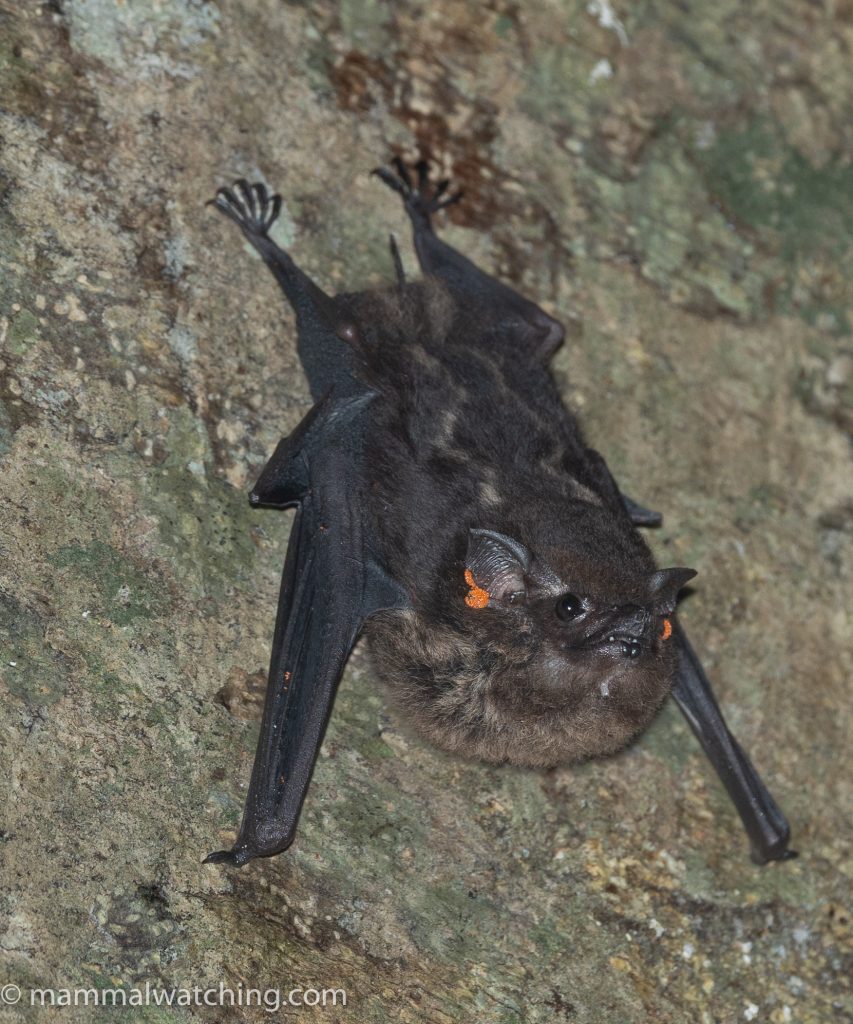
Greater Sac-winged Bat (Saccopteryx bilineata)
Greater Sac-winged Bat (Saccopteryx bilineata): one roosting on the trunk of a large tree pre-dawn.
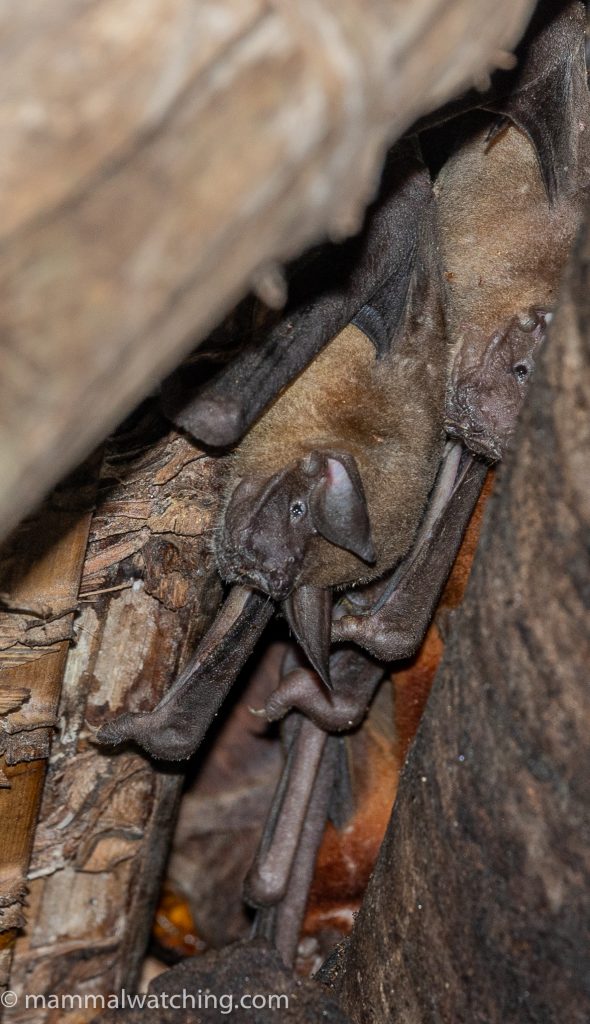
Lesser Bulldog Bat (Noctilio albiventris)
Lesser Bulldog Bat (Noctilio albiventris): many Greater and Lesser Bulldog Bats were skimming the river at dusk (the size difference is clear) and the villagers showed us a noctilio roost inside a house. We decided they were Lesser Bulldog Bats based on their size.
Greater Bulldog Bat (N.leporinus): many Greater and Lesser Bulldog Bats skimming the river at dusk.
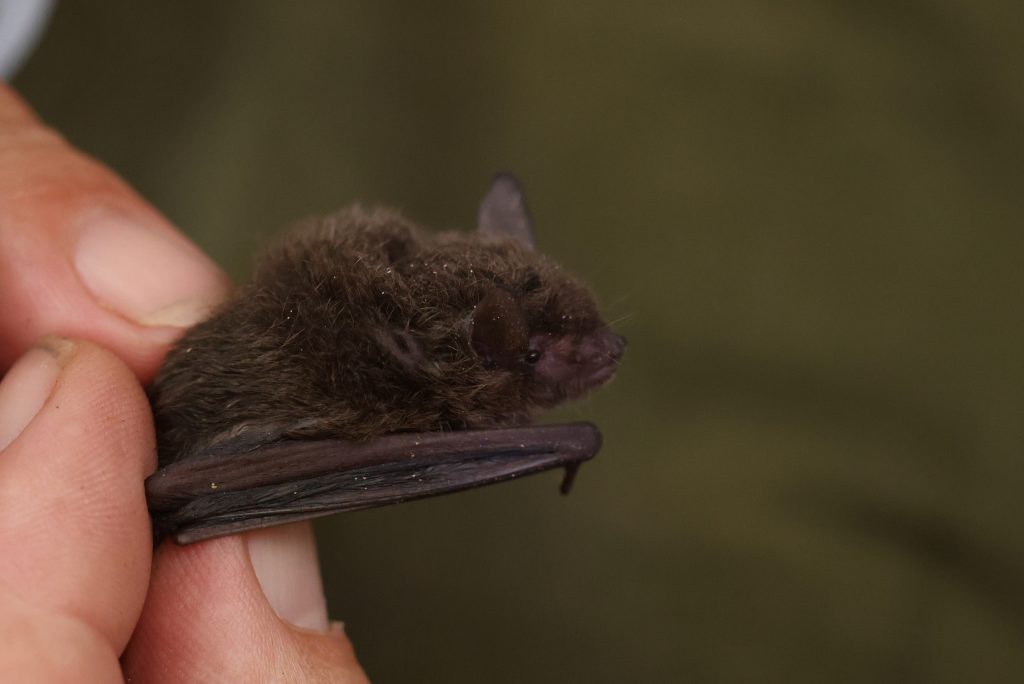
Silver-tipped Myotis (Myotis albescens). Photo Alex Meyer
Silver-tipped Myotis (Myotis albescens): the villagers showed us a roost in the school roof (thanks Jose Gabriel Martinez for suggesting the ID).
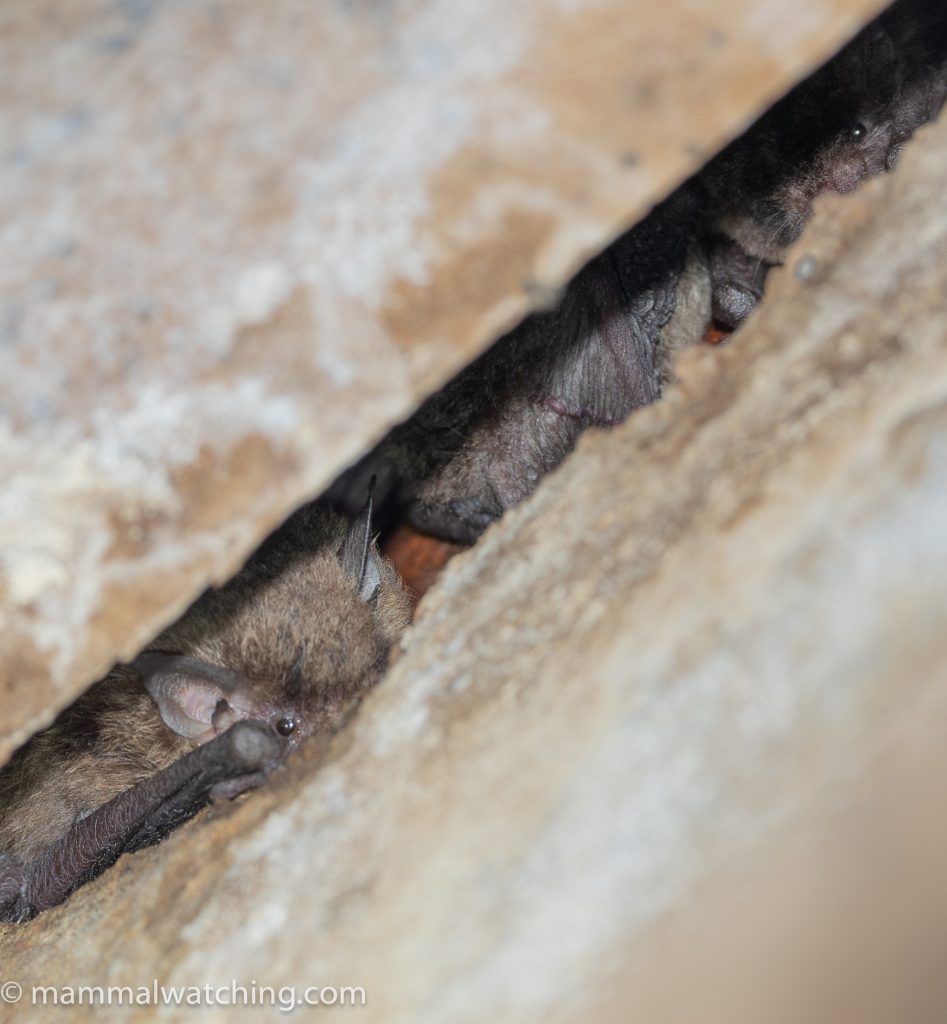
Silver-tipped Myotis (Myotis albescens)
We extracted a bat and ran a show and tell session about how important they were for both the ecosystem and mammal tourism. We may have exaggerated a little. So if you visit please do ask – in an excited a way as possible – to see the two bat roosts!
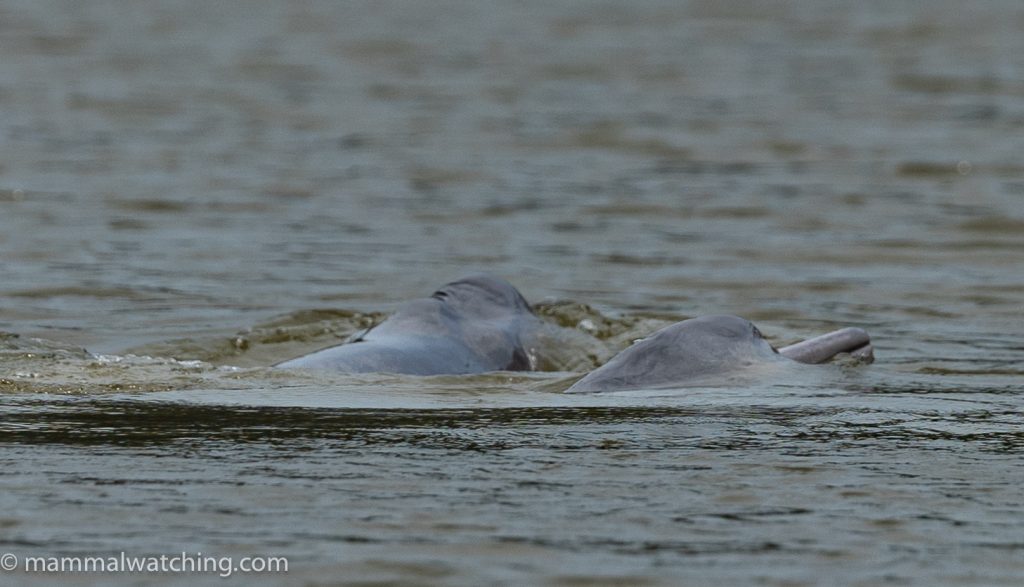
Bolivian River Dolphin (Inia boliviensis)
Bolivian River Dolphin (Inia boliviensis): good views of several animals during our canoe trip along the river.
Rurrenabaque
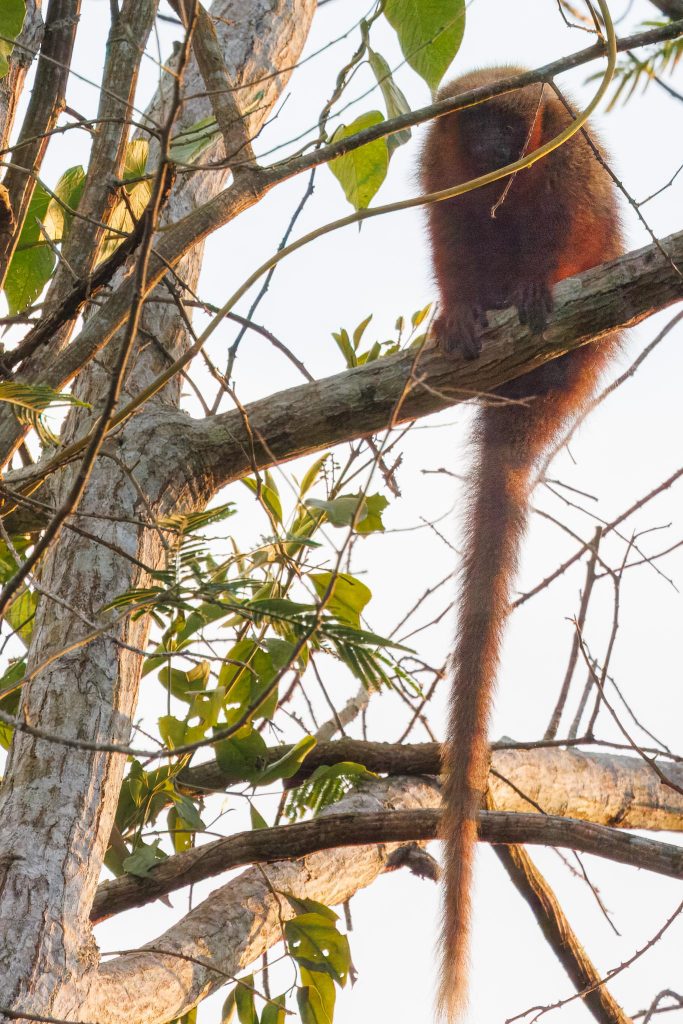
Madidi Titi (Plecturocebus aureipalatii). Photo John Rogers.
After two nights in Monte Carlo we returned to Rurrenabaque to catch a flight early the next morning. I had not planned on looking for much there other than a steak dinner but our guide mentioned he might know a site for Madidi Titi close to Rurrenabaque. This, remember, was a species Nick had advised we drop from out itinerary because his usual spot for the monkey would require a full day of travel in each direction plus a couple of days searching time.
The Madidi Titi was ony discovered in 2004 and is also known as the Golden Palace Monkey, after an online casino donated $650,000 to protect the monkey in exchange for choosing the name. This is a great idea though I am not sure what will happen to the name or the money if the rumours are true that the Madidi Titi will be lumped with Toppin’s Titi.
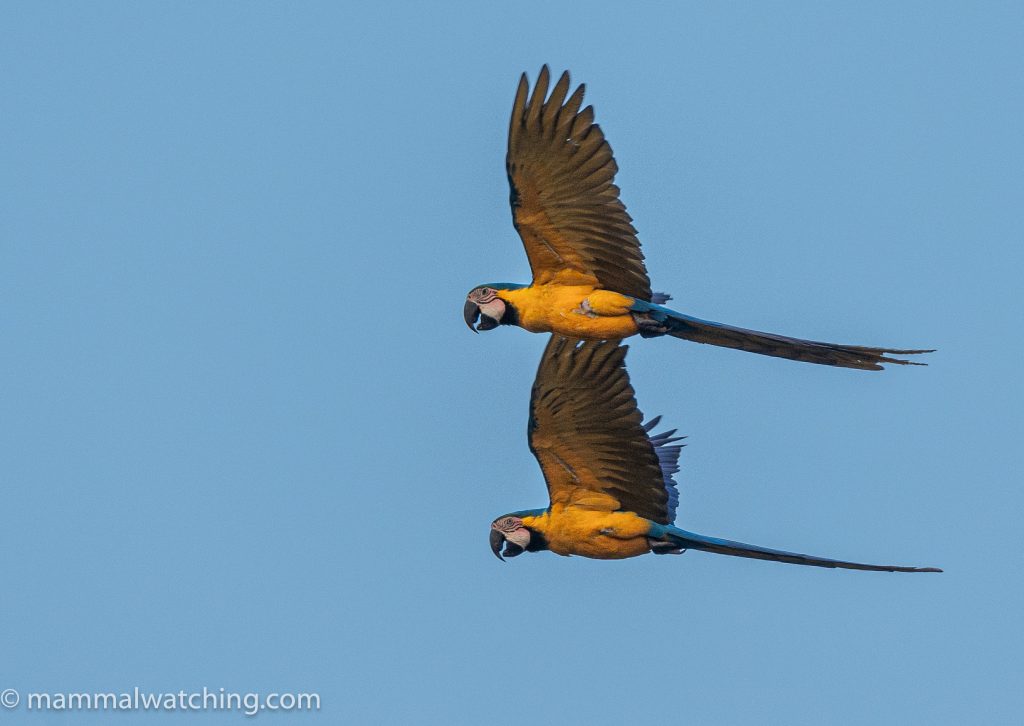
Blue and Yellow Macaws
Long story short, in the mid-afternoon we drove 45 minutes out of Rurrenabaque to a locked gate at a small patch of forest among the farmland. The owner let us in and within 30 minutes I had a clear but brief look at a Madidi Titi. We could not relocate them, despite trying call playback, and half the group had missed them. We also saw a rabbit here and for the moment we will record it as Common Tapeti.
The following morning those who had missed the monkey returned and saw them within an hour – John even got a photograph – and were back at the hotel in time for our 930 am flight. Boom!
If you do visit here then take care when you crawl under the barbed wire. Phil ripped not one but two pairs of pants while searching for the titi. Public decency laws in Bolivia are thankfully lax.
Pando Department
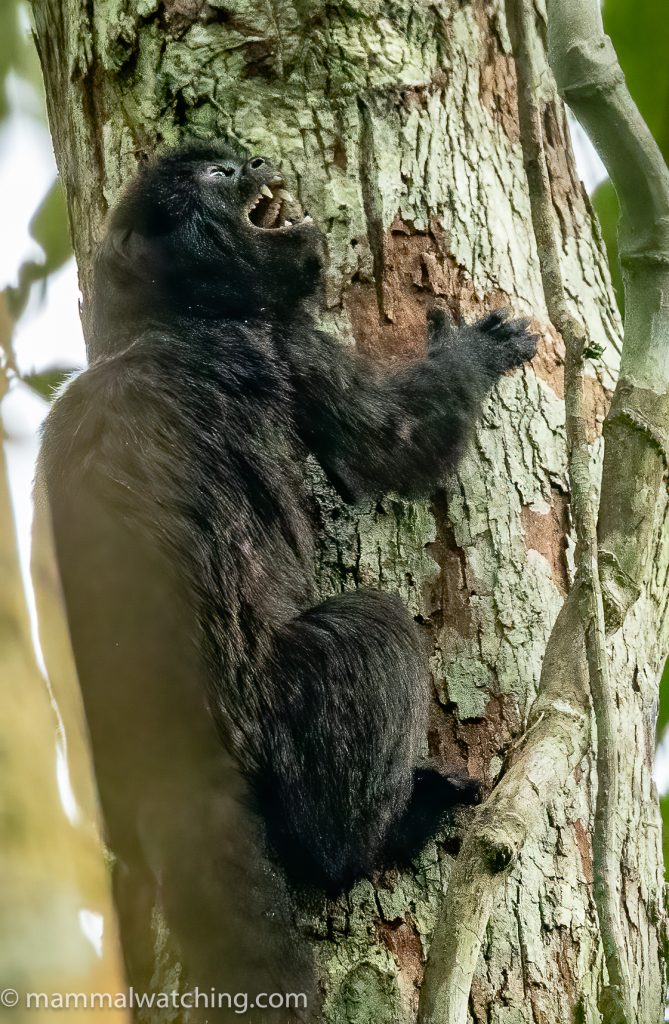
Goeldi’s Monkey (Callimico goeldii)
Flight schedules meant we had to spend 24 hours in La Paz. Nick was waiting for us at the hotel. My La Paz review: great food; impressive views; no mammals.
The next morning we flew to Cobija, the capital of the Pando Department, for the final stage of the trip.
Estación Biológica Tahuamanu
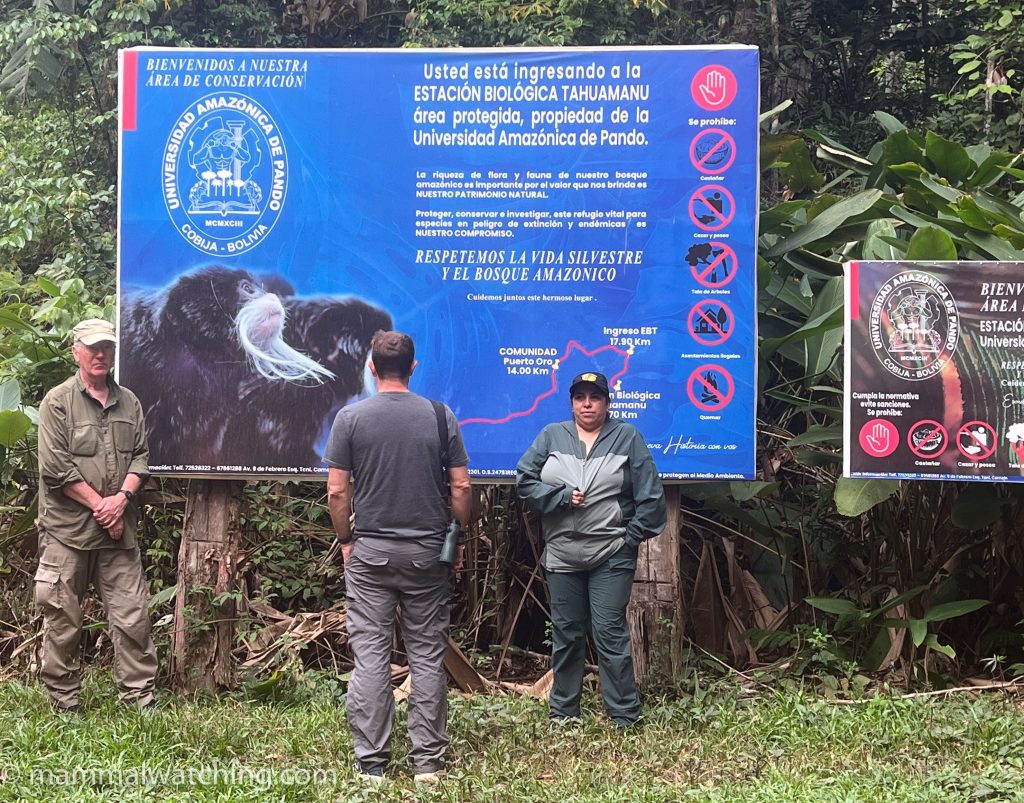
We would be staying at a Estación Biológica Tahuamanu, a research station run by the Universidad Amazónica de Pando about three hours’ drive from Cobija. The station, which protects 8000 hectares of Amazon rainforest, is not open to the public and Nick had to arrange the visit through Ericka Llanos at the university. This required some negotiating. If Ericka wasn’t a biologist she could have a great career in marketing. For starters, we “mammal experts” were met at the airport by a a TV news crew who interviewed Nick while we stared uncomfortably at everything but the camera having no clue what was going on.
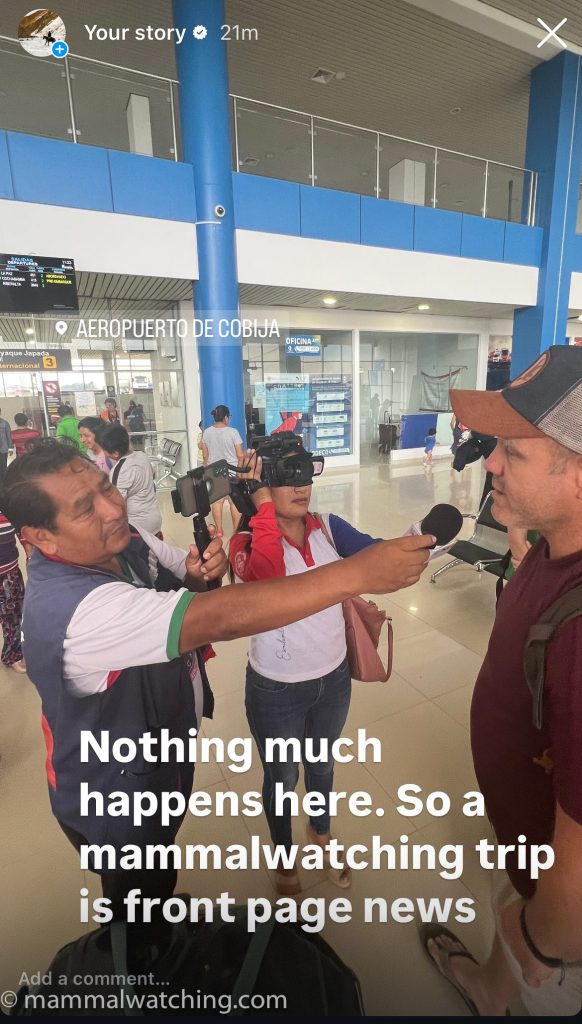
Nick makes the news
At the end of the stay Ericka asked us to give a lecture at the university and somehow managed to fill the room with biology and tourism students. I hope we were helpful. The students seemed genuinely interested, particularly when Alex courageously passed his thermal scope around the audience to test out.
If you want to visit the station then go through Nick, or at least contact the university direct even if it means you might be asked to give a talk or appear on TV. People visiting without the proper permission have caused problems in the past for the caretaker at the station.
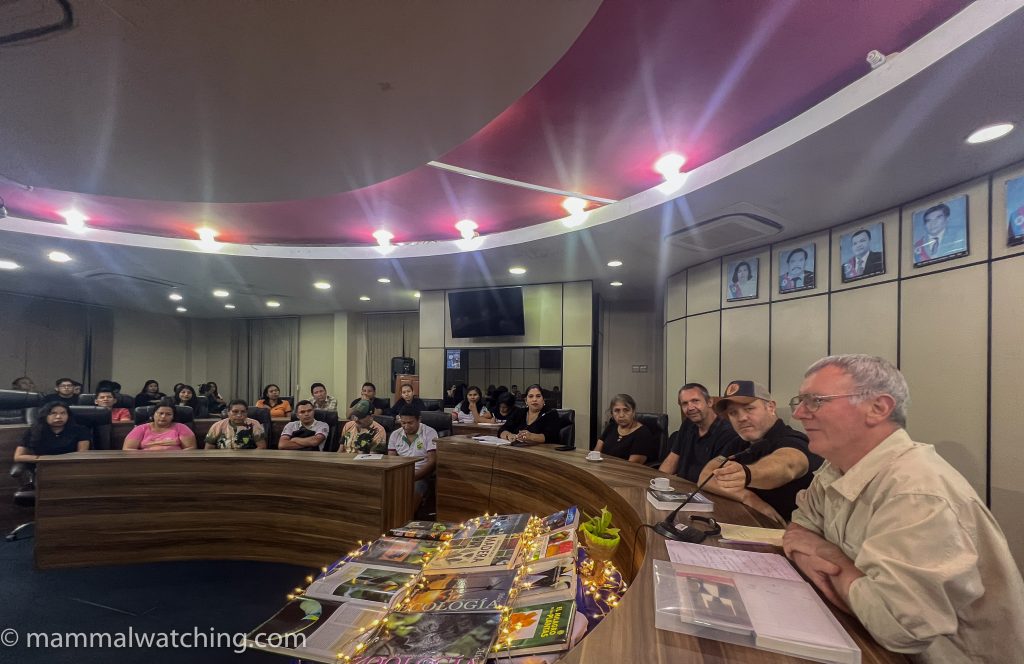
Kevin takes the mic
We spent four nights here exploring the forest on foot. Ian Thompson didn’t think a lot of the camp – being bitten by a Bullet Ant didn’t help I am sure -and he’d set our expectations so low that we were pleasantly surprised. As Ian said the ‘accommodation’ is falling to pieces, so we slept in tents inside what was left of one structure. But the temperatures were cool at night, the food was good, there was a generator and we even had wifi thanks to John’s Starlink system (side note: these things are impressively good!).
But the star of the station is Canela, the camp caretaker and our guide. Canela, a Brazilian, is a lovely guy who knows a huge amount about the mammals. He has accompanied primate researchers for many years and knew exactly which trails we should walk in order to find which species.
There is a good network of trails around the station, with grids set up for primate monitoring. At night we focused on the entrance road – which was easy for spotlighting – and quite productive. I imagine the public road outside the entrance would be good too but we didn’t have a vehicle and were also advised it might be unsafe to walk that road at night.
We did pretty well, and found the Goeldi’s on our first morning thanks to Canela.
But one of the highlights was reptilian.
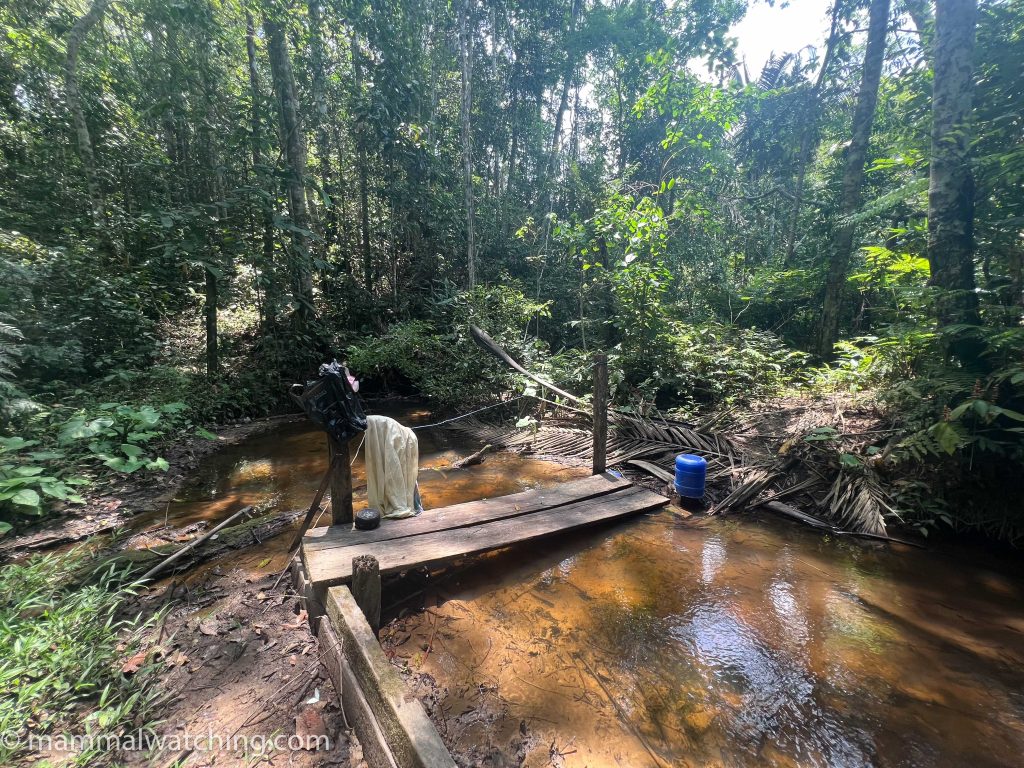
The station shower block
Having a ‘shower’ in camp meant balancing on a plank across a narrow stream and tipping a bucket of river water over your head.
We were finishing dinner on our second night and Canela was taking a shower. His screams echoed through the forest.
Nick understood there was a snake involved and led the charge down to the river. Some of us charged more quickly than others: I decided I had time to get my camera. Big mistake. I arrived too late to see the enormous – 5 m Green Anaconda – that had traumatized Canela. Apparently he was mid-shower when he noticed the creek had turned cloudy. He put this down to “just” another stingray until his head torch lit up an anacondas eyes staring at him, head raised out of the water to check him out. Cue screams.
The snake slid slowly under the plank, and under Canela.
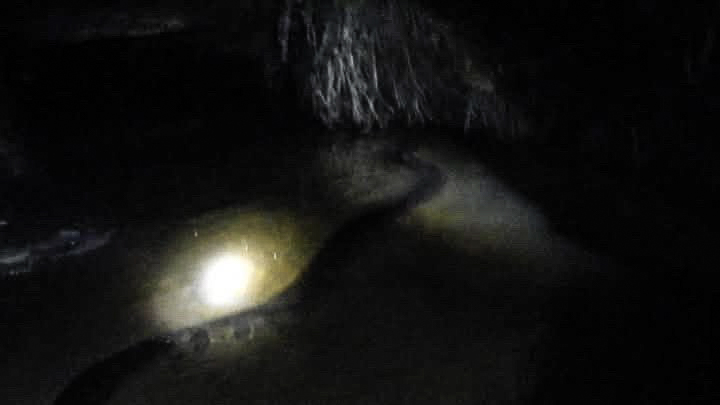
Nick was there first. Of course he was. He jumped into the creek and tried to grab the snake while taking a few seconds of video (here) that Steve Irwin would have been proud of. Seems that keeping a grip on an anaconda as thick as your leg while shooting a cell phone video and holding a flashlight is not as easy as you might think.
The snake got away just as we got to the creek. Kevin saw the snake well and I think this was his animal of the trip. Phil also had a massive grin on his face.
Few showers were taken after this.
Over the course of four days we saw the following mammals.
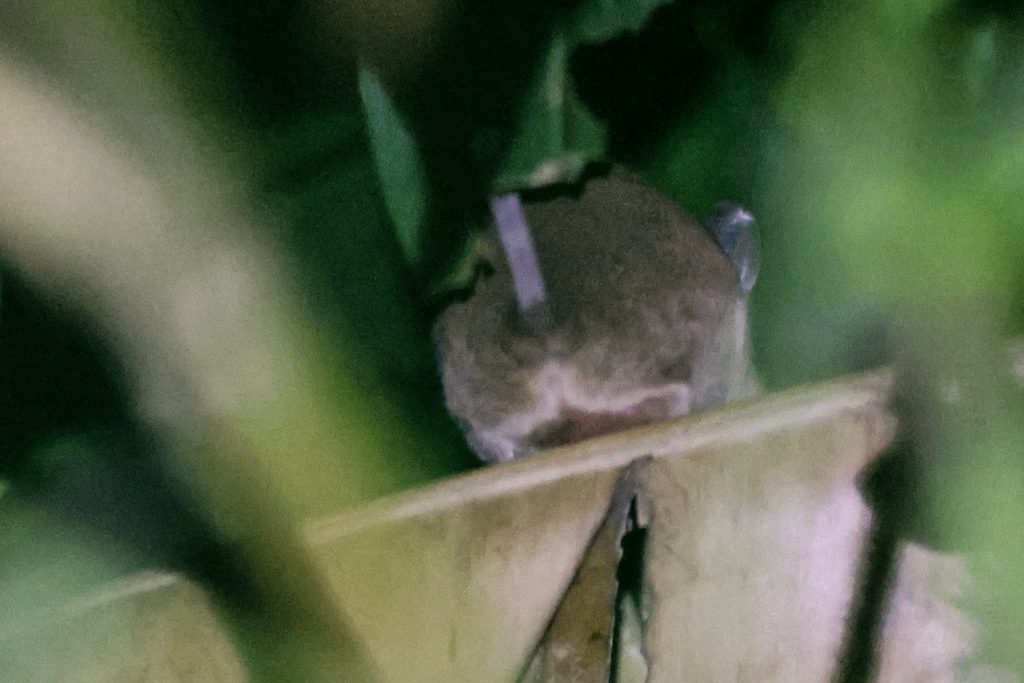
Mouse Opossum sp. Photo Alex Meyer.
Mouse Opossum species. Alex photographed what appears to be a mouse opossum. Possibly Bishop’s Slender Mouse Opossum. Possibly … there are several options here and I have no idea.
Brown-eared Woolly Opossum (Caluromys lanatus): one high up in trees on our first night.
Common Brown Four-eyed Opossum (Metachirus myosuros): one of the best mammals of the trip for me, this is a widespread but uncommon species that I had been in range of many times. We saw one animal distantly moving through trees a few hundred metres from the camp on a side trail. It took me 5 minutes to figure out what we were looking at.
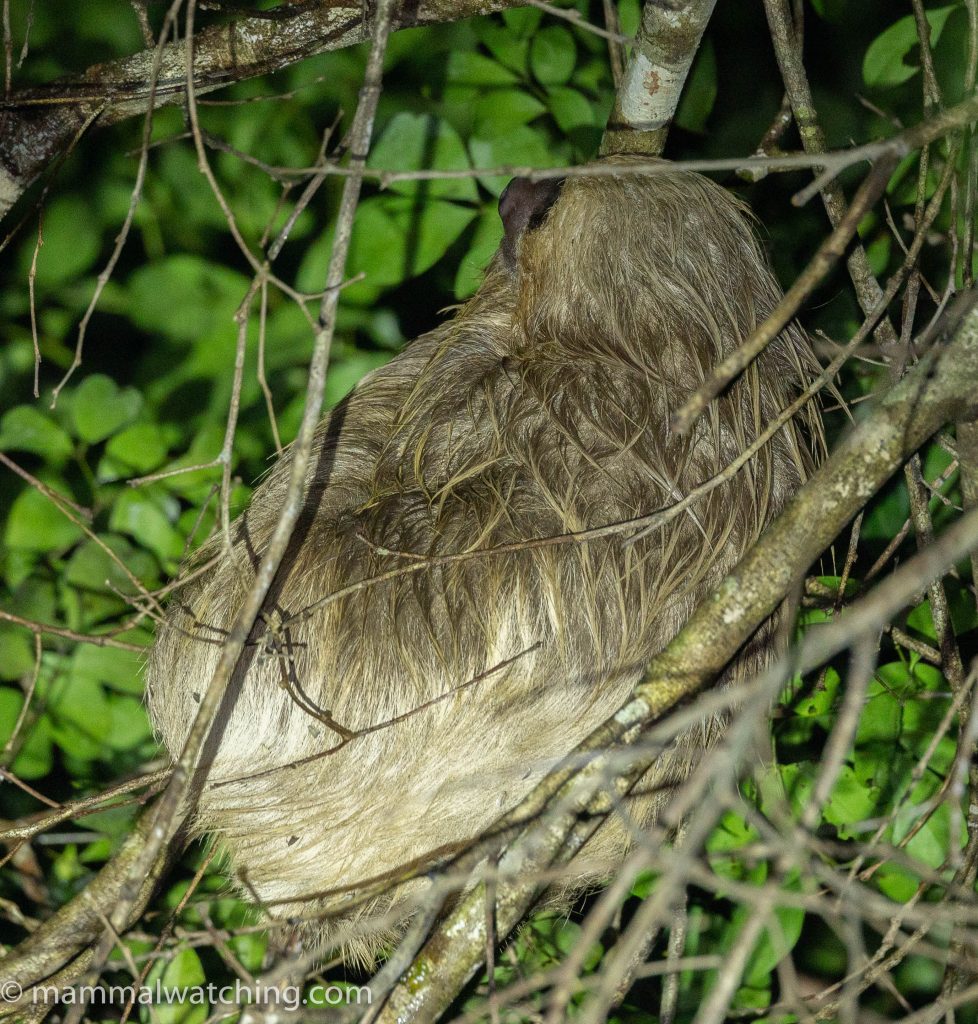
Hoffmann’s Two-toed Sloth (Choloepus hoffmanni)
Hoffmann’s Two-toed Sloth (Choloepus hoffmanni): two-toed sloths are rare in Bolivia and this was the first that Nick had seen here.
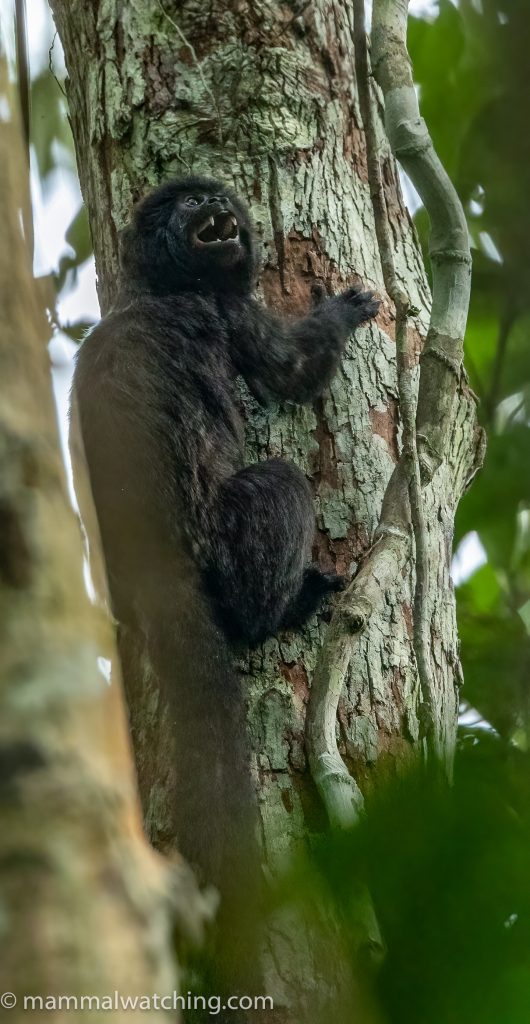
Goeldi’s Monkey (Callimico goeldii)
Goeldi’s Monkey (Callimico goeldii): the star of the trip. Canela took us to the right area – about an hour’s walk from the field station – and we saw several Goeldi’s travelling with a mixed troop of Red-bellied and Saddle-backed Tamarins. They responded well to call playback, just as Cheryl had said in her report. We watched them for at least twenty minutes.
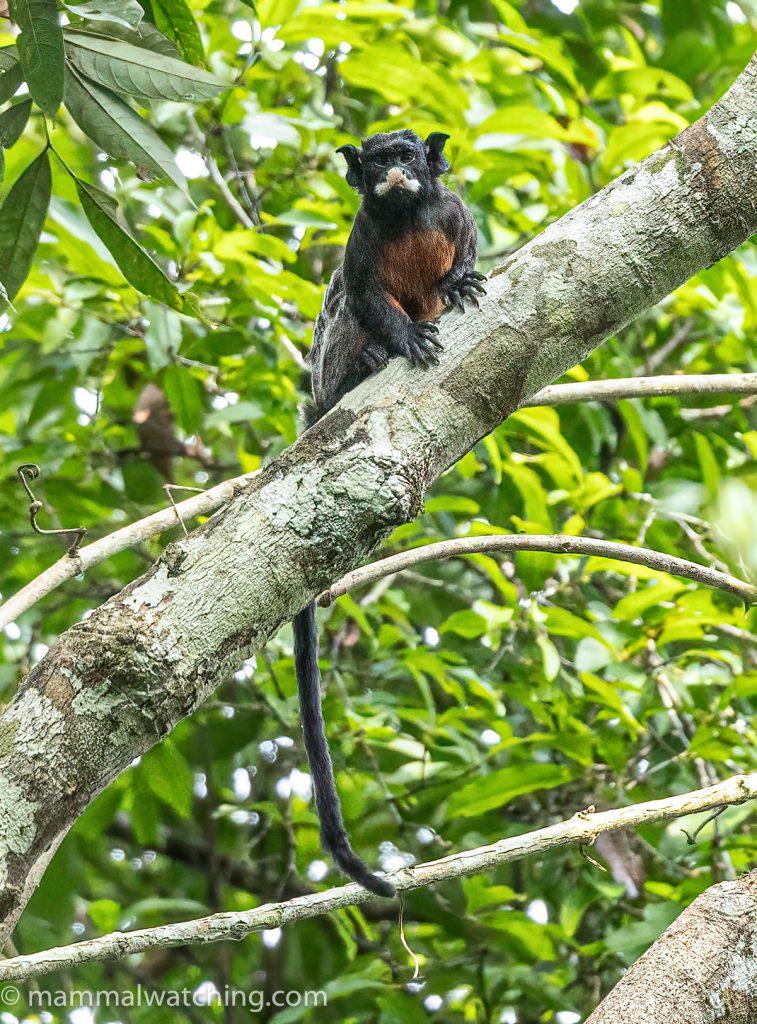
Red-bellied Tamarin (Saguinus labiatus)
Red-bellied Tamarin (Saguinus labiatus): a troop of these beautiful tamarins were with the Goeldi’s Monkeys.
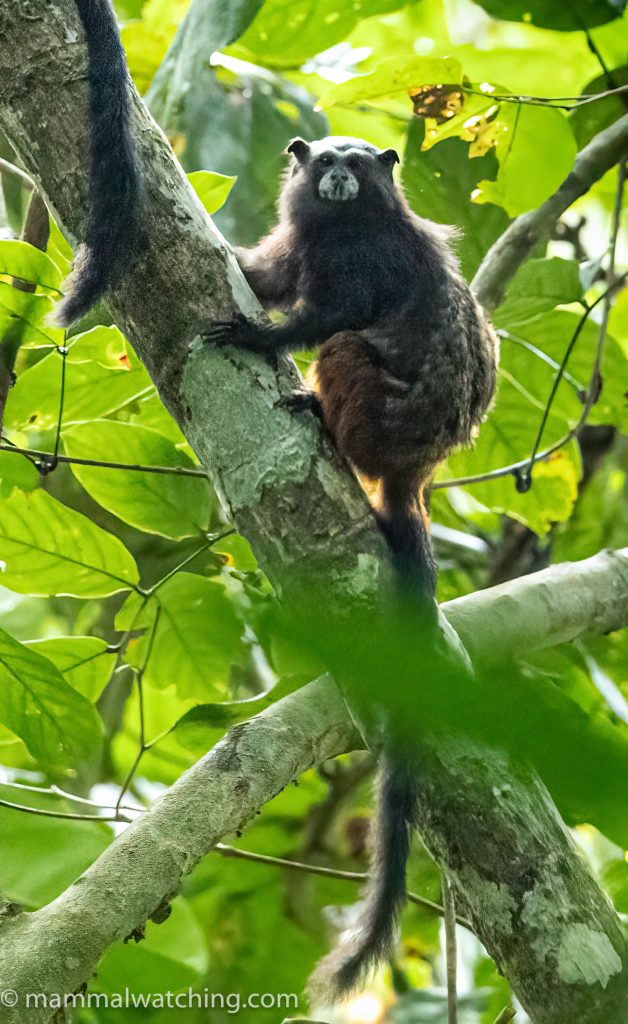
Weddell’s Saddle-back Tamarin (Saguinus weddelli)
Weddell’s Saddle-back Tamarin (Saguinus weddelli): a few with the Goeldi’s and Red-bellieds.
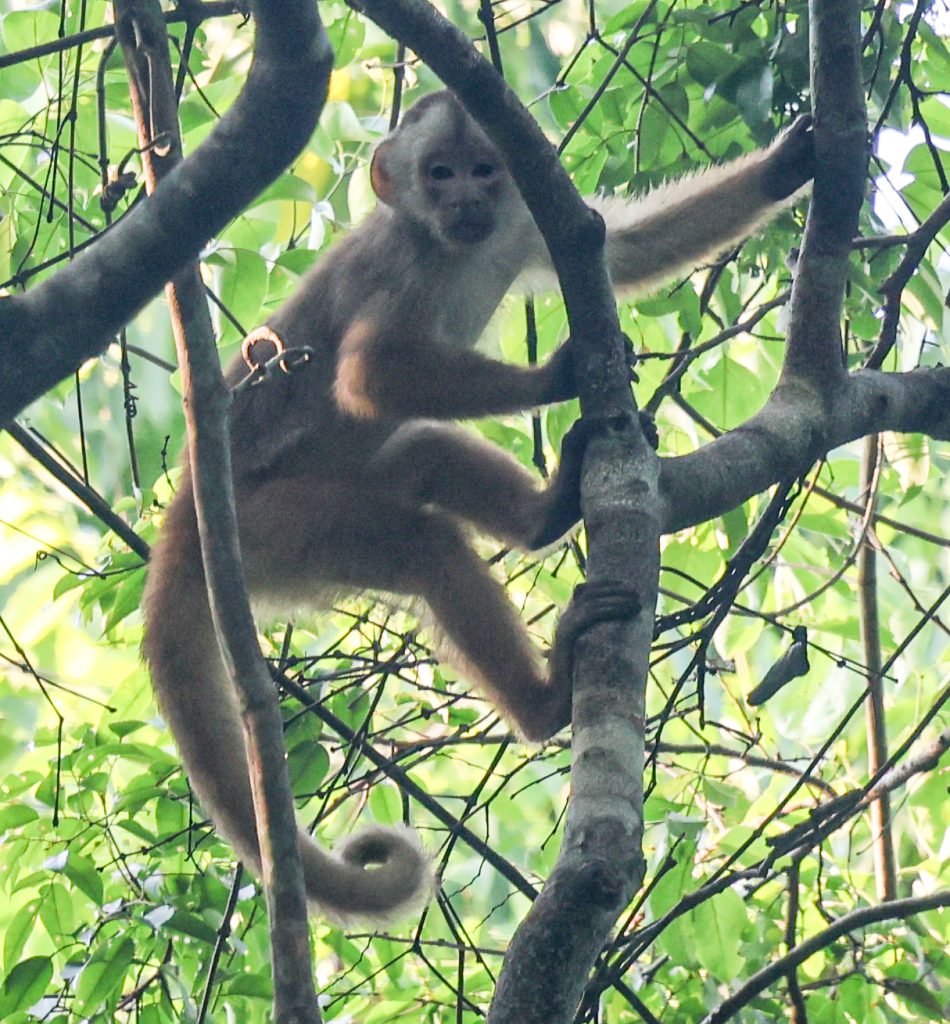
Shock-headed (White-faced) Capuchin (Cebus (albifrons) cuscinus). Photo Alex Meyer.
Shock-headed (White-faced) Capuchin (Cebus (albifrons) cuscinus): we saw just one troop of this species along the entrance road. Also often thought of now as a subspecies of White-faced Capuchin depending on which taxonomy you follow.
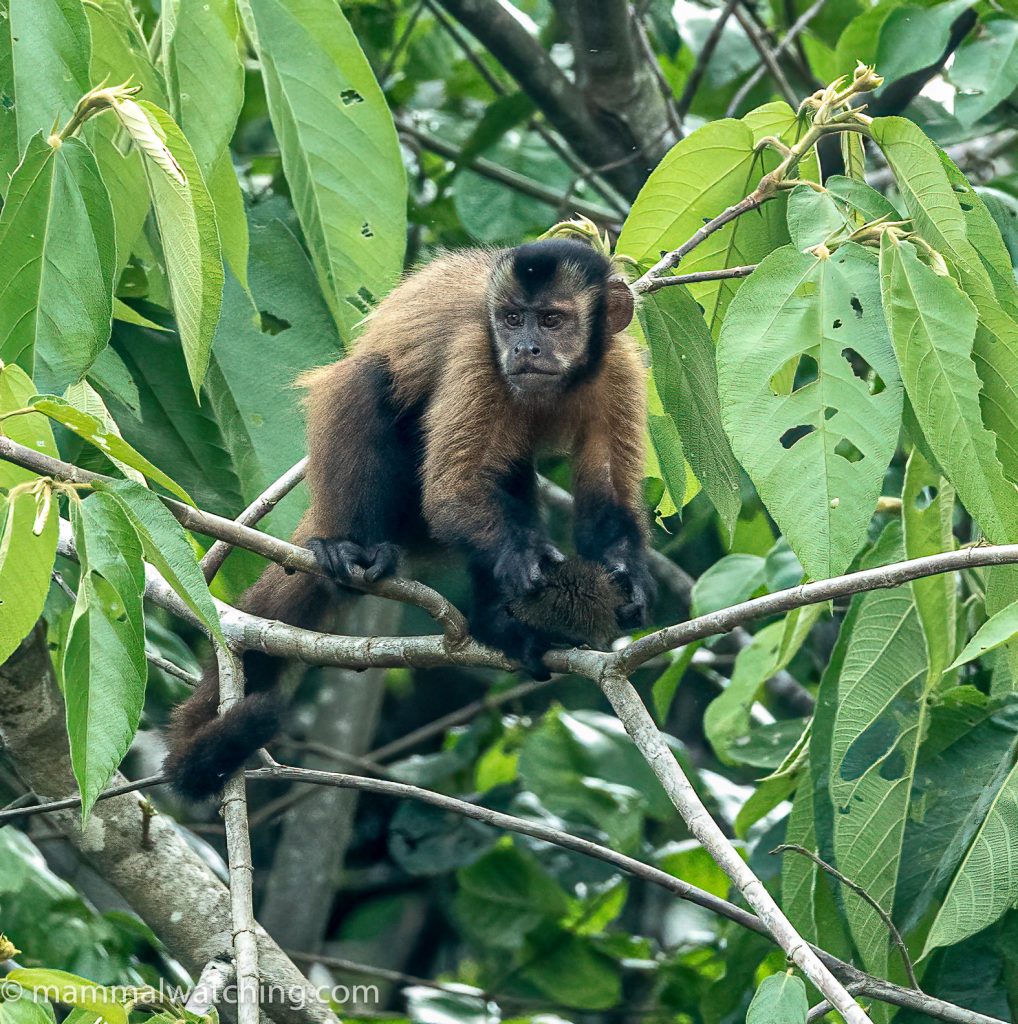
Brown (Large-headed) Capuchin (Sapajus (macrocephalus) apella)
Large-headed (Brown) Capuchin (Sapajus (apella) macrocephalus): several troops of this species (or subspecies of Brown Capuchin depending on which taxonomy you follow) around the research station.
Toppin’s Titi (Plecutrocebus toppini): Phil and John got brief looks at this species.
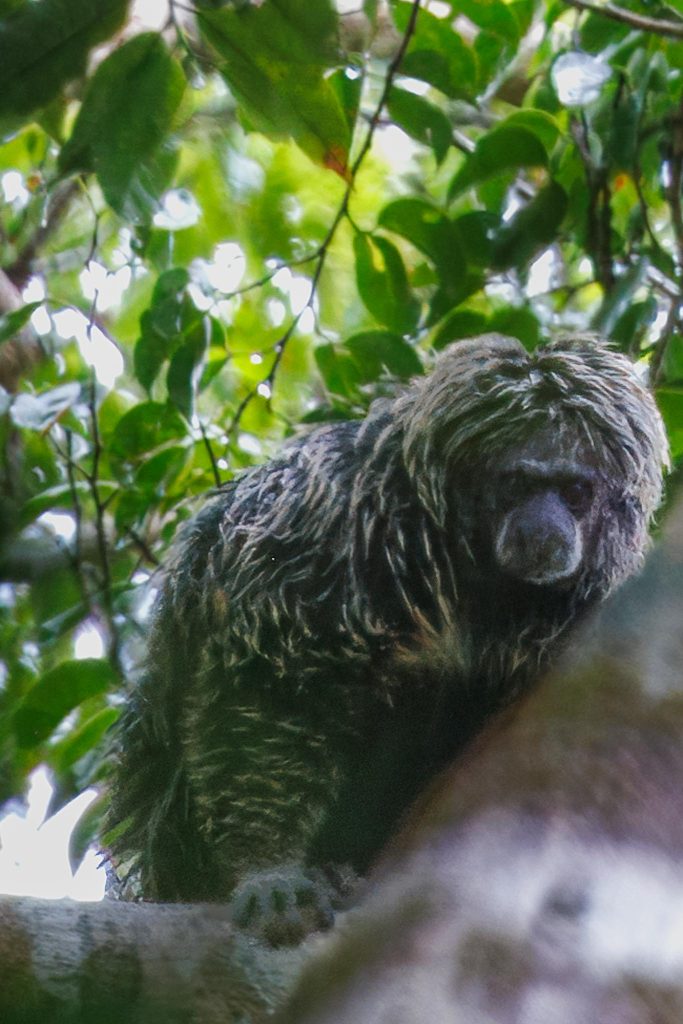
Gray’s Bald-faced Saki (Pithecia irrorata). John Rogers.
Gray’s Bald-faced Saki (Pithecia irrorata): I missed these though I have seen them in Los Amigos in Peru. But most of the group saw an animal next to camp and a couple of people saw animals elsewhere. Formerly known as Ryland’s Saki but now lumped.
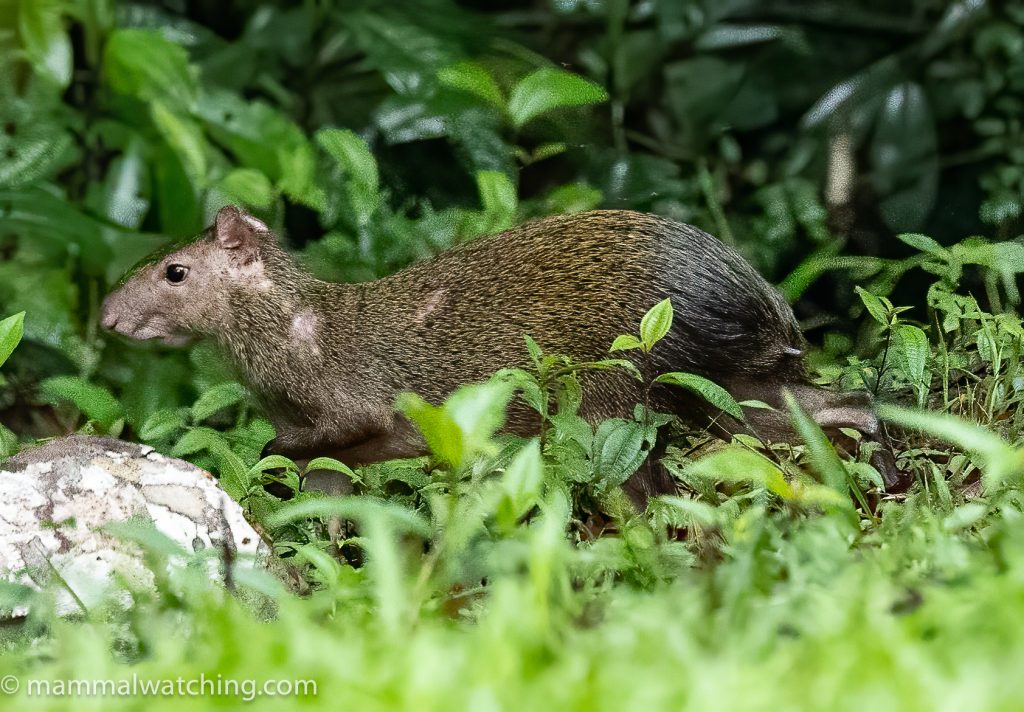
Brown Agouti (Dasyprocta variegata)
Brown Agouti (Dasyprocta variegata): one in the mid-morning near camp.
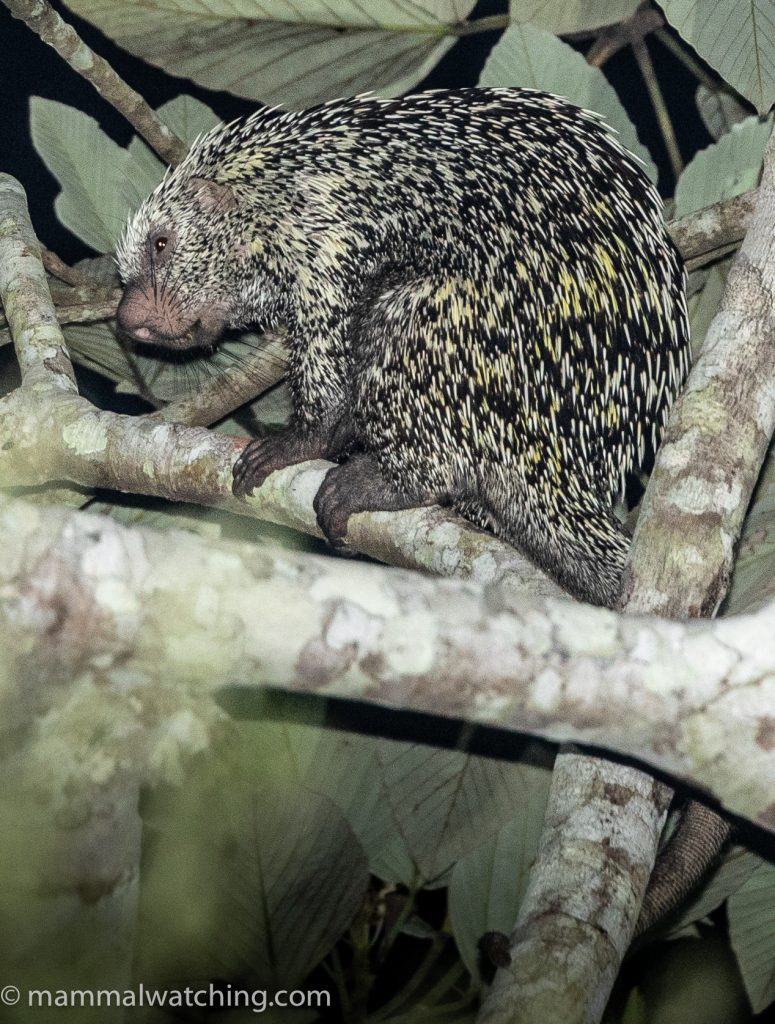
Amazonian Long-tailed Porcupine (Coendou.longicaudatus)
Amazonian Long-tailed Porcupine (Coendou.longicaudatus): porcupines were common around camp after dark. We tried hard to turn at least one of them into a Bicolour-spined Porcupine (C. bicolor) but all of the ones we saw well enough to identify were long-tailed.
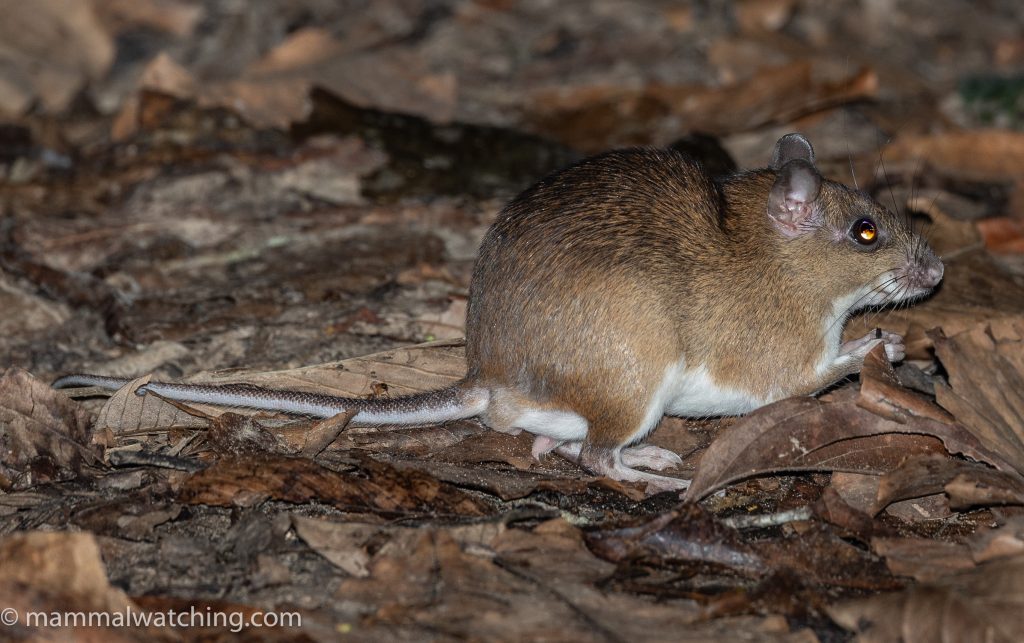
Simons’s Spiny-rat (Proechimys simonsi)
Simons’s Spiny-rat (Proechimys simonsi): these large rats were very common along the entrance road after and we must have seen 20 or more.
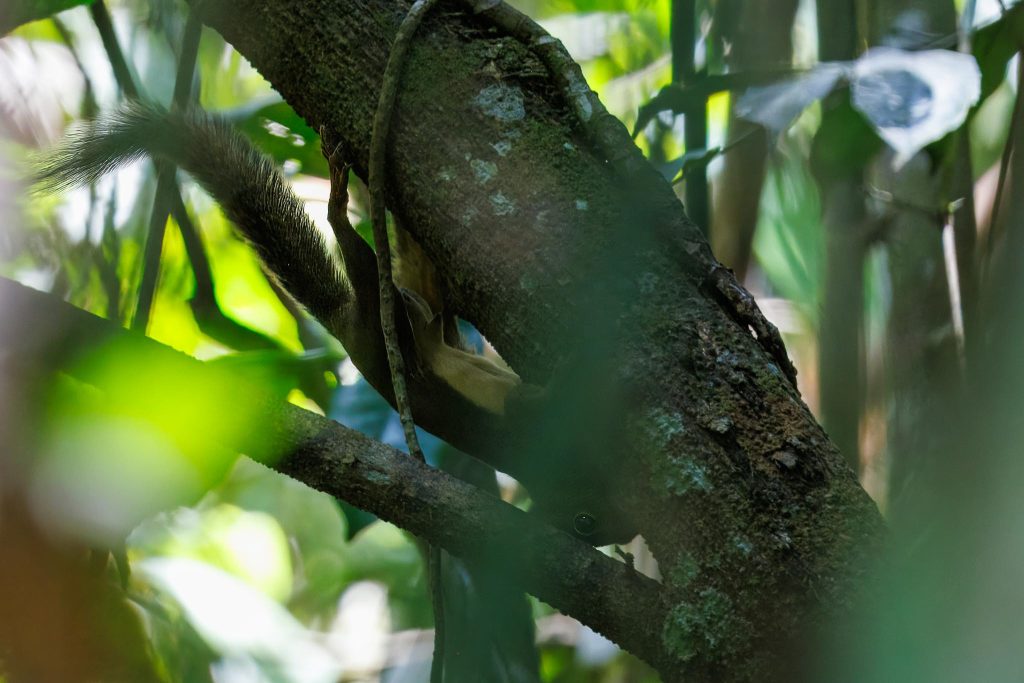
Amazon Dwarf Squirrel (Microsciurus flaviventer). Photo John Rogers,
Amazon Dwarf Squirrel (Microsciurus flaviventer): John Rogers was able to photograph this species when he took a solo walk late one morning. Probably quite common in the reserve they are hard to spot. Alex embarked on a crusade to find one but despite looking whenever he could he couldn’t relocate John’s animal.
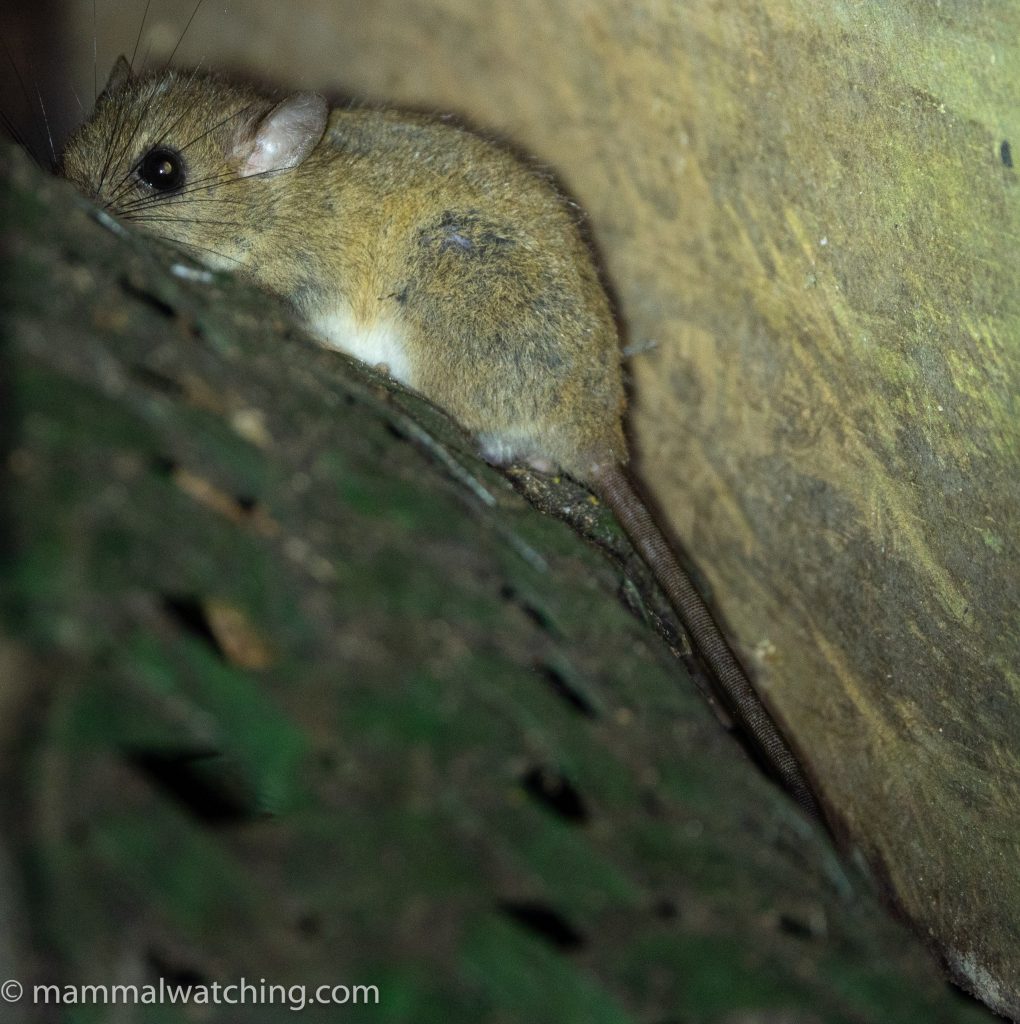
White-bellied Arboreal Rice Rat (Oecomys bicolor)
White-bellied Arboreal Rice Rat (Oecomys bicolor): several aboreal rats all looked good for the Oecomys genus and seem very likely this species.
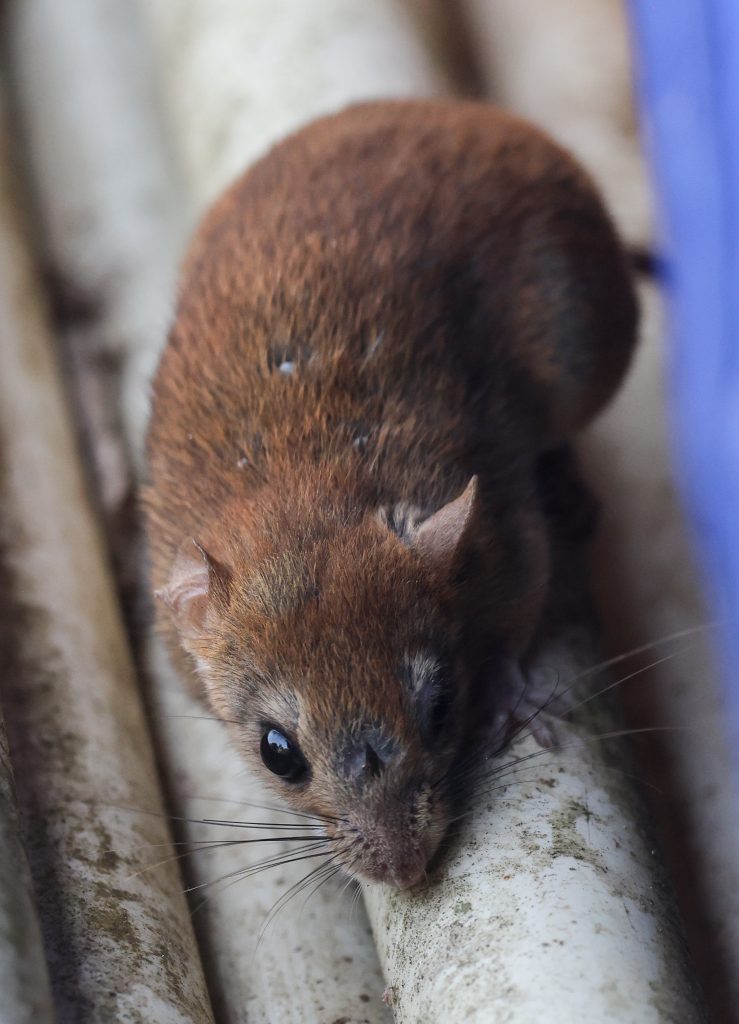
Gardner’s Climbing Rat (Rhipidomys gardneri). Photo Alex Meyer.
Gardner’s Climbing Rat (Rhipidomys gardneri): this interesting mouse set up camp inside Alex’s camera bag. I managed to trap it, but it’s capture was short lived. It bit me surprisingly effectively and I dropped it.
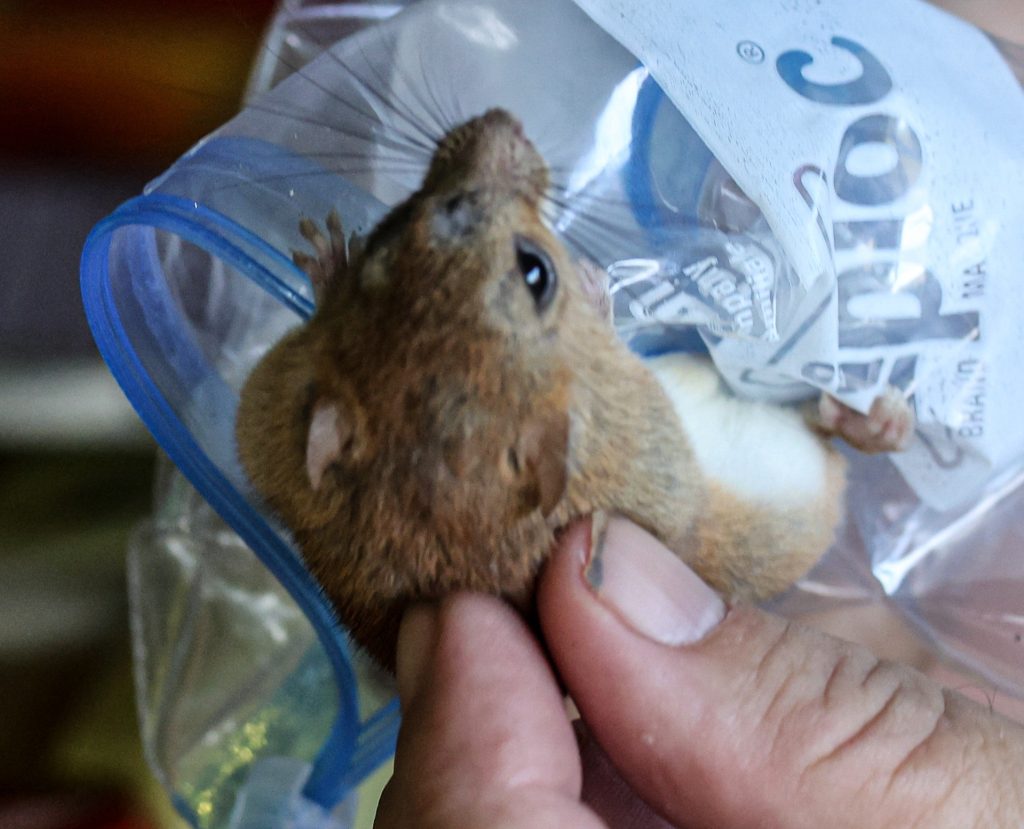
Gardner’s Climbing Rat (Rhipidomys gardneri). Photo Alex Meyer.
Several people rushed to find me a sticking plaster and antiseptic. Fortunately Alex had no concern for my wellbeing and was able to get more photographs of the mouse. Great work because it appears to be something quite interesting. After chatting with Fiona Reid we think it might be a climbing rat. It has distinctive and richly-coloured dosal fur with a black bases, while the ventral fur seems pure white.
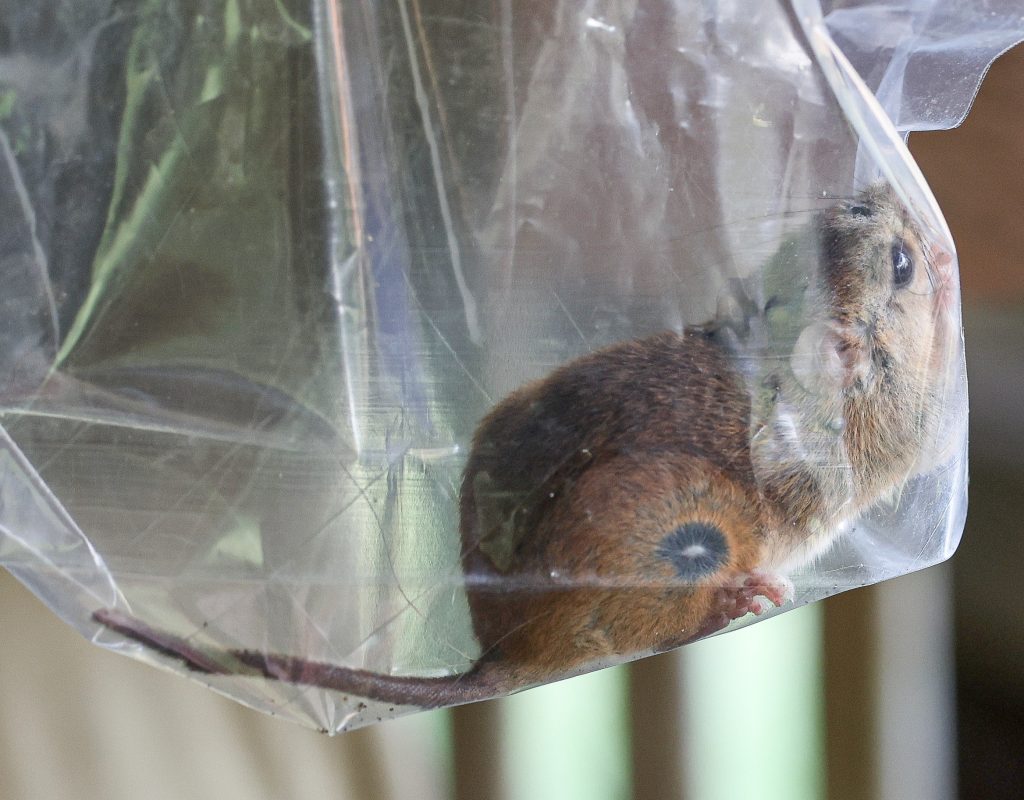
Gardner’s Climbing Rat (Rhipidomys gardneri). Photo Alex Meyer.
Unfortunately it had lost the end of its tail but there are only two options in range so far as I can tell, and this doesn’t look a great match for the other one, the larger White-footed Climbing Rat. So for now we will record it as Gardner’s while we are seeking other opinions.
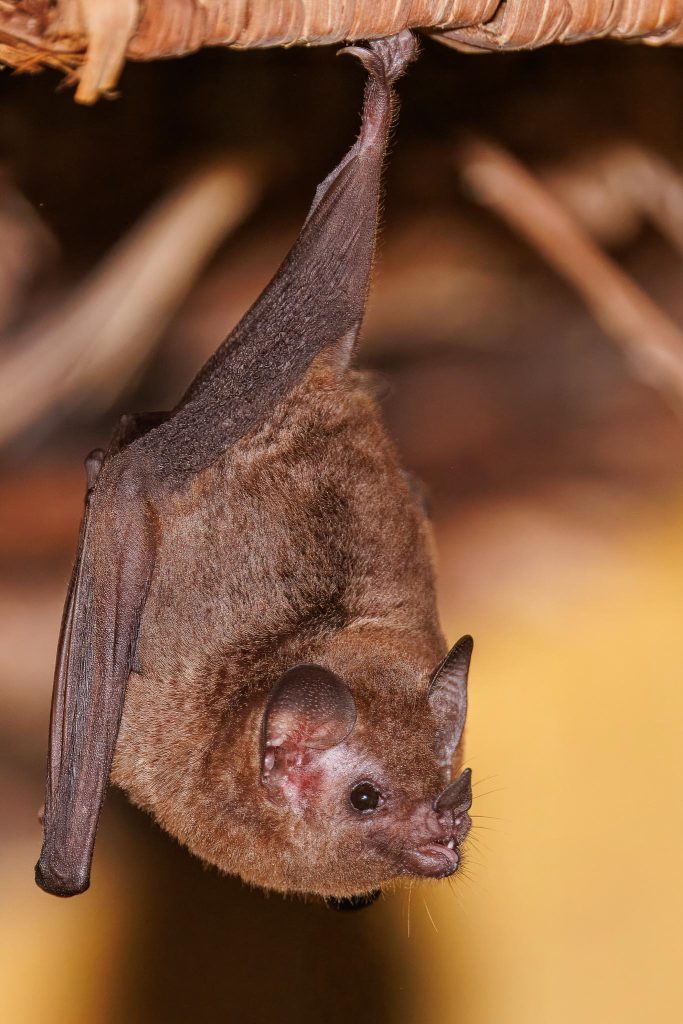
Pallas’s Long-tongued Bat (Glossophaga soricina). Photo John Rogers.
Pallas’s Long-tongued Bat (Glossophaga soricina): a small group roosting upstairs above our sleeping quarters.
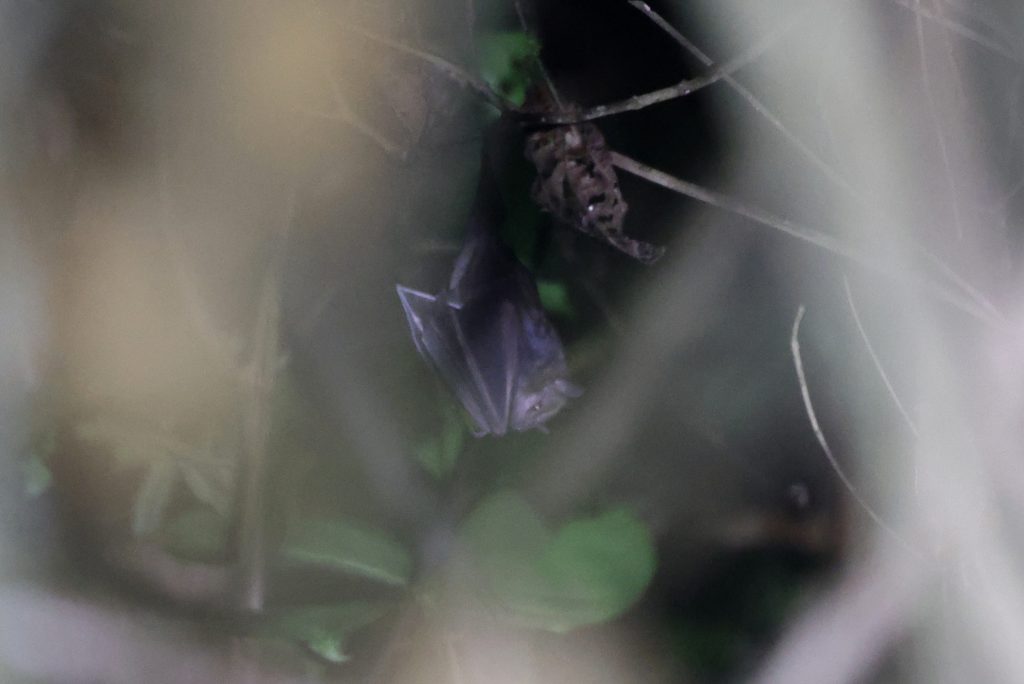
Dark Fruit-eating Bat (Artibeus obscurus). Photo Alex Meyer.
Dark Fruit-eating Bat (Artibeus obscurus) (?): my thermal picked up a largish dark fruit bat hanging from a branch one night. It might be this species although there are other options.

Kinkajou (Potos flavus)
Kinkajou (Potos flavus): one gave decent views on our first night while we were spotlighting along the road.
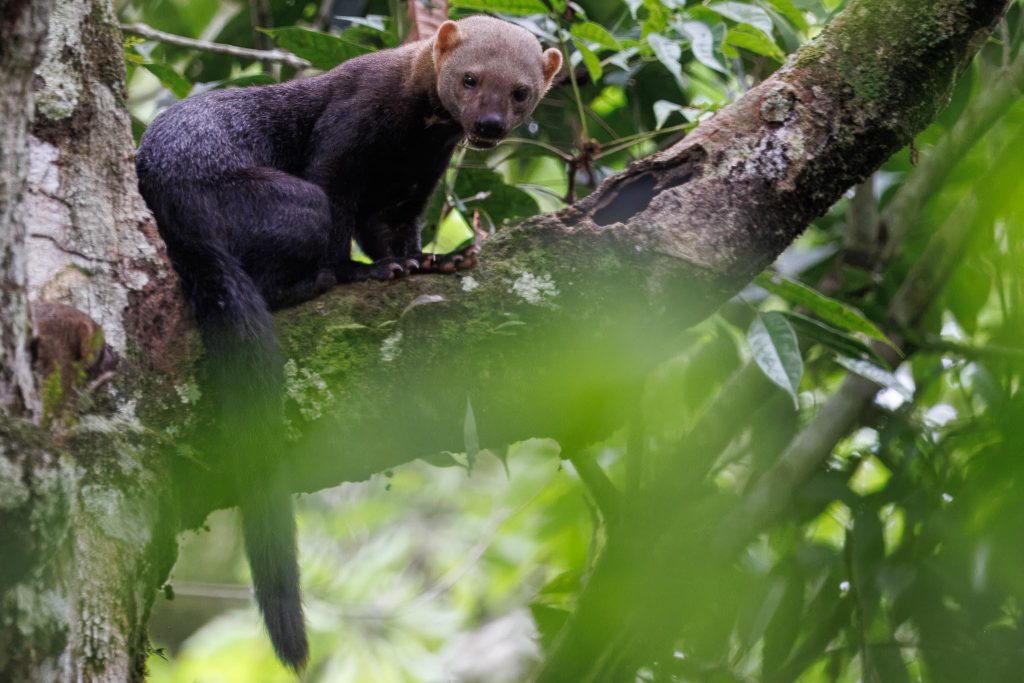
Tayra (Eira barbara). John Rogers
Tayra (Eira barbara): we saw animals on three separate occasions including a pair in a tree.
Trip List
Mouse Opossum species – Alex only
Brown-eared Woolly Opossum (Caluromys lanatus)
Northern Black-eared Opossum (Didelphis marsupialis)
Common Four-eyed Opossum (Philander canus)
Common Brown Four-eyed Opossum (Metachirus myosuros) – lifer
Brown-throated Three-toed Sloth (Bradypus variegatus)
Hoffmann’s Two-toed Sloth (Choloepus hoffmanni)
Southern Tamandua (Tamandua tetradactyla)
Azara’s Night Monkey (Aotus azarae)
Bolivian Red Howler (Alouatta sara)
Goeldi’s Monkey (Callimico goeldii)
Red-bellied Tamarin (Saguinus labiatus) – lifer
Weddell’s Saddle-back Tamarin (S.weddelli)
White-fronted (Shock-headed) Capuchin (Cebus (albifrons) cuscinus) – lifer
Brown Capuchin (Sapajus apella)
Large-headed Capuchin (Sapajus (apella) macrocephalus)
Black-capped Squirrel Monkey (Saimiri boliviensis)
Madidi Titi (Plecturocebus aureipalatii) – lifer
White-eared Titi (P.donacophilus) – lifer
Rio Beni Titi (P.modestus) – endemic – lifer
Olallas’ Titi (P.olallae) – endemic – lifer
Toppin’s Titi IPlecutrocebus toppini) – not be me
Gray’s Bald-faced Saki (Pithecia irrorata) – not by me
Common Tapeti (Sylvilagus brasiliensis)
Greater Capybara (Hydrochoerus hydrochaeris)
Brown Agouti (Dasyprocta variegata) – lifer
Amazonian Long-tailed Porcupine (C.longicaudatus)
Short-tailed Spiny Rat (Proechimys brevicauda – Alex only
Simons’s Spiny-rat (Proechimys simonsi) – lifer
Amazon Dwarf Squirrel (Microsciurus flaviventer) – John Rogers only
Bolivian Squirrel (Sciurus ignitus) – lifer
Southern Amazon Red Squirrel (S.spadiceus)
White-bellied Arboreal Rice Rat (Oecomys bicolor)
Drylands Vesper Mouse (Calomys musculinus) – lifer
Gardner’s Climbing Rat (Rhipidomys gardneri) – lifer
Greater Sac-winged Bat (Saccopteryx bilineata)
Lesser Bulldog Bat (Noctilio albiventris)
Greater Bulldog Bat (N.leporinus)
Pallas’s Long-tongued Bat (Glossophaga soricina)
Dark Fruit-eating Bat (Artibeus obscurus) (?) – possibly
Silver-tipped Myotis (Myotis albescens)
Common Black Myotis (M.nigricans) (?) – possibly
Tayra (Eira barbara)
South American Coati (Nasua nasua)
Kinkajou (Potos flavus)
Bolivian River Dolphin (Inia boliviensis) – lifer
46 species and 13 of them lifers for me.
Stuff We Missed
Obviously there many many others species we could have seen. Two species that I had thought we might – see based on other reports from Bolivia – were Bicoloured-spined Porcupine and Amazon Brown Brocket.
Southern Pygmy Marmoset are also around Pando and it sounded like Canela now has a spot for those in Brazil, just over the river from Cobija. And Canela mentioned seeing Short-eared Dog in the reserve several times. We thought we heard one at one point but decided it was a Crab-eating Fox.
Bird List
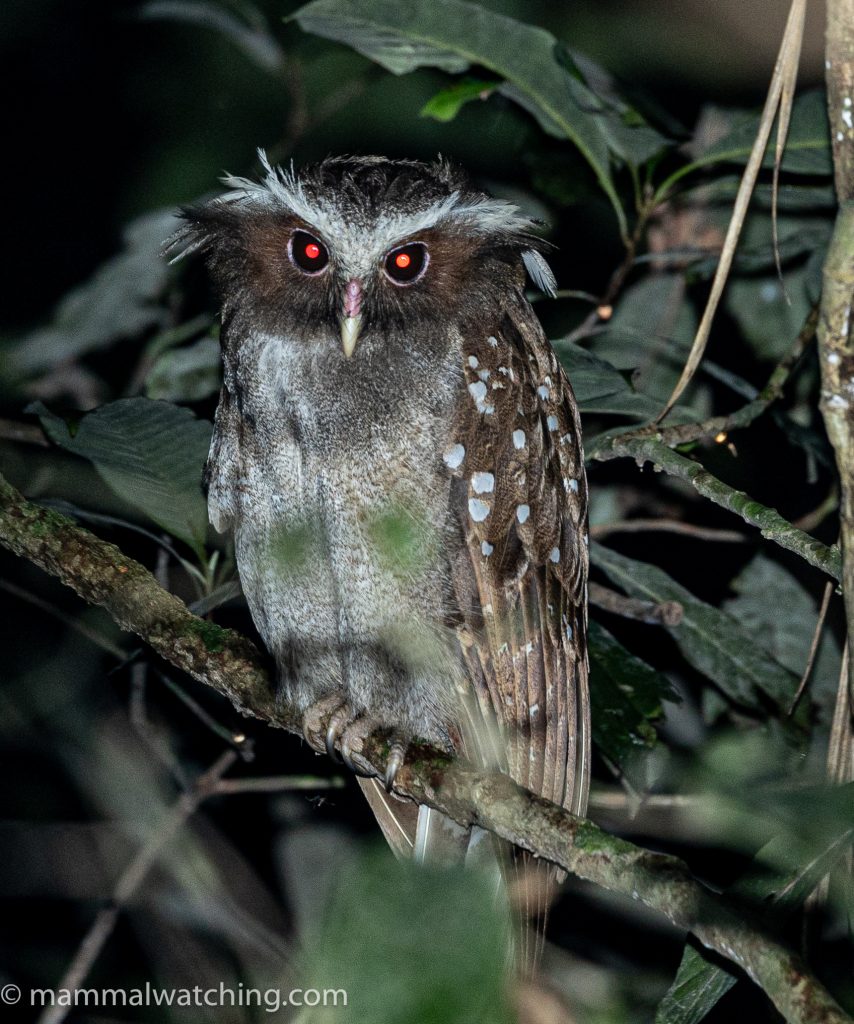
Crested Owl (Lophostrix cristata)
A bird list will be coming soon courtesy of others on the trip. We saw some rare birds along the way but, more importantly, the serious birders on the trip behaved impeccably well and always put the mammals first. Thank you for your restraint! I know I couldn’t have done it if the tables were turned.

John resisting looking at a bird. Photo Alex Meyer.
Thank You
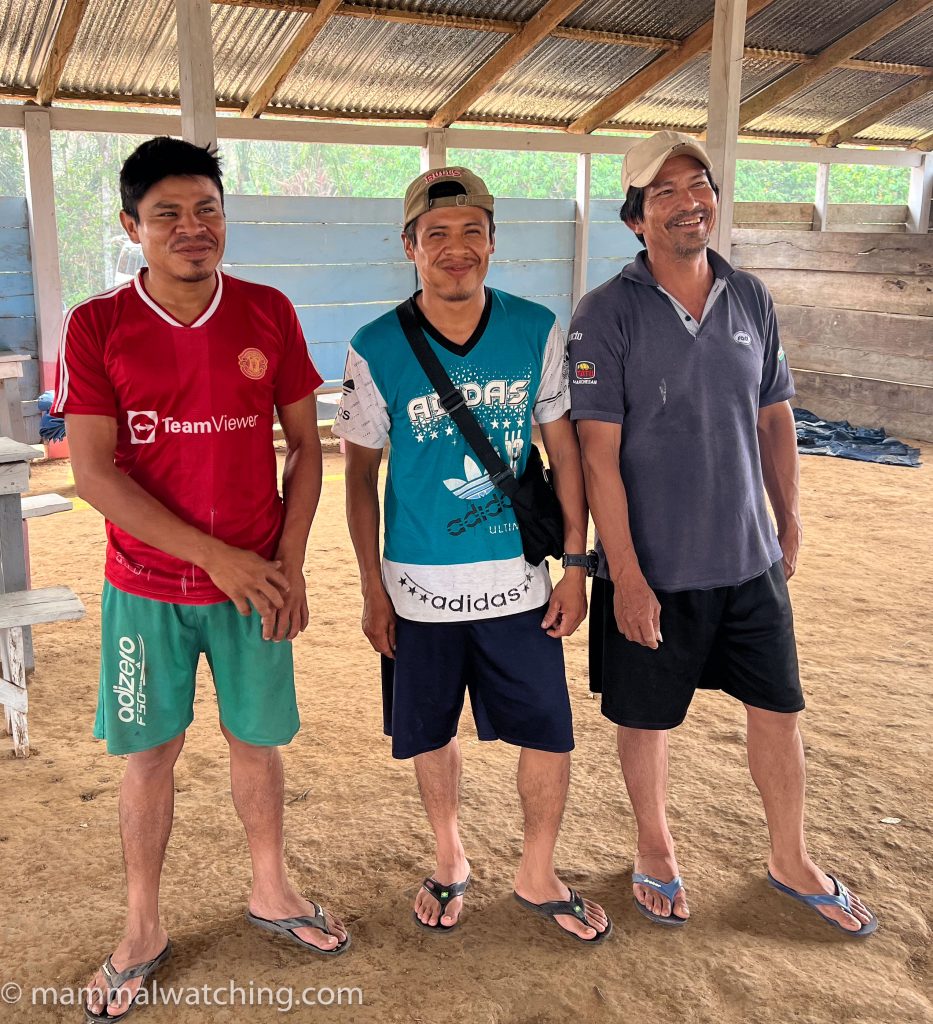
Monte Carlo guides
A big thanks to Nick for all the planning, last minute adjustments and beer!
Our local guides were all excellent, as were the community at Monte Carlo. Thank you too to Ericka in Pando for letting us visit the station and a very big thank you to the wonderful Canela there and the cook. And of course a big thanks to John, Alex, Kevin and Phil for being good company and such good spotters.
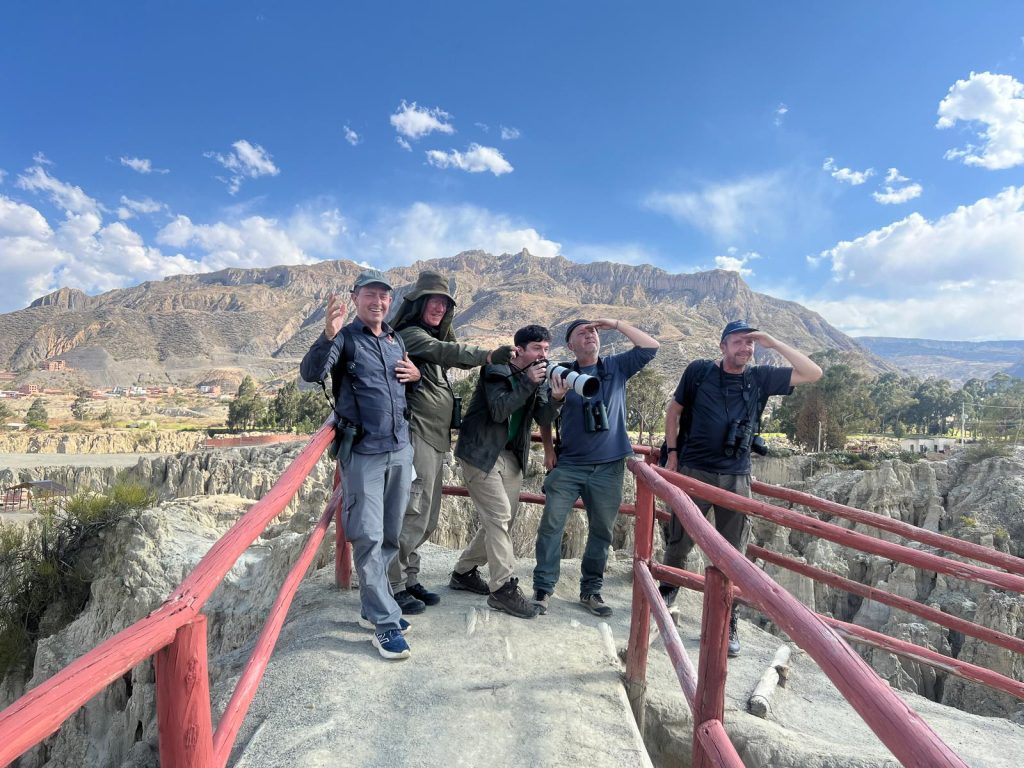
Post author


Leave a Reply
You must be logged in to post a comment.